Nimitz class Aircraft Carriers (1974)
 USS Nimitz, Dwight D. Eisenhower, Carl Vinson, Theodore Roosevelt, Abraham Lincoln, John C. Stennis, Harry S. Truman, Ronald Reagan, George H.W. Bush (CVN-38-77, built 1969-2009), all in service.
USS Nimitz, Dwight D. Eisenhower, Carl Vinson, Theodore Roosevelt, Abraham Lincoln, John C. Stennis, Harry S. Truman, Ronald Reagan, George H.W. Bush (CVN-38-77, built 1969-2009), all in service.
Cold War USN Carriers:
Essex SBC-27 class | Saipan class CVs (1945) | Midway class | USS United States | Forrestal class | Kitty Hawk class | USS Enterprise | Nimitz class | Gerald Ford classAssault Carriers:
Iwo Jima class | Tarawa class | Wasp class | America class | SCS class | VSS classSpecial 4 of July ! The Nminitz-class nuclear-powered fleet carriers really constituted the backbone of US Navy for the last decades of the cold war. In 1990 when USSR fell, ending the cold war (as most thought) the USN had five, one for each major fleet: USS Nimitz, Dwight D Eisenhower, Carl Vinson, Theodore Roosevelt, and Abraham Lincoln. Three more were under construction, five more would be built total until a new design change brought the Ford class. Ten aircraft carriers built over 41 years, whereas only 16 years separated the Nimitz from the Forrestals. That’s how much trust went into the design. There was a lot of debate in the 2000s over a successor, notably because of some critics.
Origin and Developement
Barely three years had passed since the USS Enterprise, first ever nuclear aircraft carrier was commissioned, when it was decided to start work on a new serial “production” based on a couple of the new A4W reactors in development, much more compact. These were driving four propeller shafts and procured the needed 30 knots (56 km/h; 35 mph) fleet speed, based on an approximative 260,000 shaft horsepower (190 MW). One key criteria was that they were to be capable of 20 years continuous service without refueling and were planned for a service life of over 50 years, so some modularity was integrated in the design. This the serie was given the “N” (for nuclear) to distinguish their serial, from CVN-68 to CVN-77.
Design Prelude: Enteprise and JF. Kennedy designs
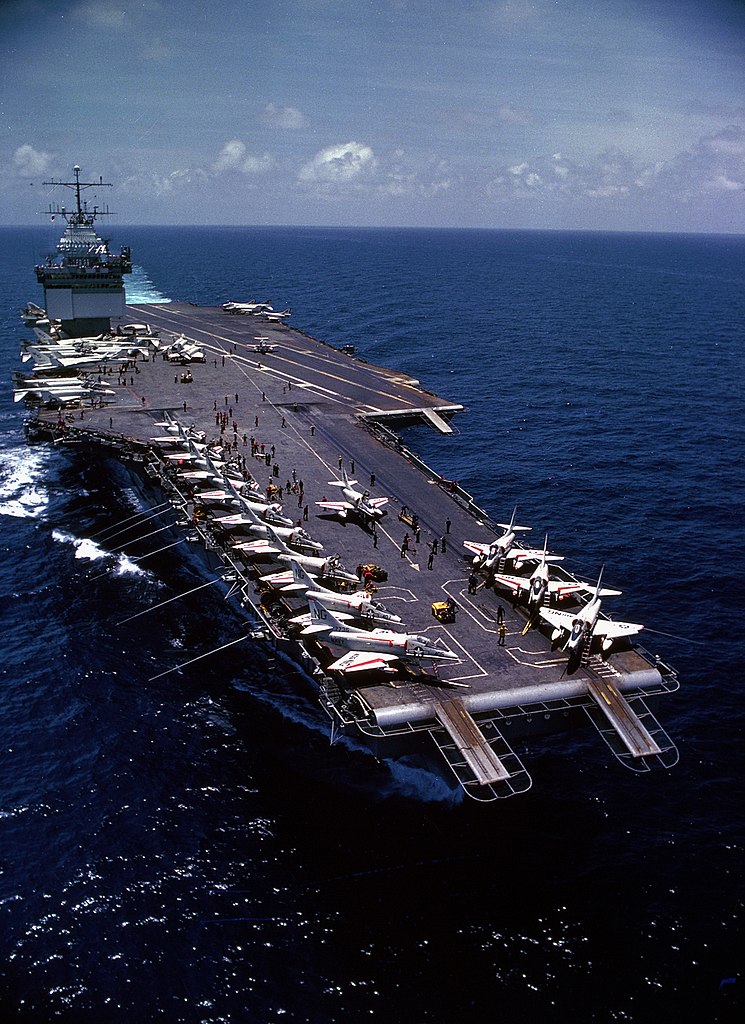
USS Enterprise (CVAN-65) in the Gulf of Tonkin in 1966. She proved too costly to have sister ship.
During the “nuclear craze” there always had been a plan in the 1950s to built a fleet of nuclear-powered aircraft carriers, protected by nuclear-powered cruisers, destroyers and frigates. But the reality of nuclear reactor operations, notably gradual bans in many ports around the world as well as some technical and fincancial issues eventually curtailed these plans. USS Nautilus was the forebear of all contrmporary SSNs and SSBNs and was found well-adapted to a new sets of missions developed for the “silent service”. But for the surface fleet, this was another matter entirely.
The construction at a simultaneous time of USS Long Beach and USS Enterprise and the first years of service shown that both were way too costly to operate. Both became showcase prototypes and little else.
Indeed, a new generation of nuclear powered cruisers usable as fleet escorts were built in the 1970s: The two California and four West Virginia, but they were based on the much smaller conventional Leahy-Belknap design instead. It was about the same for USS Enteprise (CVN-65). It was largely over-budget, costly to operate, had a fragile, cumbersome and overall too ambitious radar, so it was obvious that this was not he solution for a serie of sister-ship. Not all lessons were lost and in the 1965-1968 preliminary design phase (the final design was approved in 1969) for CVN-68, the starting point was essentially a slightly reduced USS Enteprise.
The other alternative were the last pair of the Kitty Hawk class carriers. The last two were indeed planned as nuclear-powered sister ship at first, in fact, copies of the CVN-65. CV 66 and 67 however due to ballooning costs during early construction caused a cancellation of CVAN-66 and CVAN 67. The first was reordered as a conventionally powered Kitty Hawk-class carrier, soon renamed USS America. The second was delayed further back to test improvements earned from the early Kitty Hawk service and other ideas and ended as her own separate class, USS John F. Kennedy. She was probably the best conventional carrier ever built in the USN.
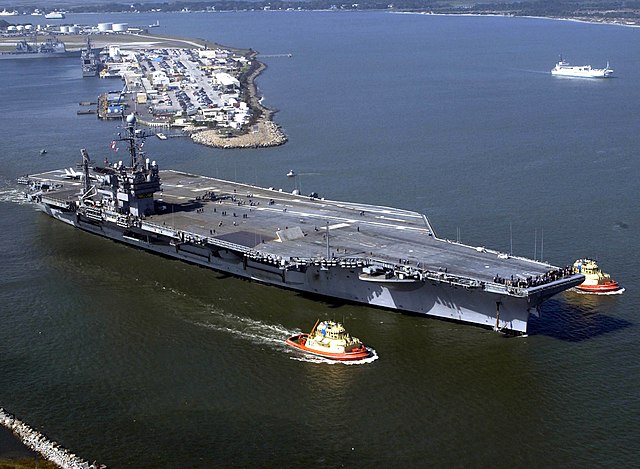
USS JF Kennedy in November 2003. She was in large part inspiring for the Nimitz design
But in the Navy some considered her potential for conversion. This led to the design of a new class. The basic design was indeed large enough to house nuclear plants after some redesign, while being smaller and cheaper than CVN-65 by a fair margin, and still keeping all their supercarrier assets married on the best design ever in the USN (called by most authors the “Kennedy sub-class”). Eventually, this plan was also dropped as there were way too many issues which needed an enlarged hull anyway. Now, before going into more detail about the design, it is fair to say that plans even of 1968 of the Nimitz class are still off-limits for security reasons. None would be shown there but only author’s reconstitution of the Nimitz and Washington sub-class.
Finalization of the design 1968-69
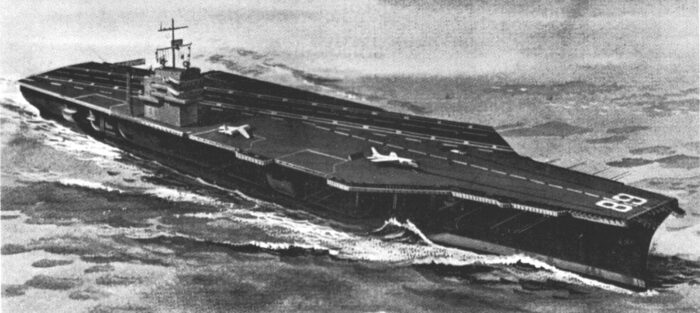
Artist’s impression of the Nimitz class in 1968
In 1968 for context, the Vietnam war was entering officially its fourth years and a massive amount of troops were already there fighting with more mobilized. Finciancially the war started to represent a real burden, weighting in all military spendings. The Navy and the Air Force were also fully mobilized in this endeavour which started to be contested by the general public. The NVA Têt offensive which started in January and went on until September came a schock for the public opinion, which started to shift.
Reorganization of the Design Team
Meanwhile in the Pentagon and at NAVSHIPS, discussions about the new supercarrier design to be serially-built went on. BuShips was indeed abolished by DOD Order of 9 March 1966, an overhaul effort of the bureau system, by the Naval Ship Systems Command and from 1974 the Naval Sea Systems Command (NAVSEA). The design teams were however partly rejuvenated, with the oldest cadree still in place. NAVSEA also merged with the Naval Ordnance Systems Command (NAVORD), successor to the Bureau of Naval Weapons and earlier Bureau of Ordnance.
Fundamentals of the design
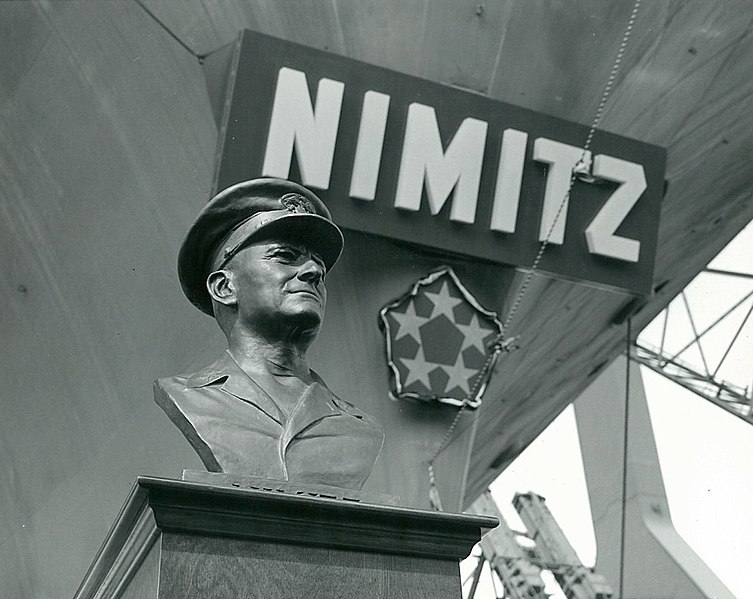
Nimitz launch ceremony. She was christened by the widow of the famous admiral. She was the only one of her class to be named after an admiral. The remainder went for the traditional presidents.
The Nimitz-class were ordered to supplement the Kitty Hawk class while being cheaper than the Enterprise class, as to maintaining the U.S. Navy after the decommission of the legacy carriers on the long run, meaning the last of the Essexes, and the three Midways, but also FY1990s, the Forrestals. Teams did not work on a blank page but tried to make a fusion between the Kennedy’s improvements and the main assets of USS Enterprise (mainly the powerplant and large avgas bunkerage), while keeping the same, proven general arrangement of the Kitty Hawk class. So in short, the design did not started from a blank page and was certainly less risky and ambitious than the design of the Forrestal class back in 1950.
A new Powerplant
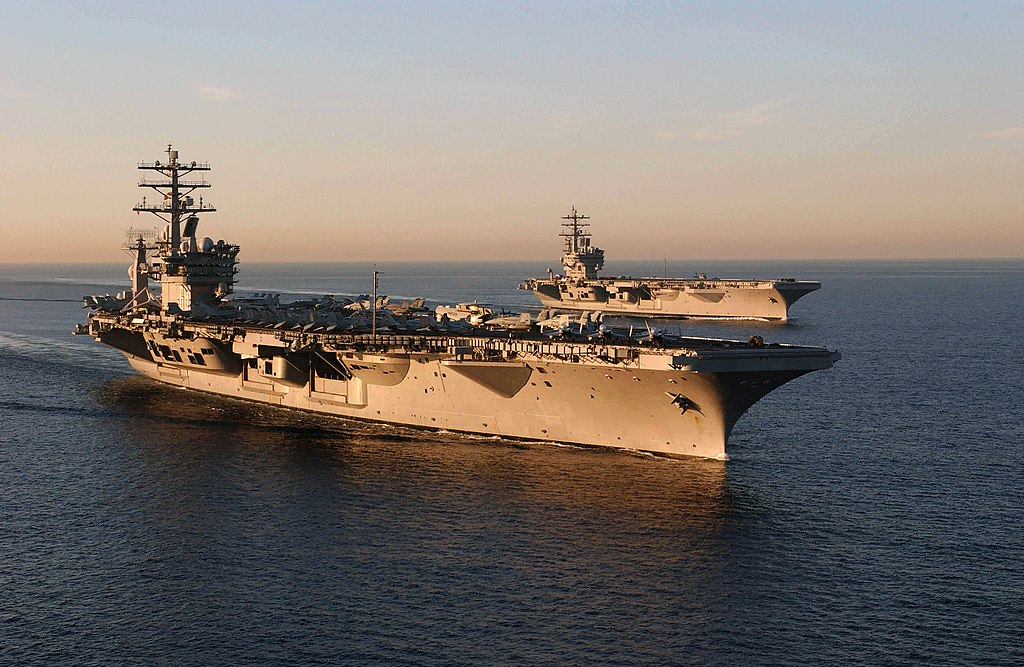
One the first improvements was directed at the powerplant. To make the new ships a bit smaller, thus cheaper, the two reactors on Nimitz-class carriers were of a brand new generation proposed by Westinghouse, instrumental in this design as they took up less space than the eight reactors used on USS Enterprise.
These were the new A4W reactors. The name meant in order “Aircraft (carrier platform)”, “4th core design generation” and “W for Westinghouse”. These were nuclear fission pressurized water reactors (PWRs) designed at the Bettis Atomic Power Laboratory, Knolls Atomic Power Laboratory but built by the Westinghouse Electric Company. They were rated for 25 years between core refueling and were rated at 550 MWth each to produced a combined 140,000 shaft horsepower (104 MW) for each pair of the four shafts, and an additional 100 MW of electricity for onboard systems, notably electronics.
The extended range was linked to the need of supporting the U.S. military during the Cold War, which imposed nuclear power instead of conventional one, for greater endurance. This was the best solution for blue water navy operations even if that meant reducing the number of harbours that tolerated them. The design was also modulat enough to procure the ability to upgrade the weapons systems and sensors, based on the latest intel and technological developments. There is a lot about the new radars compared to the Enterprise’s indeed. See later. What could not change was the electrical ouptut, delivered by this new powerplant. It needed to integrate future demands right from the start, not to power only existing systems in 1968, which implies power surplus.
More Fuel and Ordnance than ever
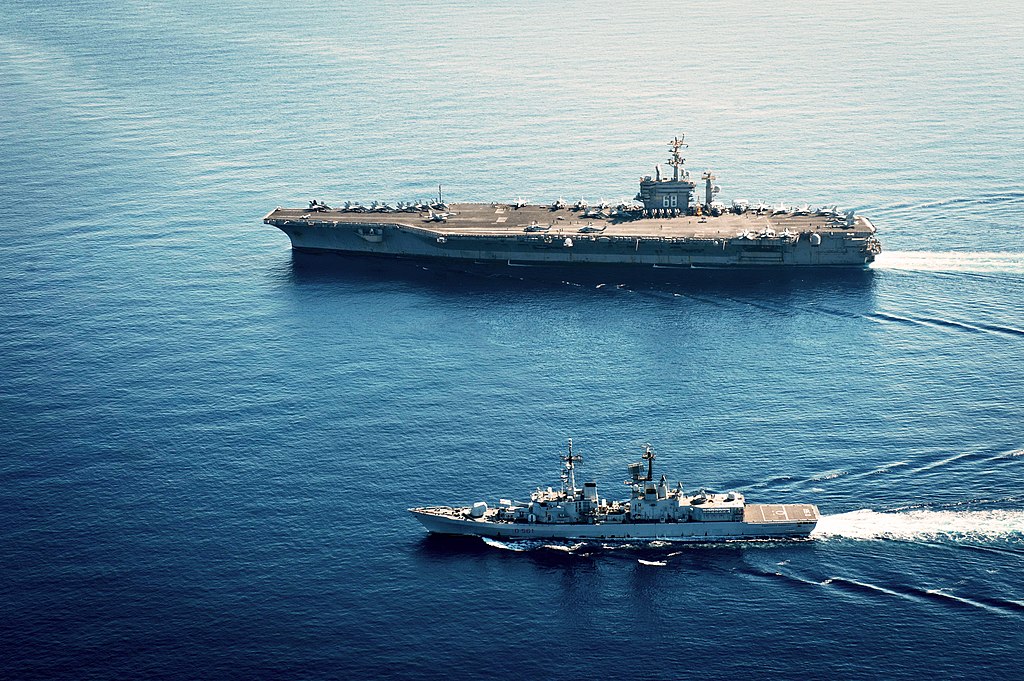
Compared to both Enteprise and Kennedy, nearly all aspects of internal space distribution was thought throught and improved. Bunkerage space for example was pushed even further, while still being safer than ever. In the end, the new design carried an amazing 90% more aviation fuel and 50% more ordnance than the Forrestal class, three generations before but barely after 15 years of design thinking. That was nothing less than remarkable, although it doesn’t shows externally.
This increase was a direct result of Vietnam War experience for the USN: Certain aspects were influenced by prolongated, intensive daily operations which urged the need for increased capabilities over survivability. Since this was an asymetric war, the level of threat directly on the carrier was far more reduced compared to the need of making offensive sorties. The new design imposed naturally larger aviation fuel storage, larger ordnance magazines, and this needed increased space, but also free space recovered after the installation of much smaller reactors and a more compact powerplant in general. This was probably the most successful design aspect of the ships, explaining why so many were built and for so long, as long as the electronics could be upgraded.
Again, let’s stress here that only roughly 16 years separated the Nimitz from the Forrestals (1952-1968), but the Nmitz were built over 40 years… This shows how much trust was put into the new design, a standard that was mature indeed so to fix carrier design for the remainder of the cold war and beyond. It was really the coming of age of the supercarrier concept for the USN.
Better Protection
Although not “armoured carriers”, since the days of kamikaze were long gone, the new supercarriers were designed to be the best protected, notably against the new generation of soviet sea-skimming missiles. This protection was three fold:
-Passive Protection: Composite (latest gen. of hardened steel and kevlar) to withstand three times any damage to an Essex class in 1945.
-Fire control: Hangars were divided into three fire bays, not separated by curtains but by thick steel doors, which were earl fire-proof doors, sustaining insane amount of heat.
-NBC Protection: Nuclear-Bacteriologic-Chemical, in the atomic age. Every door and hatch was sealed, and a slight overpressure system completed the air conditioning system. The hangar openings and lifts would be completely sealed of after alert, from radio or detectors. There was also a washing system usable also to extinguish fires on the flight deck, able to deliver foam and water in very large quantities to wash over the fallout radioactive dust or chemical compounds. For bacteriologic threats, in addition to a detector, the ship’s own medical faciliies comprised an infection treatment unit with isolation room and sealed laboratory.
Active Protection: It’s the onboard armament of course, the Mk 29 Guided Missile Launching Systems and other installed later, like the CIWS, but also electronic protection: The AN/SLQ-32A(V)4 Countermeasures suite against missiles and SLQ-25A Nixie Torpedo Countermeasures against submarine attacks, as supercarriers were prime targets for soviet SSNs.

Boatswains Mate Seaman Vanessa McClelland stands look-out watch on aircraft carrier USS, Nimitz during Operation Enduring Freedom, 2013.
Design Speciality
These ships are popularly known as “supercarriers”, but it’s more a journalistic term. Internally for the USN they are class as “attack carriers” as air offensive platforms ion the WW2 sense. But they were constructed with anti-submarine capabilities since USS Carl Vinson and in general, since they are the only carrier-capable not amphibious or assault ships, they need to cover a wide range of operations from blockades to mine laying cover or extended missile strikes on land, air and sea through their air group. The naval deterrence mission once confered to the Vigilante was quickly terminated after the Navy/Air Force struggle of the 1960s. It was transferred to the undersea force through SSBNs, but protocols exists anyway to unlock the use of nuclear missiles in wartime aboard carriers.
Construction
All ten carriers were constructed by Newport News Shipbuilding Company in Virginia. USS Nimitz, the lead ship of the class, was commissioned on 3 May 1975, and USS George H.W. Bush, the tenth and last of the class, was commissioned on 10 January 2009. Since the 1970s, Nimitz-class carriers have participated in many conflicts and operations across the world, including Operation Eagle Claw in Iran, the Gulf War, and more recently in Iraq and Afghanistan.
Detailed Design
Hull & Protection
The Nimitz class aircraft carriers reached the symbolic treshold of 100,000 tonnes, not standard but FL. To be exact they ranged between 100,000 and 104,600 long tons (101,600–106,300 t) at full load, for an estimated 85,000 standard. This was more than USS Enteprise (93,284 long tons Full Load) and more than any other carrier that preceded them. To compare, the first USS Enterprise (CV-6) that was so instrumental in the Pacific displaced only 25,000 tonnes FL, so she was four times larger.
Her length was overall of 1,092 feet (332.8 m) and at the waterline: 1,040 feet (317.0 m). This was larger than the kitty-Hawks, comparable to USS Enteprise (CV-65) at 1,088 ft (332 m) befire refit. For her beam however, she measured 134 ft (40.8 m) at the waterline, versus 132.8 ft (40.5 m), and comparable at the flight deck with 252 ft (76.8 m) overall versus 257.2 ft (78.4 m) on CVN-65. Her draft, maximum for navigation was 37 feet (11.3 m) with an extreme limit to 41 feet (12.5 m). Again, this was comparable to CVN-65 at 39 ft (12 m). The overall hull shape was not innovative, as the same prow style was kept, but the rounded poop ended in a cut, flat aft section ubder the flight deck. The latter was hevily sponsoned in a way to support new heavier aircraft (although the limit was already reached with “beasts” such as the Vigilante), distributed in a way to preserve stability even in heavy water and roll to a certain degree.
On that chapter, the Nimitz class were given large counter-keels with an even more pronounced extremity angles and placement to further brake any rolls. The large beam included a boyoyanc reserve with many void compartments that can be filled (which was done in the 1990s with more ballast). The proportions still resembld the USS Enterprise, with the biggest external difference being of course the island, much smaller, since radar technology advances in the late 1960s made CVN-65 installation obsolete. A smaller island brought less air disturbance for air operations notably, and took a smaller footprint on the flight deck, while being lighter, thus avoiding too much compensation on the opposite side, making the ship overall less top-heavy.
A new Island
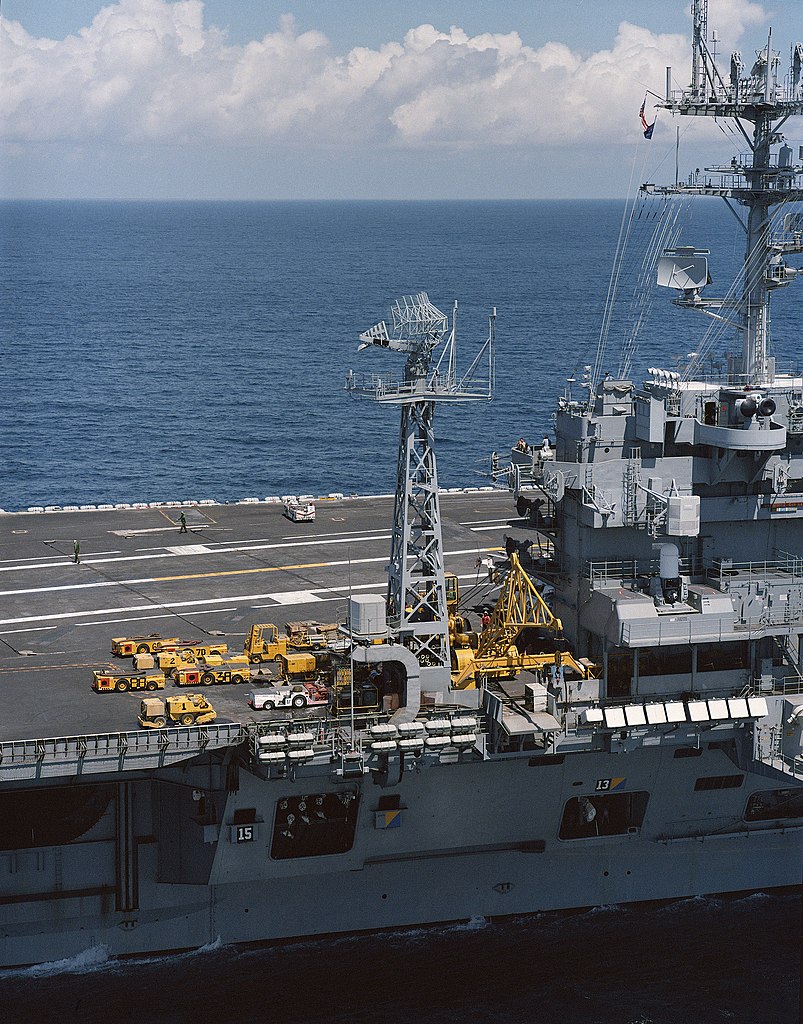
Renouncing the solid radome of the fixed antenna SPS-32/33, it was equipped with mobile antennas SPS-43A and 48. The island was very much inspired by Kennedy’s one. It was located like on previous carriers to the rear of the ship, at the last tier, forward of the afttermost side lift and aft of the two amidships lifts. Behind it was located an extra radar on derrick. It comprised a three-stage base with thermal protection coating against jet blasts, and then two enclosed bridges, partly panoramic, with the navigation and the flagship/command bridge. There was an open bridge above and a double wing with panoramic glasshouse for air operations to the starboard, close to the command bridge. The rear of the island was prismatic in section, narrower aft. The main radar pas was located roughly at its center, composed of three utility platforms for smaller radars and antennae.
Passive Protection

These shorter but larger, a bit heavier ships incorporated a much more effective ASW protection, modeled on that of the USS Kennedy.
-The Nimitz sub-class (CV-68-70) had an estimated protection (it is still classified) of 135 mm for the belt (5.3 in), 45 mm (1.77) for the flight deck, 50 mm (2 in) for the hangar deck and 56 mm (2.2 in) for the main deck.
This armor was later reinforced by kevlar in many places since USS Theodore Roosevelt, 2.5 in (64 mm). Kevlar armor plates were added over vital spaces, and earlier ships have been retrofitted such as Nimitz in 1983-1984, Eisenhower by 1985-1987 and Vinson in 1989. This reinforced protection came in part to the detriment of avgas reserve. After all, the US Navy RAS organization (Resplenishment at Sea) also came to maturation in the 1980s, ensuring safer, more frequent distribution of avgas in any operation.
The fuel distribution in much higher quantities needed the installation of the ASCAC ASAC control coordination system.
Powerplant and Performances
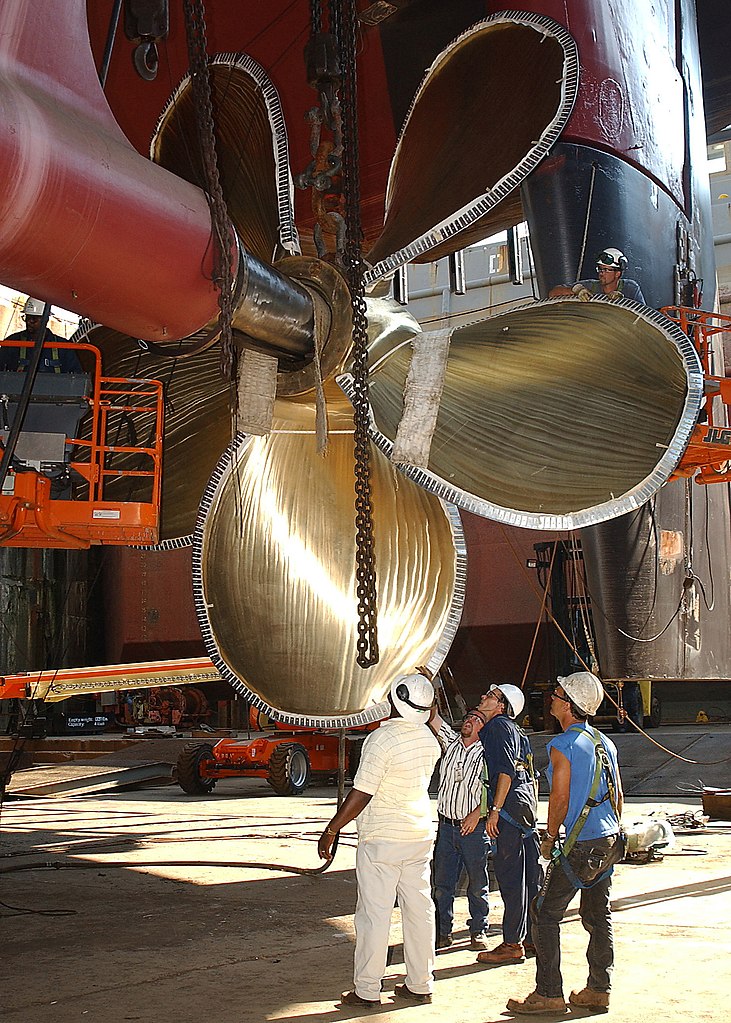
USS George Washington’s propeller
The centerpiece of the powerplant were a pair of Westinghouse A4W nuclear reactors (HEU 93.5%), coupled with four steam turbines (one reactor for each pair), driving four shafts. Total output was 260,000 shp (194 MW). This was supposed to provide not only enough traction to reach a top speed superior to 30 knots (31.5 is often found in references) but also all the electrcical systems, but with a powrrful backup. It should be said thay contrary to clasic steam engines which needed some time to rearch working temperature, nuclear reactors can provide an all-time output on demand.
Top speed was “circa” 30 knots (56 km/h, 35 mph) and more. Meaning 35-38 knots were not out of question of needed, but there was a governor and a set of safeties to not overheat the whole plant. There was a reserve of power for any use in any case. The other advantage of the plan was of course the range, which was unlimited in distance, until the cores were depleted and needed repacement every quarter of century (20–25 years depending on their state).
In fact a whole article has been written on the topic of the supposed “max speed” of a Nimitz class.
One urban myth pretends it could be as fast as 50 knots (92 kph), and only is limited by officer’s vigilance. The top speed, “in excess of 30 kts” is classified and by anology of former carriers capable of 33 kts tells a likely figure. A simple power/tonnage ratio and analysis of the hull however make it clear the Nimitz class was geared for 31 knots. Which seems the reasonable and realistic limit today.
After all the goal is no longer to out-run soviet subs as they are likely to send missiles well before approaching for the torpedo attack, whereas at the age of hypersonic antiship missiles a knot of difference in top speed changes absolutely nothing. The days a carrier’s captain would be called one day to dramatically order a hard rudder turn to avoid an incoming ordnance are long gone. Top speed is not meaningless but just a standard for fleet operations and nothing else. It gives at least a way to plan fleet movements on the map, ensuring no ship of the CSG is left behind…
SLEP and Major Refuelling-Overhaul
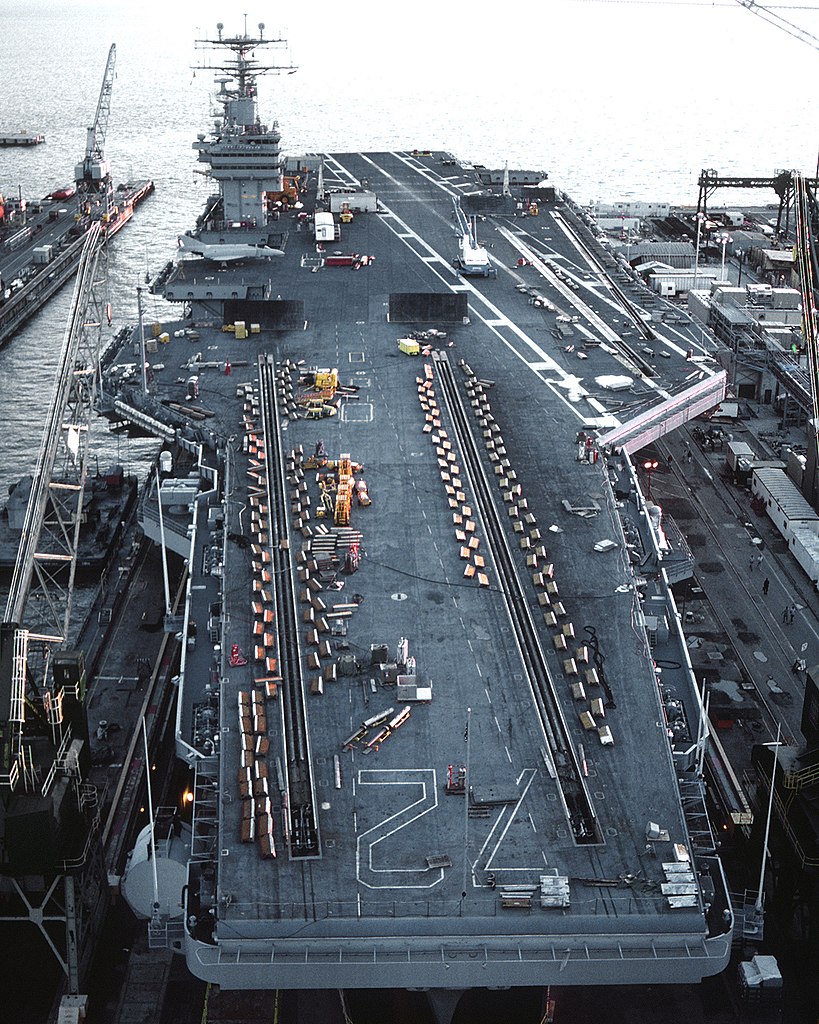
This was combined with a major overhaul, with three or four up to six years in drydock:
The first undergoing this drydock time was USS Nimitz, which was done between 1998 and 2001 (coupled with the SLEP -service life extension program-) followed by USS Dwight D. Eisenhower (2001–2005), Carl Vinson in 2005–2009, Teddy Roosevelt on 2009–2013, Abraham Lincoln in 2013–2017, George Washington in 2017-2023 and John C. Stennis from 2021 (current). These are long process alternated between ships. These imposes air groups to be ventilated on other ships not to loose their training edge, as the crews. Over time, given the number of issues found with the design, these SLEP became more thorough and extensive. Parts were not only inspected but changed entirely, like the propellers, anchor chains, all systems and sub-systems including electronic suites, radars, weapons systems, electrical network, generators, compressors, piping, seals, and air conditioning system among others. It was the occasion of a standardization to the latest level, including all changes ported on sub-classes and practically on any new ship.
Defensive Armament
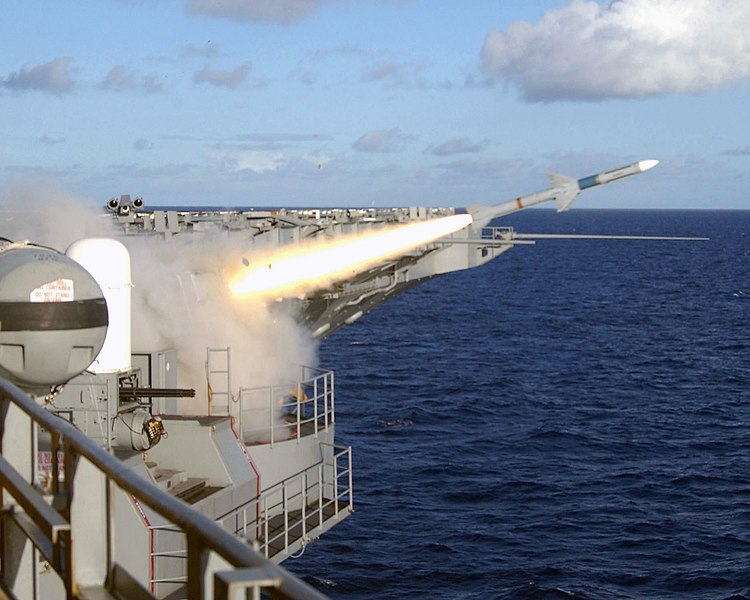
It changed over 40 years. In 1967-68 few were advocating the presence of cannons for any purposes. Missiles were envisioned from the start, comprising at first the following:
-Two RIM-7 octuple Sea Sparrow launchers, on the two forward angle sponsons (24 RIM-7), three from CN-70. The Sea Sparrow is a naval variant of the air-to-air missile.
It is Semi-active radar homing missile powered by a Hercules MK-58 solid-propellant rocket motor at 4,256 km/h (2,645 mph), short range at 10 nmi (19 km), proximity fuzed, using an expanding rod with 27 ft (8.2 m) kill radius.
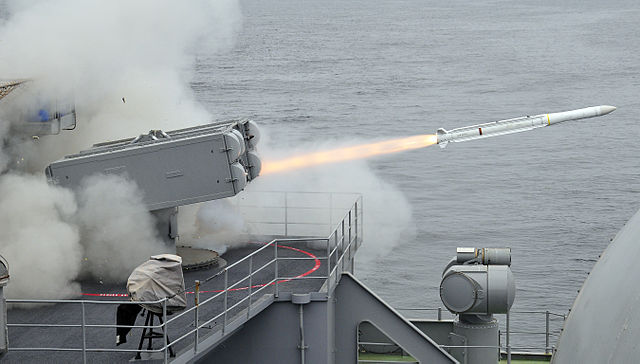
-Later RIM-162 Evolved SeaSparrow: The Mk 29 launcher enabledg an aircraft/missile capability. The RIM-162 ESSM was retofitted from the 2000s (introduced 2004). This is a Mach 4 missile using mid-course update datalink and terminal semi-active radar homing (Block 1) or dual semi-active/active radar homing (Block 2) with a far greater range of 27 nmi+ (50 km+) and carrying a 86 lb (39 kg) blast-fragmentation using a Proximity fuze.
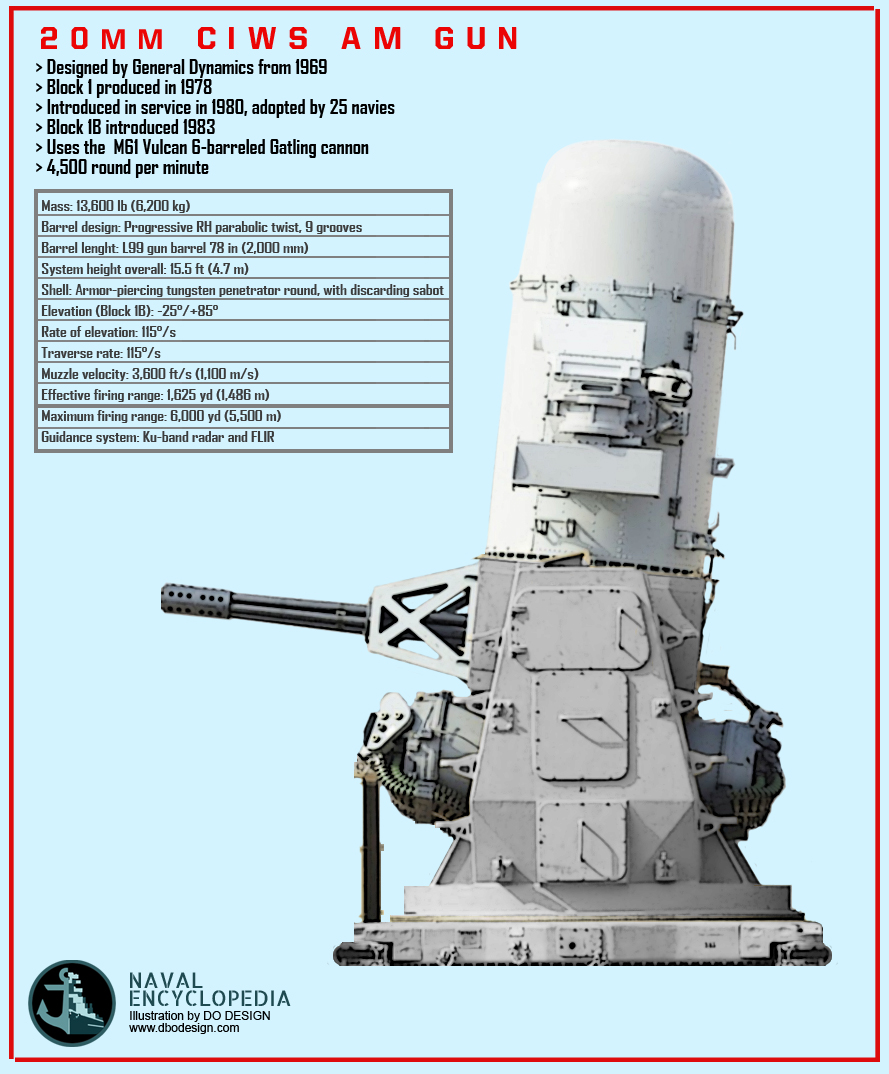
3-4 20 mm Phalanx CIWS. They were retrofitted from 1983-85 on the first three carriers. The three were 6-barrels rotative 20mm/76 Mk 15 Phalanx models. More on the naval gun encyclopedia.
It seems almost anecdotal, but the development of asymetric warfare and notably the use by the Iranians (and other countries) of fast attack boats and kamikazes that could not be dealt for by more complex systems like the Phalanx CIWS were answered by the installation of Four 12.7mm/90 Browning M2HB on sponsons, on strategic location to cover the ship’s close dead angles. This was done on USS Nimitz in 1998 and the others soon.
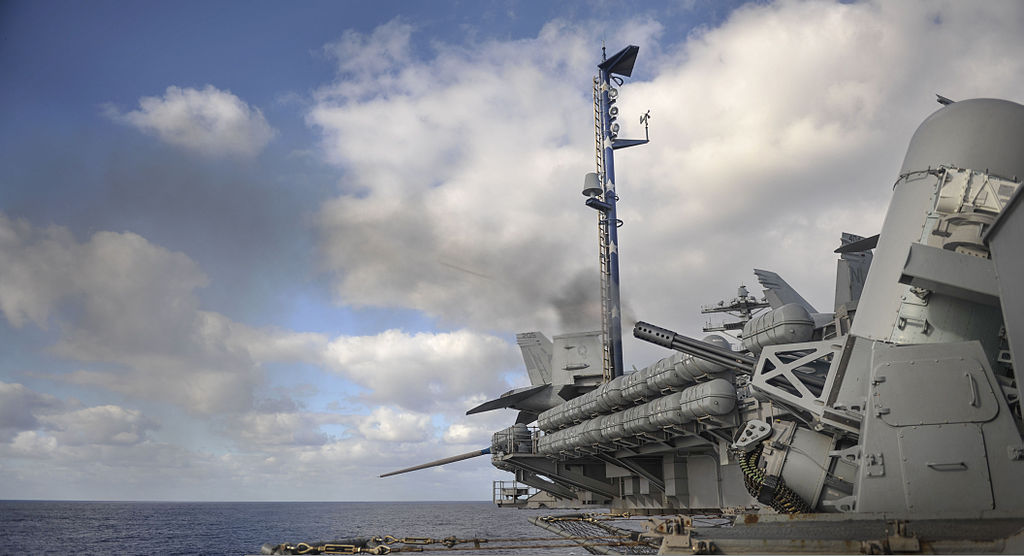
CIWS Firing in a 2013 exercizes in the pacific
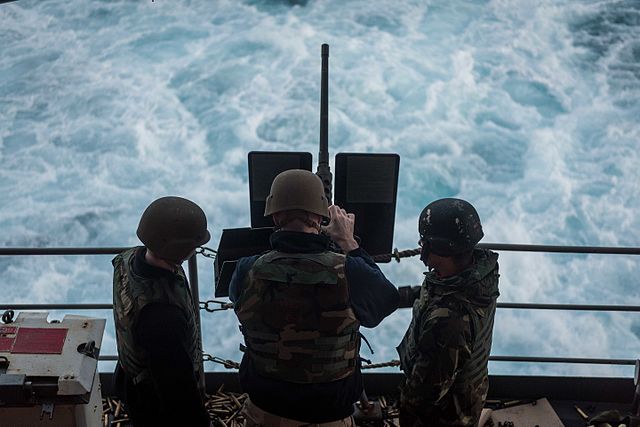
The good old “Ma Deuce” is generally installed on two posts to deal with incoming fast boats on all Nimitz-class carriers. The crew is regularly trained to use it, as well as small arms like the M16.
Sensors
Nimitz sub-class

SPS-43 Radar (here on USS Hornet).
The previous SCANFAR (AN/SPS-32 and AN/SPS-33) was a technological advance, buty proved too fragile and cumbersome. It was replaced on the Nimitz class on the first two ships, CVN-68 and 69, of the LN-66, SPS-43A, SPS-48, SPS-10F, SPN-42A, SPN-43B, SPN-44A radars. This was completed by six Mk 91 radars for the sea sparrows. For electronic active protection, the SLQ-29 ECM suite. Later in service were installed four Mk 36 SRBOC decoy rocket launchers. The ship aslo comprised the NTDS, and ASCAC CCS systems.
The next CVN-70 (Carl Vinson) had the same but four Mk 90 radars associated to the CIWS anti-missile guns. Both were later retrofitted on CVN-68-69.
The SPS-43A Located on the aft derrick mast, was an old (1961) model, still dependable, 2D Air-search radar working on VHF at 0.2 GHz. Its main advantage was a range of 250 nmi (460 km). Rectangular it was 41 ft (12 m) long and powered by 180 kW. Virtually present on all carriers in the cold war from the rebuil Essexes to the Nimitz.
The SPS-48 Was the classic “monolith” radar installed forward on the island’s roof. Introduced in February 1966 this 3D Air-search worked on E and F band (2 to 4 GHz) and had a range of 250 nmi (460 km), altutude of 100,000 ft (30,000 m). 17 ft (5.2 m) by 17 ft 6 in (5.33 m) in size it could elevate to 65° and had a precision of 690 ft (210 m) in elevation, powered by 35 kW in average.
Theodore Roosevelt sub-class

SPS-48 on USS T. Roosevelt
Externally the T.Roosevelt exchanged the derrick mast for a rigid structure. The island was slightly modified also. Morevover, the sub-class T.Roosevelt are considerably improved in terms of self-defence with the adotpion of Kevlar over all vitals, and a better hull protection in general at the cost of a reduction in aviation ordnance down to 1,954 tons.
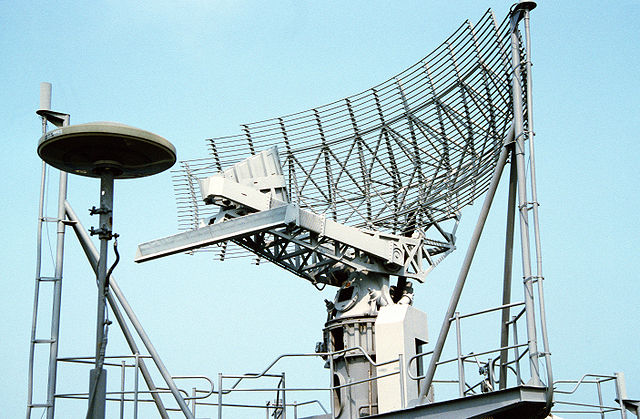
SPS-49 on A. Lincoln
CVN-71 had a modernized electronics suite comprising the SPS-49(v)5, SPS-48E, SPS-67(v)1, and two SPN-42A, plus the SPN-43B, SPN-44, SPS-64(v)9, SPS-73. For the armament, six Mk 95 (SAM), four Mk 90 (CIWS), the Mk 23 TAS radars. For electronics warfare, the SLQ-29 ECM suite, eight Mk 36 SRBOC decoy rocket launchers, and the SLQ-25A torpedo decoy. The array of electronic warfare and utility systems comprised the ACDS, JDTS, POST, CVIC, NTCS-A, and ASCAC CCS. It was more extensive than for the CVN-68-70 group.
The SPS-49 (photo, here on A.Lincoln) In service by 1975 was a 2D Air-search radar working at L band 851–942 MHz at a 3 nmi (5.6 km) to 256 nmi (474 km) range for the latest version, and in altitude up to 150,000 ft (45,720 m). It measured 24 ft (7.3 m) × 14 ft 3 in (7.3 m × 4.3 m) and had a precision of 1/16 nmi range, 0.5 deg azimuth (SPS-49A(V)), powered at 360 kW peak, 13 kW average (AN/SPS-49A(V)1).
Reagan sub-class
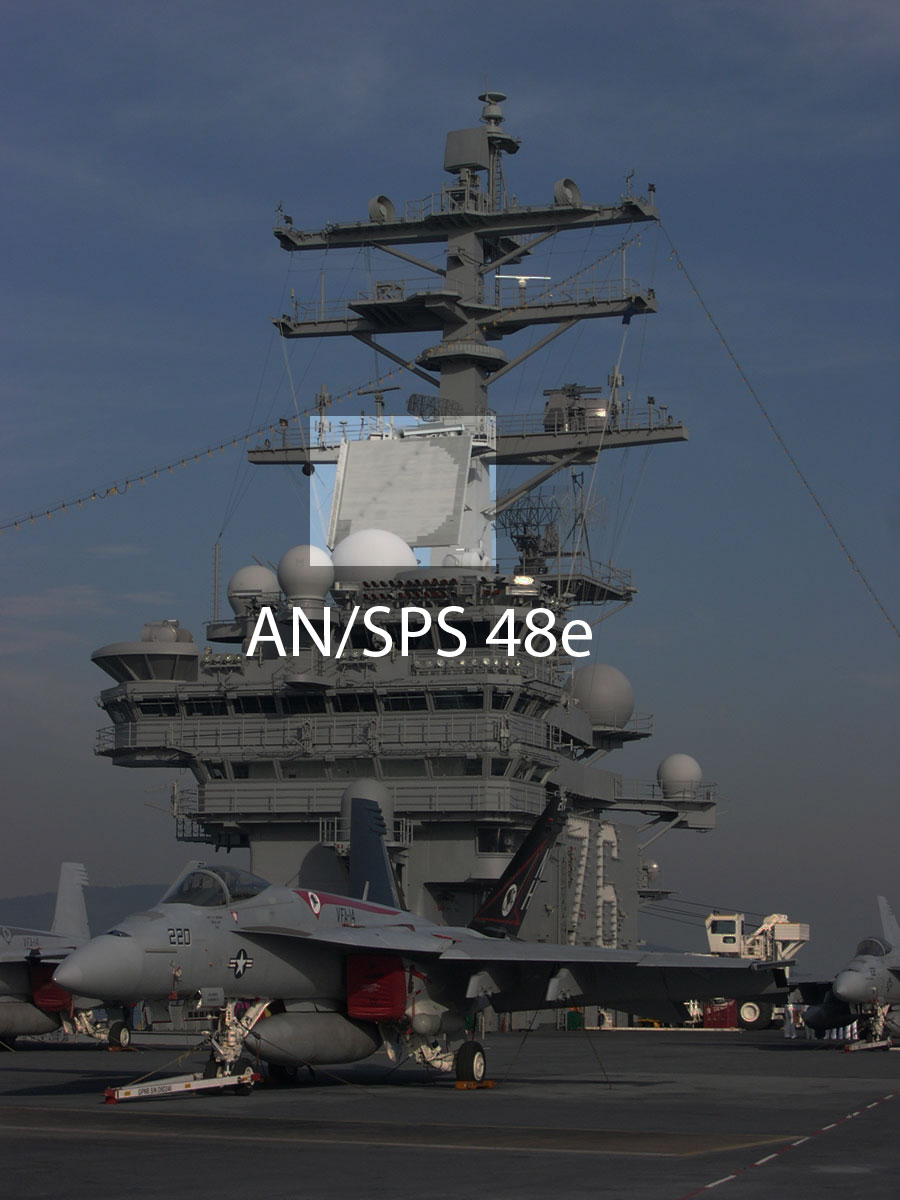
SPS-48E on Ronald Reagan.
The most important external difference from the Ronald Reagan class was the inclusion of the 2D aerial radar on the island, but CVN77 also is the first with integrated information systems, open-system architecture for computers and combat systems. I also has fiber-optic cabling, zonal electrical distribution, multifunctional embedded antennas, improved air-conditioning systems, better berthing facilities. The island is not only one deck lower, but also largely made of composite construction to reduced its weight of 30% and improve on stability, and still supporting two mast, includng the rear one, formerly separated on deck. Everything is automatized, more efficient to reduce its lifetime cost from 20% with a crew reduced by 500. The hull is different also by having underwater a prominent 10.4m-long bow bulb (34 feet) to improve hydrodynamic efficience. The flight deck has just three arrester wires and a relocated crash barrier.
CVN76 had the SPS-49A, SPS-48E, SPS-67(v)1, SPN-43B, SPN-44 radars, as well as two SPN-46, SPS-64(v)9, SPS-73. or fire control, four Mk 95, three Mk 90 and SPQ-9B radars SLQ-32(v)4. For EW, she had also the SLQ-20B ECM suite, plus eight Mk 36 SRBOC decoy Rocket Launchers, SLQ-25A torpedo decoy. This was completed by the following systems, CEC USG-2, ICDS, JDTS, POST, and CVIC CCS.
The SPS-49A was a much improved variant of the SPS-49(v)5. The rest was pretty similar to the previous sub-class.
This suite was improved on CVN77 (USS Georges W. Bush) with the new SPS-49A(v)1, but the rest was the same (SPS-48E, SPS-67(v)1, SPN-43B, SPN-44, SPN-46, SPS-64(v)9, SPS-73). As the fire control radars. However the AW suite was upgraded to the new SLQ-32(v)4. The SLQ-25A SSTDS torpedo decoy were also new. The rest was similar.
Mk 36 SRBOC decoy Rocket Launchers Coupled with the Mark 137 launcher (6 fixed 130 mm mortar tubes in two parallel rows). Launched by electromagnetic induction at 75 m/s. One storage bin was available for each holding 12–36 rounds. The system was automatic, coupled with the AN/SLQ-32 electronic warfare suite for rapid reaction.
SLQ-32(v)4 Shipboard electronic warfare suite (Raytheon-Hughes) is still the primary electronic warfare system as the “Slick-32”. The (V)4 was tailored for aircraft carriers, coupling two (V)3 systems (each side) but displayed on a single common computer and console. Scheduled for replacement by (V)6.
SLQ-25A SSTDS torpedo decoy The AN/SLQ-25 Nixie is a towed torpedo decoy, comprising the TB-14A coupled with a shipboard signal generator. It is a safeguard against all known types of wake-homing, acousting-homing, and wire-guided torpedoes.
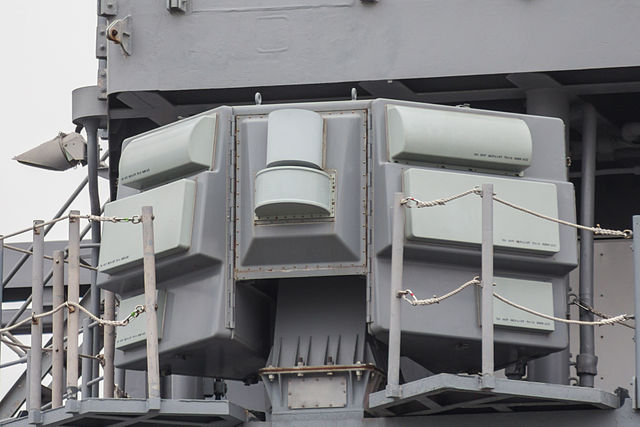
SLQ-32(v)4 EW suite mount
Upgrades
After her SLEP period and in the 1980s, USS Nimitz received the following: SPS-48E, SPS-49A(v)1 radars, SLQ-32(v)4 ECM suite, JTIDS, JDISS CCS (1998) and SPQ-9B, SPS-73(v)12/17, SPN-43C, two SPN-46 radars, the SLQ-20B ECM signal processor and SLX-1 torpedo-protection system (2002).
Air Facilities
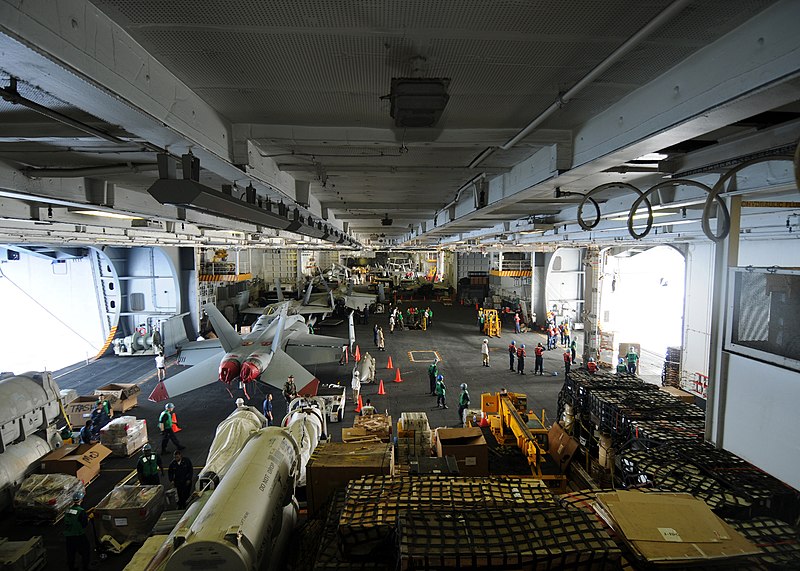
The angled flight deck use a CATOBAR arrangement to operate aircraft, combining four catapults, arrestor wires and even a crash barrier. The hangar had in and out transfer via four side lifts, one starboard, three port, on the more cluttered island’s side. These deck edge lifts weights 47.6t, for 21.4 and 25.9m by 15.9m in size.
The Flight deck’s dimensions were 331.7 x 76.8m (1088 ft x 252 ft) with a total area representing 20,400 m² (219,000 ft²).
The hangar measured “only” 208.5 meters long for 32.9 meters wide and 8.07 meters high (685 x 108 x 26 ft) for a deck surface of 6,860 m² (73,800 ft²) and volume of 55,357 m³ (1,954,000 Ft³). It is capable of accommodating up to 40% of aircraft group depending of the type.
Aircraft fuel stowage for a Nimitz class was 10,220,000 liters of JP-5 jet fuel and the ordnance stowage was 2,970t (6,547,729 Ibs).
This evolved of course. On the sub-class R. Reagan, this was augmented to 12,869,000 liters of JP-5 jet fuel but the ordnance stowage reduced to 1,954t.
Catapults
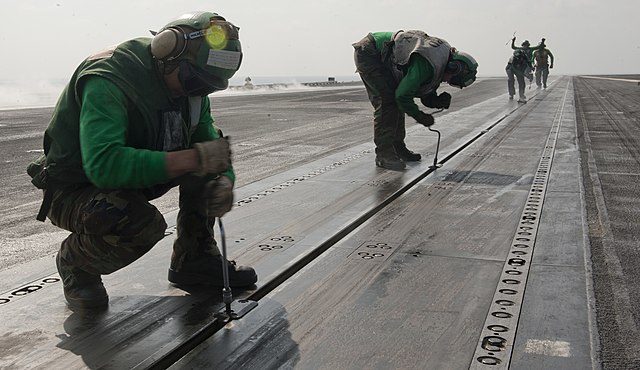
It was composed of four steam catapults, located forward of the flight deck, enabling the near-simultaneous launch of two jets (the heaviest being the Vigilante in 1968), with the extra safety of a springboard ramp at its end. Two more were located at the end on the landing track, on the port side, for alternative launches due to their placement. This enable a four aicraft launch in quick succession. They were all given a folding blast deflector.
From Nimitz to T. Roosevelt these were of the C-13-1 type: 325 feet (99 m) and 310 feet (94 m) (fwd and side), capable of launching 80,000 pounds (36 t) at 140 knots.
On the following Abraham Lincoln to USS Harry S. Truman the C-13-2 type (C13 Mod.2) catapults 325 feet (99 m) and 306 feet (93 m) long, same capacity.
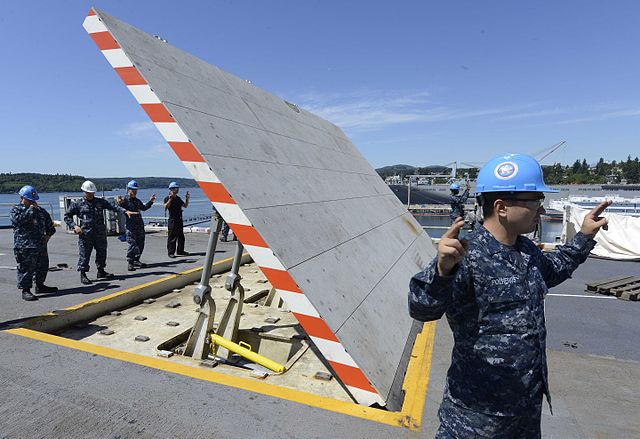
Nimitz’s blast deflector up
Arresting Capabilities
Each carrier had a set of four arrestor wires for landing recovery. They were located on either side of the port and starboard side lifts, installed at an angle corresponding to the landing strip. The winch-brake mechanism was hydraulic-sprung, derived from previous types in service with the Kennedy. They had the same arresting power as the weight launched by the catapults, circa 80,000 pounds. Technically however they usually stopped lighter planes at arrival (less fuel and ordnance). But their largest load was the fully loaded Grumman C-2 Greyhound (15 tonnes empty plus 10,000-pound or 4,500 kg payload rising to max takeoff weight of 60,000 lb (27,216 kg). This was also one of heaviest the type launched by the Nimitz class catapults.
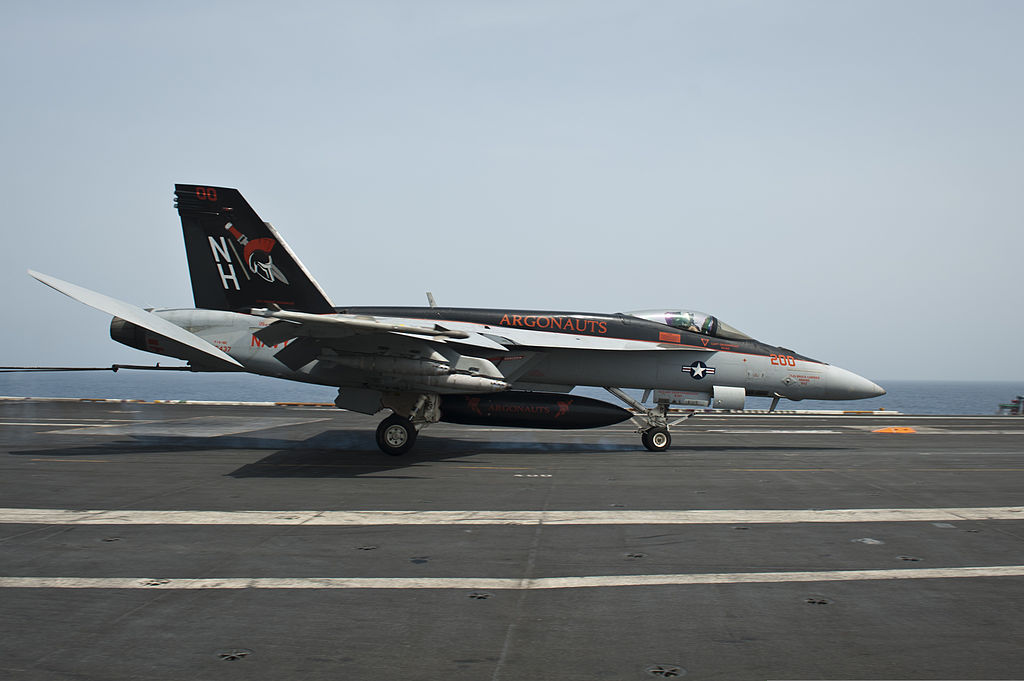
FA18E super hornet from VFA-146 stops after catching a cable on USS Nimitz
In case the four arrestor cables would fail, the arresting crash barrier would be automatically raised. It was located just after the three first cables.
USS Ronald Reagan and George H.W. Bush had only three arrestor wires each, the fourth appearing unnecessary as practically never used. The crash barrier was also put into question but stayed in place: On USS Reagan it was still placed adter the third arrestor wire, but on Bush, in front of it.
Deck Arrangement
If the CATOBAR configuration contributed to speeding up flight deck operations it proved quite versatile, more than on STOVL carriers. The flight deck was angled at nine degrees, found since a decade the best arrangement for maximizing parking, launch, recovery operations in a tight schedule. Combining the forwardmost lifts with the two forward catapults, it also enabled simultaneous launch and recovery. The two port catapults were a sort of addon for larger launches in attack mode. The flight deck angle however was reduced slightly compared to previous carriers. It improved indeed the airflow around the carrier.
Aircraft operations are controlled by the “air boss” in its bridge extension glasshouse. It is used for Primary Flight Control or “Pri-Fly”, having radio communication with the all the deck staff, but also in liaison with the deck management team in the island.
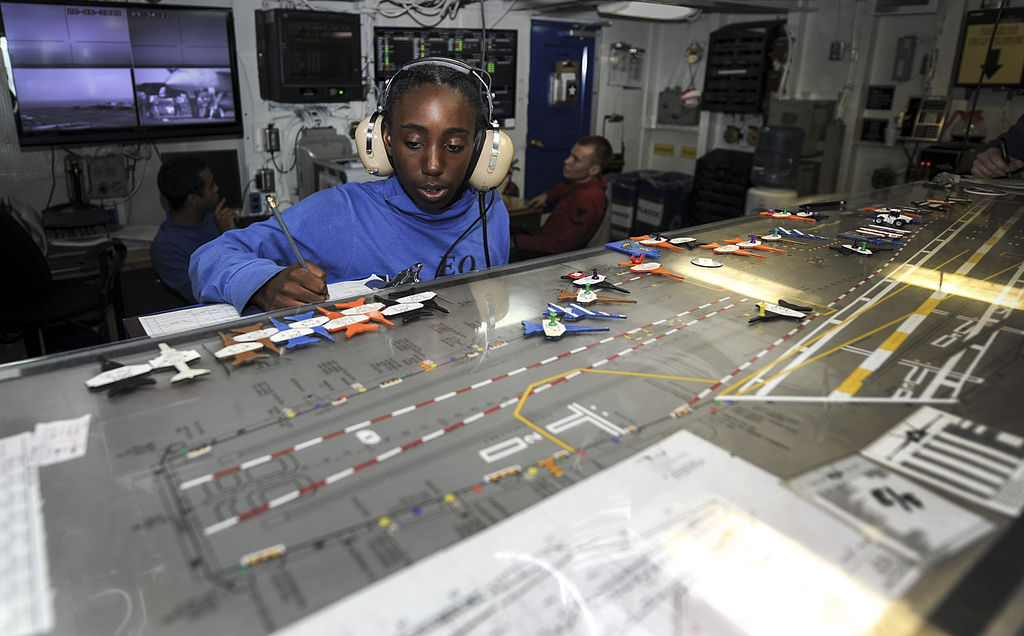
Aviation Boatswain mate Janine Hunt making adjustments on the flight deck control “ouija board”, 2013.
Lifts
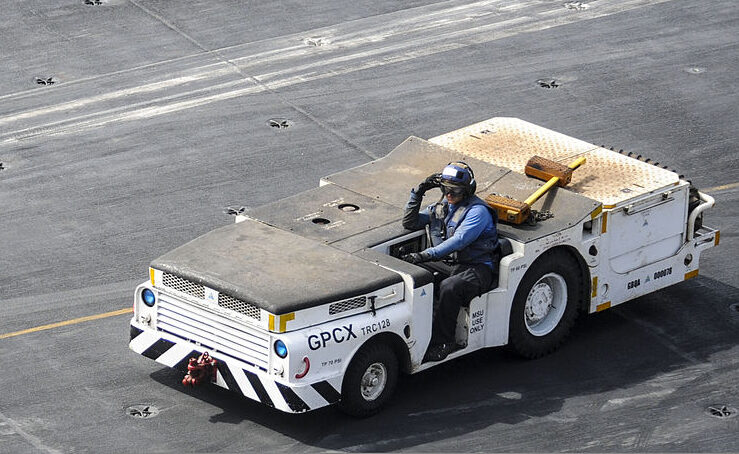
Essential to aircraft management on deck, the standard towing/starter tractor.
Like its predecessor, USS Nimitz and her sister ship had four large side elevators (47.6 tonnes or 104,000 Ibs and 21.4/25.9m x 15.9m or 85 x 52ft) to transport aircraft between the flight deck and single hangar below. The latter as said above was split into three spaced, bays separated by thick steel doors used as fire proof walls. The lifts are located mostly on the starboard (island) side, with a single one port, to feed the two extra side catapults. They were all of the same size, rectangular with an oblique outer edge, accomodating all types in service, wings folded or not. Indeed, they are large enough to park a S3 Viking wings unfolded on its greater lenght, or two A4 Skyhawks. The lift is also supposed to lift 80,000 Ibs. The corresponding hangar doors had the same rounded shape, and could be entirely enclosed by a metallic curtain and reinforcved in case of heavy weather, and sealed in an NBC context. In practice they were left open nearly at all times for hangar ventilation and light.
Air Groups
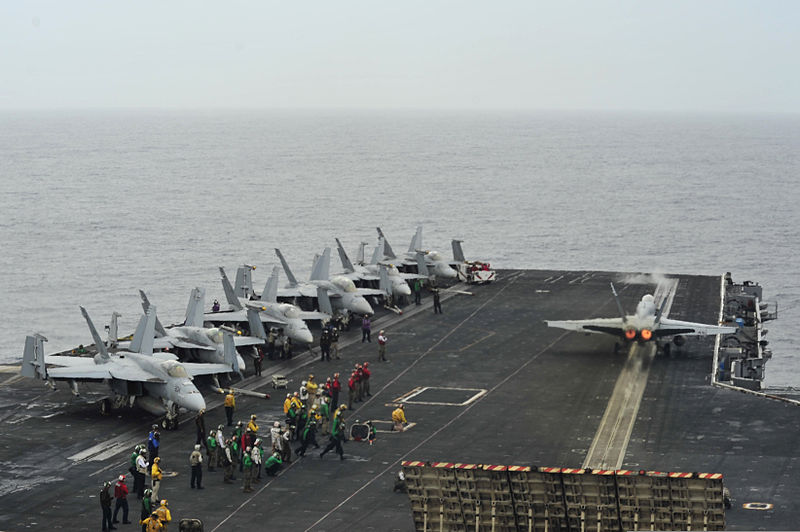
USS Nimitz CAG in 2013
The Nimitz class were designed initially for an aerial complement of 90 aircraft, between the usual hangar provision and deck park. This proved way too large on practice and was reduced to 70 or even 60 in operations. The Nimitz class spawned a total of ten Carrier Air Wings (CVW). It was shown that they could accommodate up to a maximum of 130 F/A-18 Hornets or 85–90 aircraft of different types but in practice the ideal air group was reduced to 64 aircraft.
As a usual practice, these air groups are seen as separate entities and could rotate betwene carriers and geographical assignments as a good practice of experience. This enabled pilots to practice in Northern European waters, Mediterranean, Middle East, US West and East Coasts, and Pacific.
The rotation becomes an evidence when a carrier entered its SLEP pariod, which can last from four to six years. Air crews and associated personal are then reassigned to another carrier not to loose training.
These air wings indeed only comprised a fraction of pilots and cadree. The bulk comprises support personnel for maintenance, ordnance handling plus emergency procedures. The pesonal of the flight deck is also part of it, and wears color-coded clothing for role assignments, making it also easier to spot for the management operator from his bridge’s glasshouse.
The composition of the air group changed considerably over time of course, over 40 years.
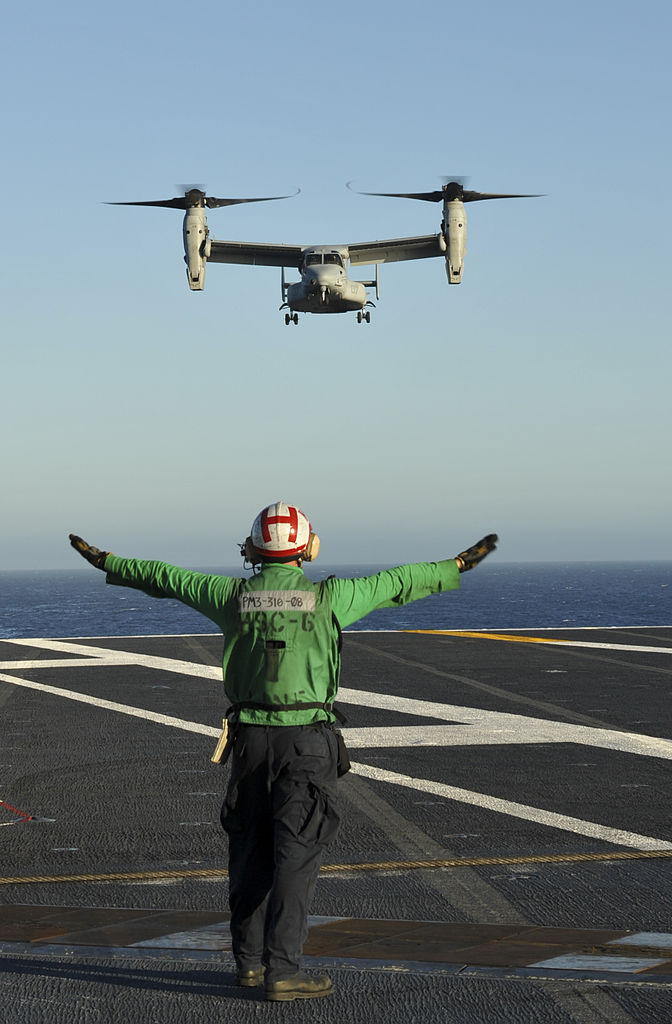
V-22 Osprey landing on USS Nimitz. The VTOL bird is planned to replace the C2 Greyhound cargo plane.
Early Period (1970-80s):

Author’s illustration of the F4J Phantom II, USS Nimitz VF-74 “Be-Devilers”, Mediterranean 6th fleet 1976-77
USS Nimitz in her early days of service operated “vintage” F-4 Phantoms, RA-5C Vigilantes*, RF-8G Crusaders*, F-14 Tomcats, and EA-3B Skywarriors seen on all US supercarriers of the time. By that time, the large Vigilante lost the “atomic bomber” battle and was now firmly entrenched as a supersonic reconnaissance model. *Allegedly, no photo found.
USS Nimitz entered service with a park fixed in 1975 to 24 Grumman F-14A fighters, 24 Vought A-7E Corsair II and ten Grumman A-6E Intruder, but also four Grumman EA-6B Prowler, four Grumman E-2C Hawkeye and ten S-3A Viking for ASW warfare, four KA-6D Intruder for EW warfare and SH-3H Sea King helicopters for SAR. This was quite a diversified array, the “pre-hornet” era.
In the 1980s this evolved for the recon, EW, ECM park to 3 RA-5C or 3 RF-8G, 4 EA-6B, 4 E-2B/C. The helicopter park was rejuvenated to eight 8 SH-3A/D/G/H Sea Kings for all types of missions.
1990 air group
As an interesting note, in 1991, both the Nimitz and T.Roosevelt air groups still comprised 24 F-14A fighter, but this was in complement to 24 F/A-18A alternative to the older A-7E.
For the Teddy Roosevelt sub-class, the usual air group comprised 24 F-14A fighters, but also 24 F/A-18A and ten A-6E for attack, 4 EA-6B and 4 E-2C for recon and detection, the ten S-3A for ASW warfare, four KA-6D and 6 SH-3G/H seahawk helicopter for SAR missions. These were typical of the gulf war operations.
Today’s air groups
When USS Ronald Reagan entered service, the Navy had moved to a more coherent air group unified around its latest ireration of the F-18 Hornet. By 2005, 36 F/A-18C were carried, but still 14 F-14 tomcat kept in complement for long range patrols. The Hornet were fighter-bombers and assumed the attack role, replacing all former models. The “recon” group comprised four EA-6B prowler and two ES-3 Shadow (Viking) for EW, four E-2C for long range detection and patrol. The ASW patrols were still the task of eight S-3B Viking, supply to two C-2 greyhound and the helicopter park solidified around six SH-60 Seahawk. This was the last gasp of the Tomcat.
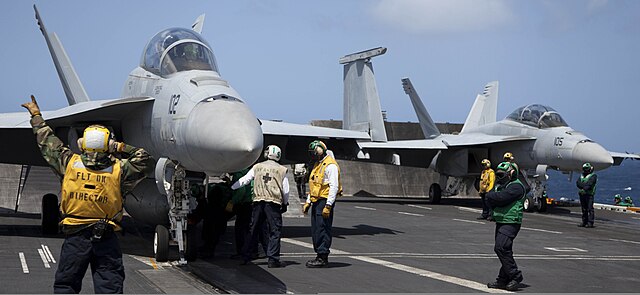
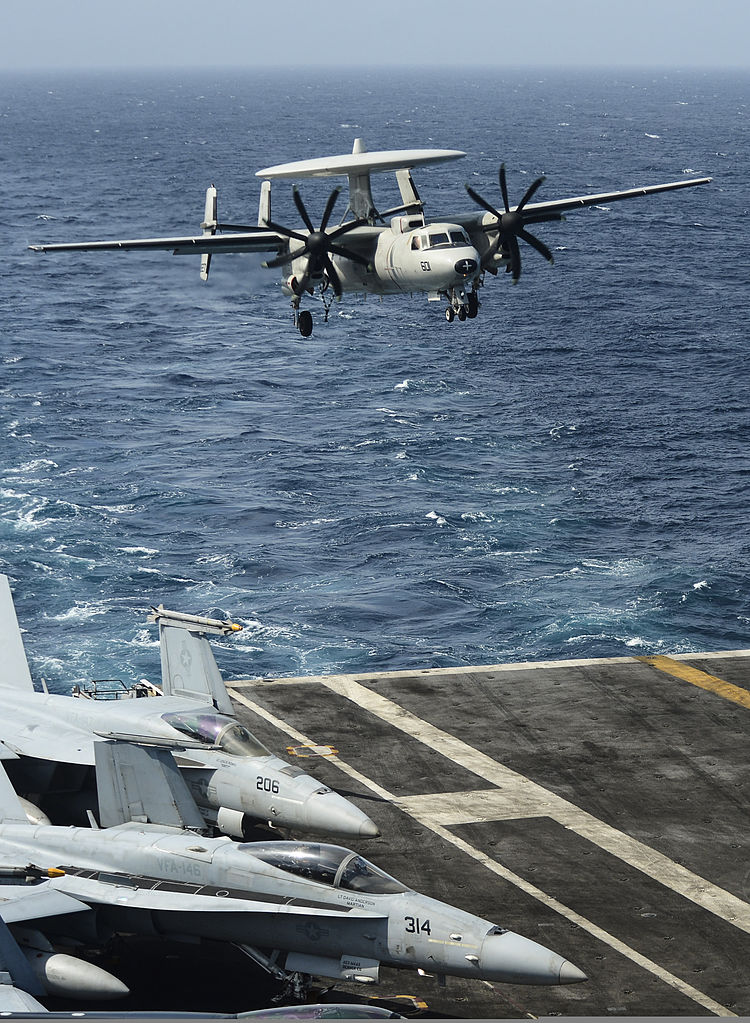
E2C Hawkeye from VAQ-115 landing on USS Nimitz in the south china sea 2013
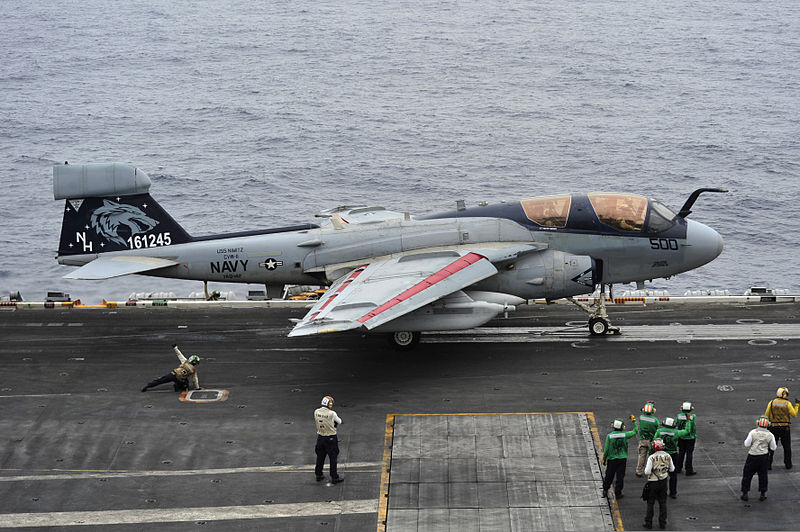
EA6B Prowler from VAQ 142 on USS Nimitz prepares to take off.
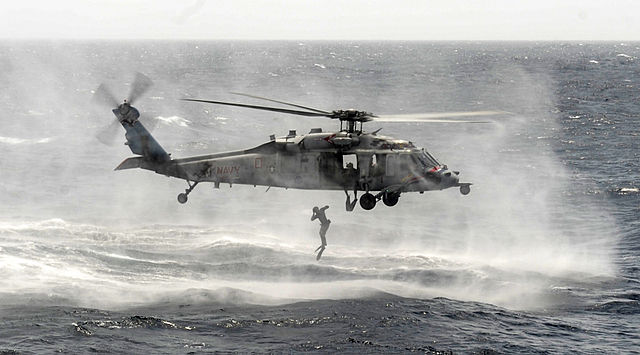
MH-60S Seahawk in a SAR exercise
Gallery (By Tom Cooper)


F14A VF-84 USS Theodore Roosevelt

F-14A Tomcat FV-14 USS Theodore Roosevelt

F14D VF213 USS Carl Vinson, one of the very last active tomcat unit

A6E of VA-85, AA-501
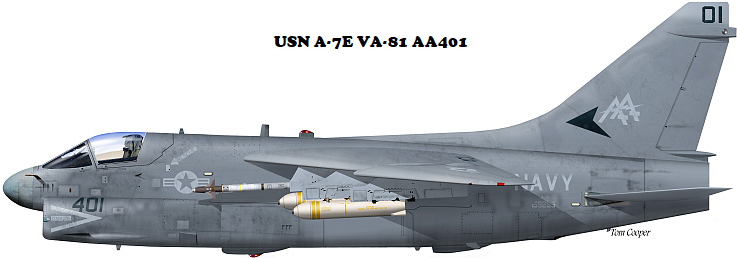
A7E VA-81 USS G. Washington

EA6B Prowler VAQ-141 USS Theodore Roosevelt

EA6B Prowler VAQ 141 USS Georges Washington

E2C from VAW-124, USS Theodore Roosevelt

FA-18C VFA-87 USS Theodore Roosevelt

FA-18C VFA 87 USS T. Roosevelt

EF18G VAS 141, USS Ronald Reagan

FA-18C VF-97 USS Carl Vinson

FA-18C VFA-15 USS T. Roosevelt

FA-18E VFA-31 USS George W. Bush

EF18G of VAQ-141 USS George W. Bush
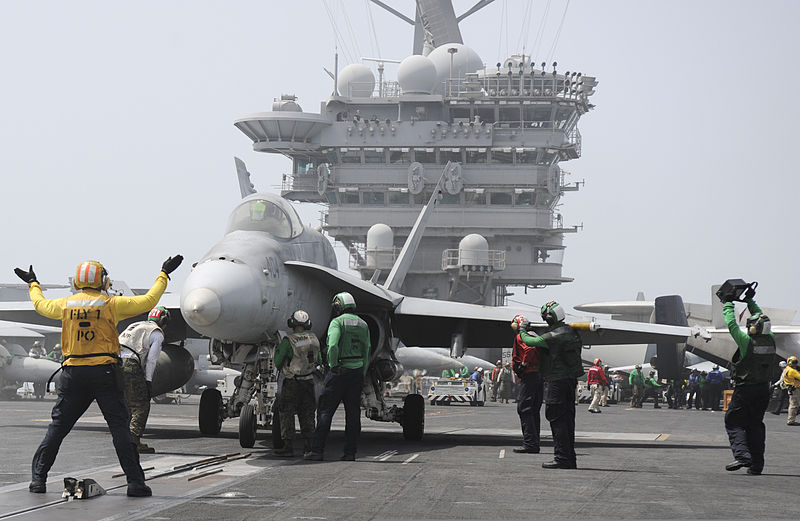
FA18C Hornets from VMFA 323 in the Indian Ocean
A typical carrier air wing today often includes 24 to 36 F/A-18E or F “Super Hornets” (two squadrons of 10–12 F/A-18C Hornets, one often from the U.S. Marine Corps). This is completed yet by another variant of the Hornet, the 4–6 EA-18G Growler used for electronic warfare. Then came four to six E-2C/D Hawkeyes for airborne early warning (AEW). The C-2 Greyhounds is still the dedicated cargo, used for logistics but it is scheduled for repacement by VTOL MV-22 Ospreys. Each carrier also always come with its Helicopter Anti-Submarine/SAR Squadron of 6–8 SH-60F, and HH-60H Seahawks.

Differences between sub-classes
From the Theodore Roosevelt, the new carriers had more advanced radar systems and facilities to operate aircraft more effectively in an anti-submarine warfare role (now the “escort carrier” concept died in the 1980s) and this included the Common Undersea Picture (CUP) techn using a larger sonar for better assessment from submarines, better support for S-3 Viking and SH-60F Seahawk helicopters, the latter equipped with a dipping sonar system.
The Theodore Roosevelt class had slight structural differences but improved protection for ordnance as seen above, which was reduced for a better protection. There is also an upgraded flight deck ballistic protection. USS George Washington inaugurated a new high-strength low-alloy steel (HSLA-100) and it was ported on USS John C. Stennis. Later a new non-slip material was installed to improve safety.
George H.W. Bush was seen as a “transition ship” from the Nimitz to the Gerald R. Ford class, for $6.2 billion versus $4.5 billion before, having the following:
Improved propeller
-New bulbous bow design
-Redesigned island
-Reduced radar cross-section
-Electronic and environmental upgrades.
This overall to lower maintenance costs recouping the larger construction expenses. Some of these technologies and features were retrofitted on USS Ronald Reagan.
The CSG: USN’s Achilles heel or main asset ?
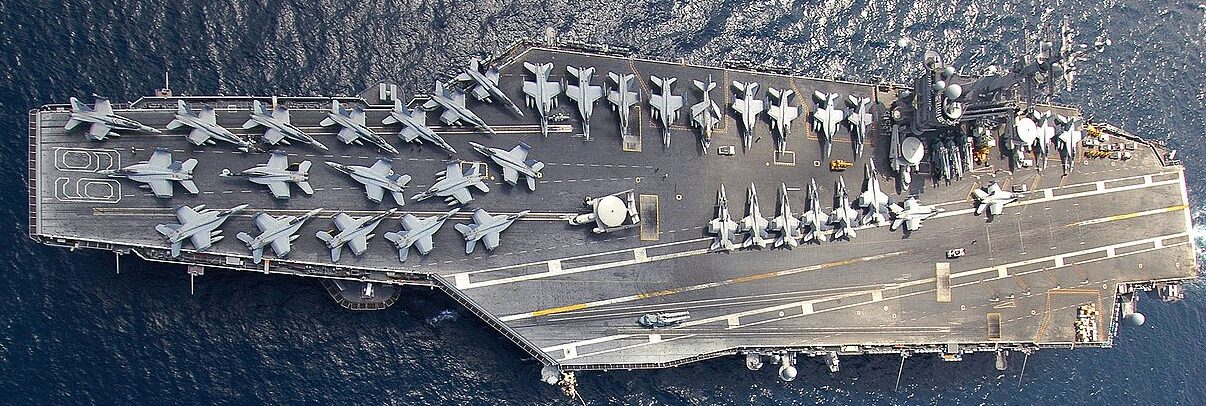
The Carrier Strike Group (SGC) is today’s modern task force of the USN. Unlike in WW2 it is composed of a single carrier surrounded by its escort group. At a time, one mille cruiser (nuclear) and/or conventional (Like the AEGIS-capable Toconderoga), missile destroyers such as the Spruance an dlater Arleigh Burke, and the last frigate of the OH Perry class, plus SSNs to hunt down other SSNs. For this onion-type close protection Nimitz added the range and weight of its air group. If it went down to the triarii, each Nimitz class still has its own sea sparrow battery and CIWS to deal with missiles, plus a generous inventory of chaffs, decoys and jammers, as well as decoys torpedoes or even anti-torpedo torpedoes as tested in the 2000s.
The very essence of the CSG was to ensure this all around multi-layered protection agains any threat: The supercarrier was the biggest and most valuable asset of the USN, or as traditionally said “of the free world”. They are indeed a cornerstone of NATO, SEATO and the guarantee of any alliance. As a veryexpensive and hard to replace, costly to maintain item with a large crew which needed constant training at high level, it was supremely, strategically valuable, having has immense value as a target, and thus motivating the doctrine of both the former Soviet (and actual Russian Navy) ans well as today’s PLAN.
The CSG is geared towards ASW protection but the focus was rather on aerial defence in the 1950s, and it’s asking for a SSN escort at any time for protection. Additional capabilities are also provided by the other surface ships of the escort, such as their long-range Tomahawk missiles to strike objective on land, at sea, and the Aegis Combat System the Nimitz-class lacked. The typical Strike Group around any of the ten carriers of the Nimitz class counds on average six surface ships, one guided-missile cruiser when available and the rest made of guided-missile destroyers for anti-aircraft warfare and anti-submarine warfare and completed by frigates for ASW warfare.

However the last Frigates were struck by the “peace dividends”. The O.H.Perry were disposed of in the 2000s. With the rapid rise of the PLAN and the wish made by the Trump administration for a 500-ship fleet, the largest naval plan since the end of the cold war asked for a new generation of ships that would be built with a standard, and drones.
With this, ended the “happy time” of taxpayer-funded experimentations, the Littoral class ships or Zumwalt class destroyers among others. Since 2022, the Navy decided to make a smart move and work on an existing, proven solution built in the US for the next generation frigate (Constellation class) and complete a void that existed at least below the Arleigh Burke class (above the Ticonderoga has been removed as too costly compared to the Burke, also AEGIS-ships), however there are still plans for a “return of the missile cruiser” if bringing something new to the table.
The Arleigh-Burke only escort of current Nimutz-class CGSs henceforth could be more diversified in the coming years.
As it is often said amateurs talks of tactics, professionals of logistics, and the Navy’s CSG also depends of an ammunition, oiler, and supply ship from Military Sealift Command for this support. The carrier of course itself does not need oil but food and perhaps avgas also if the operation rythm is sustained. The numbers and types of vessels of these strike group can vary depending on deployments and the mission in particular, but of course availability in general.
As of today, the USN comprised 12 fleets managed by the United States Fleet Forces Command. The latter manages naval resources allocated to Combatant Commanders: The United States Northern Command (USNORTHCOM). The fleets were:
1st, deactivated in 1973, now fusioned with the 3rd but could be assigned to the Coast Guard in wartime.
The 2nd (Atlantic) in 2018, had Nimitz-class carriers operating in succession.
The 3rd was deactivated in 1945-73 and assumed the role of the 1st, Eastern Pacific (US Coast).
The 4th was reactivated in 2008 and concerns the Southern Atlantic Ocean.
The 5th fleet was reactivated in 1995 to take charge of the Persian gulf.
The 6th fleet was one of the longest live cold war “classic” fleet, active in the Mediterranean since 1950. A sure assignment for all carriers.
The 7th fleet is the second 1950 “classic” seeing all the major conflicts of the cold war (Korea, Vietnam, Middle east..) tasked of the Western Pacific Ocean & Indian Ocean
The 8th fleet was for the Atlantic in WW2. deactivated.
The 9th fleet was TF 99, Adm. King’s pacific-atlantic fleet. TF 92, 11th Fleet, TF 112. Served in Korea. Now inactive.
The 10th fleet another WW2 fleet, reactivated in 2010 to be the Fleet Cyber Command (so no carrier here obviously).
The 11th fleet was another WW2 fleet assigned the Atlantic and pacific, transferred to the former and deactivated.
The 12th fleet was the same, but for the Atlantic and then Mediterranean, tasks taken over by the 6th TF fleet.
Critics
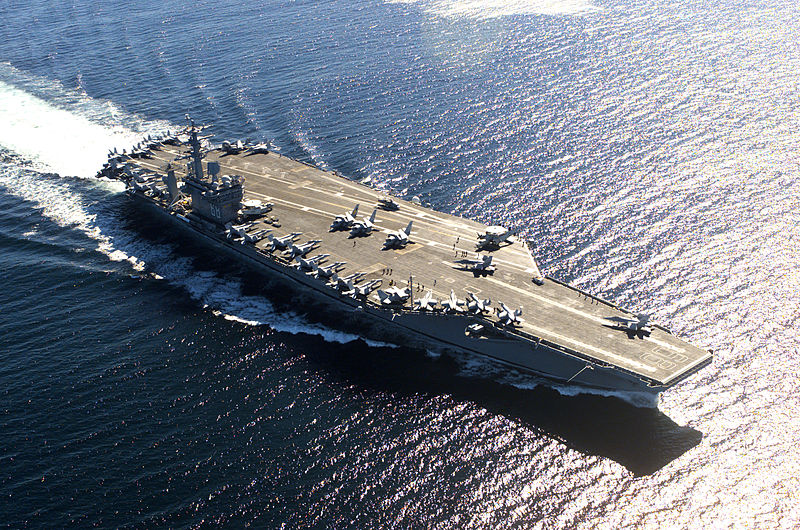
USS Nimitz in Victoria, Canada
Despite their upgrade potential and power reserve, the Nimitz class stil revealed a design flaw that was inherited by all ships and never properly corrected: The class have an inherent list to starboard under combat load exceed the initial capability of their list control system. This of course only aggravated with more modern carriers, which saw an increase ion topweight for electronics, weapons and defence systems, and of course, larger planes. The problem was rectified in part by using damage control voids for ballast but some poposed solid ballast which to not impact their survivability. In any case, the problem is still here today, although toned down. This was the major reason that pushed in the early 2000s to place a replacement, adressing this and the need for even more power. The 40 years old A4W reactors of course are a technology from a bygone era. New, even more powerful and smaller units could be installed, freeing even more space while providing thrice as much power, thus ensuring (on the today’s Gerald R.Ford class) upgrades over the next 40 years, well beyond 2050.
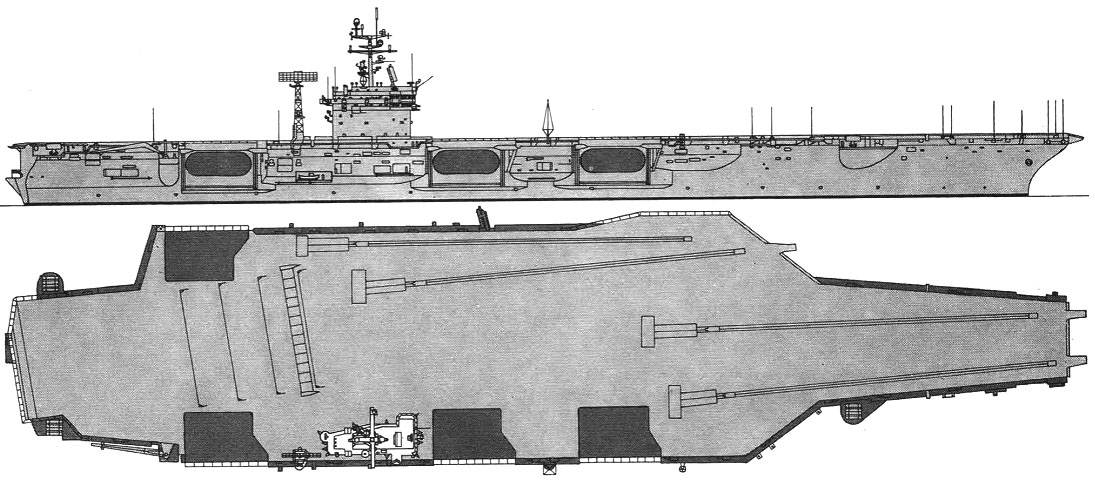
Nimitz in 1980
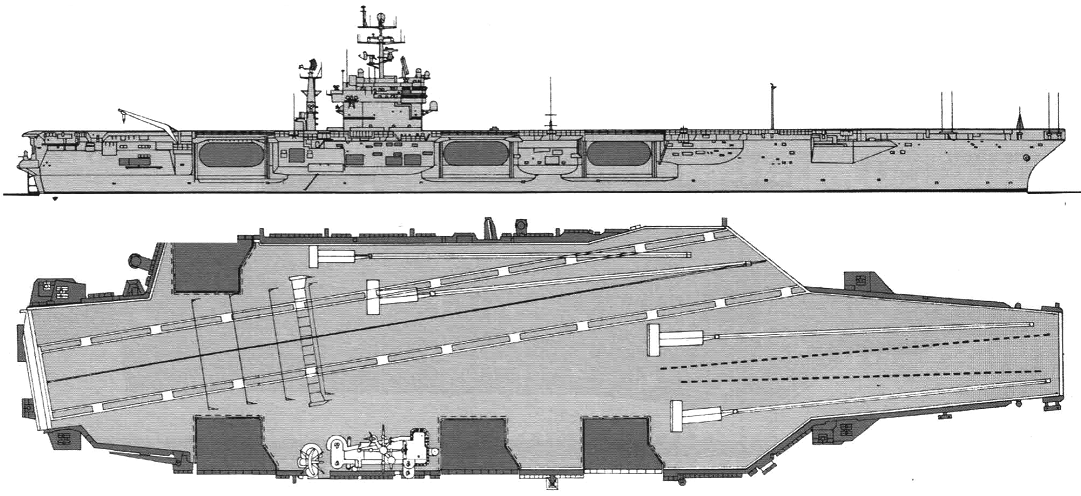
Teddy Roosevelt in 2000
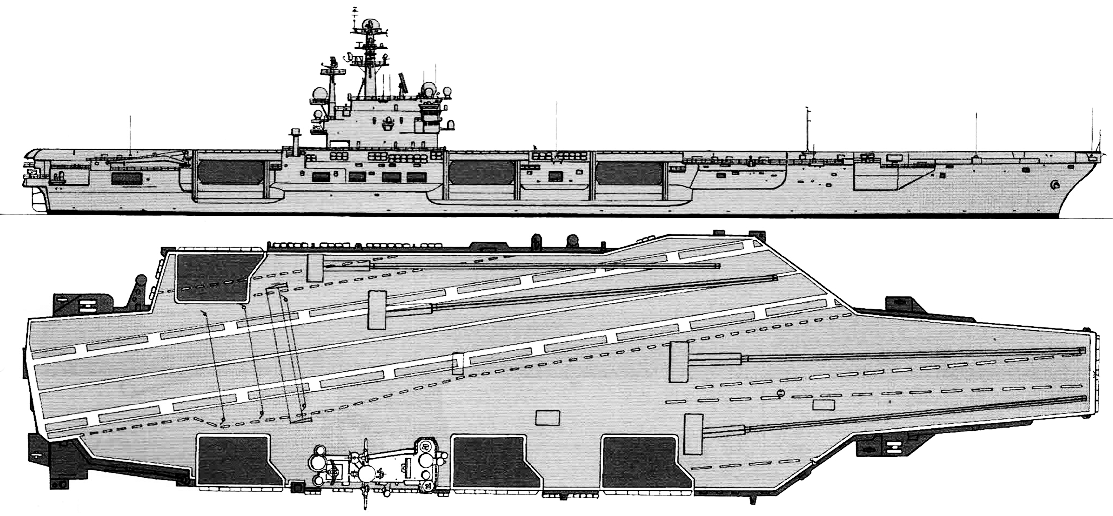
Georges W. Bush in 2010
⚙ Nimitz class specifications |
|
| Displacement | 74,000t standard, 92,000t FL |
| Dimensions | 331.7 x 78.5 (MF 40.8) x 11.5 m (1,092 x 252 x 134 ft) |
| Propulsion | 4 shafts HP turbines, 2 A4W reactors, 260,000 shp |
| Speed | 31.5+ knots |
| Range | Unlimited |
| Armament | 3×8 Sea Sparrow AA (24v), 3-4 x 20mm Vulcan-Phalanx CIWS AM, 60-90 aircraft. |
| Protection | Belt 135, flight deck 45, hangar 50, main deck 56 +Kevlar |
| Sensors | Radar SPS-43A, SPS-48, See notes |
| Crew | 5,620+ see notes |
Assessment and Future
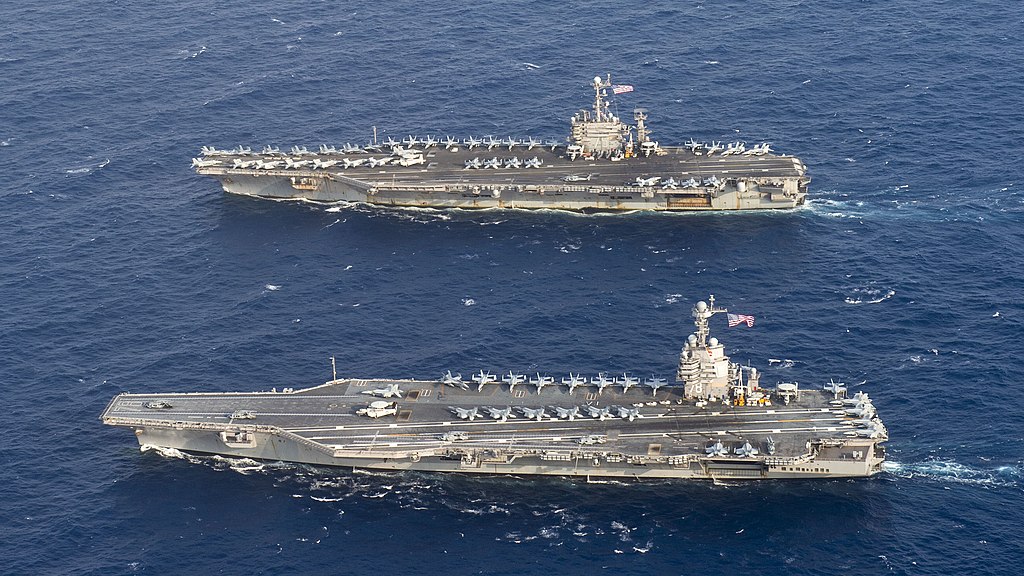
These aircraft carriers, including the latest, USS George W. Bush, succeeding Ronald Reagan when completed 2009 are currently deployed in all sensitive areas assigned by the US government. They traditionally form Washington’s conventional deterrence main naval asset. Since the early 2000s, several projects were studied for the replacement of the Forrestal and Kitty Hawk classes, by smaller ships, with studies taking into account the observation of the last aircraft carriers built in Europe, such as the French Charles de Gaulle, the projected CVF (later Queen Elisabeth class) as well as even smaller vessels like Principle de Asturias and Naruebet based on aborted 1970s carrier escort projects.
The unit cost was about US$8.5 billion in FY 2012 dollars, equal to US$10.1 billion in 2021, and it was planned in the end to built a new generation of conventional carrier, taking the safe bet of a new larger fleet carrier alleviating all issues spotted during the 50 years of operation of the class.
 USS Nimitz (CVN-68) 1972
USS Nimitz (CVN-68) 1972
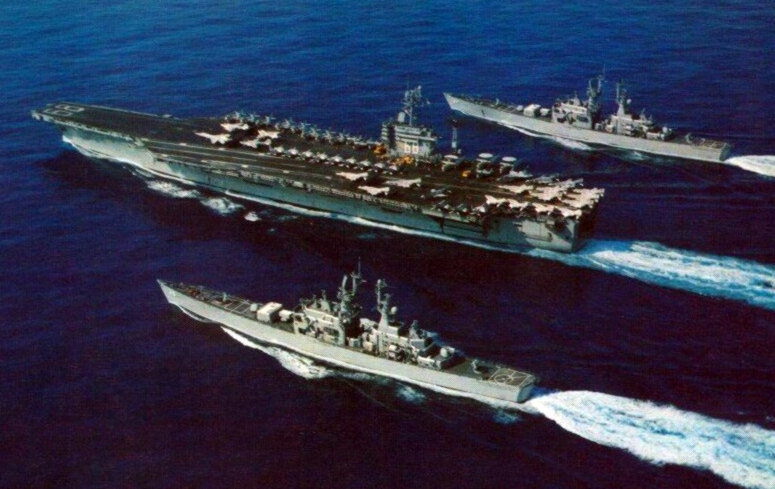
Nimitz on her first deployment in 1976 alongside nuclear-powered cruisers California and South Carolina
Mediterranean Service
USS Nimitz was commissioned on 3 May 1975, performing her sea trials and shakedown cruise. She was first deployed to the Mediterranean Sea on 7 July 1976, some more than a year later, embarking Air Wing 8 and departing with as escorts the nuclear-powered cruisers USS South Carolina and USS California. In November she was awarded the Battle “E” by the U.S. Atlantic Fleet as the most efficient aircraft carrier in the Atlantic Fleet, a good start for her crew. She was back to Norfolk on 7 February 1977.
She made another mission to the Mediterranean from 1 December 1977 to 20 July 1978, without anything notable. Her third was from 10 September 1979 and this time she was ordered to the Indian Ocean due to the development of the Iran hostage crisis after Tehran’s embassy was stormed. She awas there to show the flag and prepare her air group for any support mission. She also hosted a film crew for the 1980 “Final Countdown” set aboard her. After four months she took part in Operation Evening Light part of “Eagle Claw”, Carter’s big failure. She was back home on 26 May 1980 after 144 days.
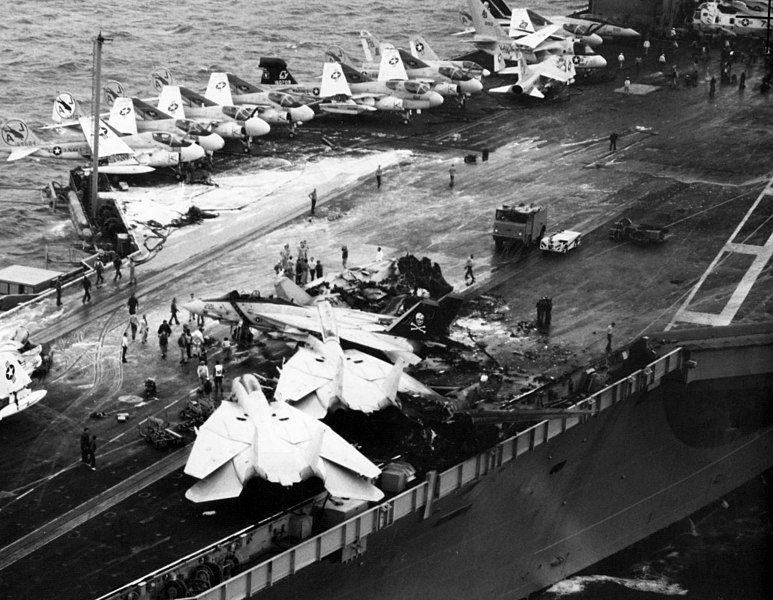
On 26 May 1981 she had her first accident, when a Marine Corps EA-6B Prowler from Carrier Air Wing 8 (CVW-8) crashed on her flight deck, killing 14, injuring 45. The latter was fuel-critical after a missed approach and it was its last attempt. Subsequent fire had written off 19 other aircraft. The media pointed out marijuana consumption later but it was unrelated after autopsies. But President Ronald Reagan instituted a “Zero Tolerance” on drug policy for the US armed services in general.
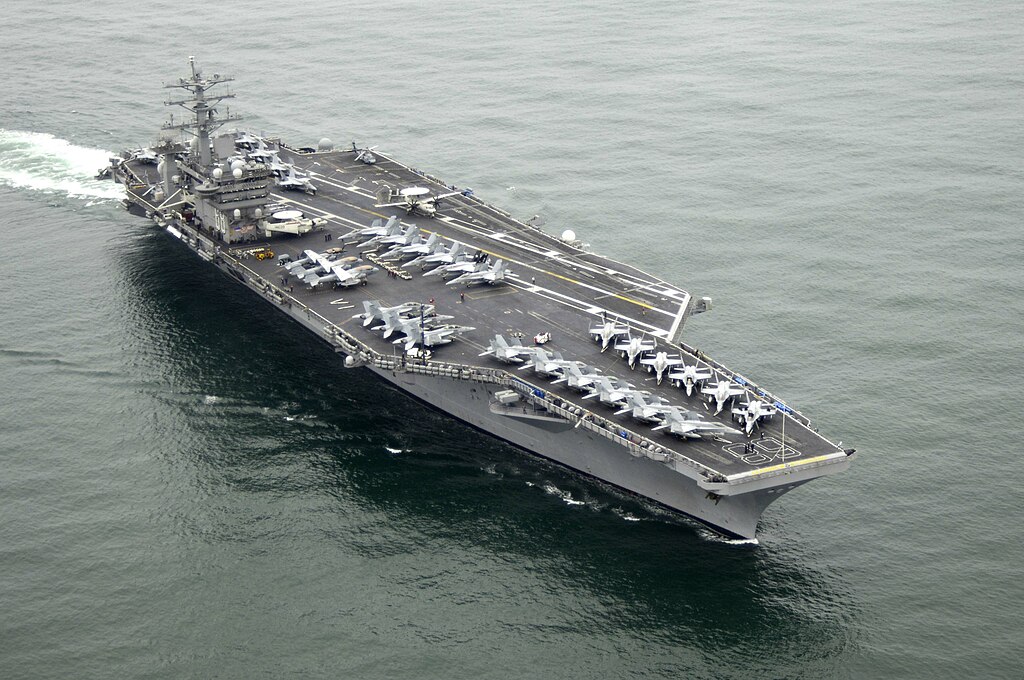
SAN DIEGO (July 29, 2009) USS Nimitz (CVN 68), with Carrier Air Wing (CVW) 11 embarked, transits into San Diego prior to mooring at Naval Air Station North Island. USS Nimitz is preparing for a 2009 regularly scheduled Western Pacific Deployment. (U.S. Navy photo by Mass Communication Specialist 3rd Class John Philip Wagner, Jr/Released)
USS Nimitz made her new Mediterranean TOD on 3 August 1981, creating a twin CDG with USS Forrestal, a large “Freedom of Navigation” exercise in the Gulf of Sidra, near Libya (18-19 August) and on the 19 two of her Grumman F-14 Tomcats (VF-41) fought with two Libyan Su-22s, famously shot down (“Gulf of Sidra incident”).
Her fourth deployment was from 10 November 1982 to 20 May 1983, and extended to the Caribbean Sea in addition to the Mediterranean. Her fifth Med TOD was on 8 March 1985. On 14 June 1985, two Lebanese gunmen hijacked TWA Flight 847 and Nimitz sent to the coast of Lebanon until August 1985 with Airwing 8 performing 67 days of continuous soties, bombing sites in Beirut. She was back to HP Norfolk on 4 October 1985.
Her 6th and final Med TOD started with CVW-8 aboard on 30 December 1986. She spent four months and made many port visits, then crossed the equator to Rio de Janeiro, crossed the Cape Horn and entered the Pacific Ocean, stopping in San Diego, offloading her air wing and tering her new HP Bremerton on 2 July 1987.
Pacific Service
She embarked Carrier Air Wing 9 on 2 September 1988 and during the Olympic Games in Seoul she provided offshore security against any attempt by North Korea. In October, she was in the North Arabian Sea for Operation Earnest Will, protecting Kuwaiti tankers against Iranian attacks. On 30 November 1988 she had a 20 mm CIWS accidentally discharging during maintenance, damaging a KA-6 Intruder, which erupted in flames, communicated to six other, with two personal deceased. She was back in Bremerton on 2 March 1989.
On 25 February 1991, she headed for the Persian Gulf, relieving of USS Ranger after Operation Desert Storm. She was back to Bremerton on 24 August 1991. Sh e returned in the Persian Gulf on 1 February 1993 for Operation Southern Watch, and was back on 1 August 1993.
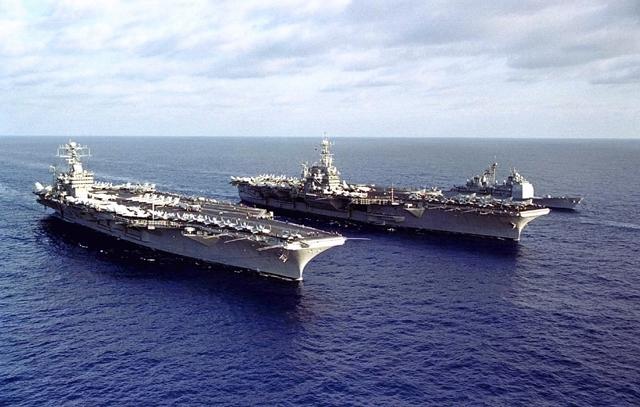
Nimitz with USS Independence in the Sea of Japan in September 1997
On 27 November 1995, USS Nimitz departed for the Western Pacific but also toured the Indian Ocean and Persian Gulf with CVW-9 aboard. In March 1996 she patrolled off Taiwan as the Chinese rtamped up their missile tests in these waters. She became the first American warship to pass through the Taiwan Strait since 1976, causing protests from Beijing. She returned to the Persian Gulf for Operation Southern Watch and back to Bremerton by 20 May 1996.
On 14-24 July 1997 she took part in Joint Task Force Exercise 97-2 JTFEX 97–2 off southern California and demonstrated its new capabilities in air Strikes in carrier-based actions and littoral warfare. On 20 July 1997 she tested a high-intensity strike campaign for four days, showing she could make 771 strike sorties and spending 1,337 bombs accurately on target with CAW9 (975 fixed-wing sorties, 80% of strike and 10% strike support). The F/A-18 Hornet strike fighters made the bulk of it, proving their new capabilities to replace the old Corsair II and Intruder. These sorties were always made under the electronic umbrella of the EA-6B Prowlers. KC-135 and KC-130 tanker aircraft also provided air support for more turnover. S-3 Vikings conducted also took part in a “fuel chain” for CAW9 as well, showing also a new possible distribution as impromptu tankers to various in flight units. This motivated later a study by the Center for Naval Analyses showved she could have maintained this tempo for 12 to 24h more before any maintenance, rest, ordnance refill or refuelling. That was quite valuable for future operations.
On 1 September 1997, USS Nimitz made her first round-the-world cruise, stopping for another tour of Southern Watch, and eneded in Newport News on 2 March 1998. Next followed a next three years period of SLEP and nuclear Refueling. he “super-overhaul” which comprises many upgrades, ended on 25 June 2001. This was also the shortest of all Nimitz-class carriers.
Post Overhaul service 2001-2023
On 21 September 2001, after performing her post-overhaul sea trials at the Virginia Capes and fixes, USS Nimitz made a South American tour, also being ported to NAS North Island, San Diego in California from 13 November. She embarked Carrier Air Reserve Wing 20 and until May 2002 made her 4-month post-shakedown maintenance availability, receiving an new Advanced combat direction system that needed tuning and setting up.
She made her 11th deployment from 3 March 2003, relievinh her sister USS Abraham Lincoln in the Persian Gulf by mid-April 2003. She had Carrier Air Wing 11 (CAW 11) aboard for these operations, multiplying sorties for Operation Iraqi Freedom in Iraq, and Afghanistan for Operation Enduring Freedom. She was back to San Diego on 5 November 2003, being awarded the 2003 Battle “E” and Flatley Award in 2004.
In November 2004 she scrambled her F18 after USS Princeton tracking UFOs. Thus was the start of the famous incident later publicized in December 2017. This also pushed the USN to enforce the Advanced Aviation Threat Identification Program. Nimitz returned to the Persian Gulf on 7 May 2005 and back on 8 November 2005. By June 2006 she won another Battle “E” for the past year.
Her 13th deployment started on 2 April 2007, to the Arabian Sea againd and relieving her sister USS Dwight D. Eisenhower. She was later sent off Chennai, India on 2 July 2007 for a bilateral defense cooperation, sailors taking part in community work before returning to the Persian Gulf and back to HP on 30 September 2007.
On 24 January 2008, Nimitz sailed to the Pacific and on 9 February 2008 was approached bt two Russian Tu-95 ‘Bear’ bombers while in the Western Pacific, intercepted and shadowed by four F/A-18C Hornets which took off when they were spotted 500 miles (800 km) away. One overflew the carrier later. There was no radio communication and later they entered Japanese airspace, causing protest in Tokyo. On 5 March 2008, another arrived at 3-5 nautical miles (6 to 9 km) at 2,000 feet (610 m) above Nimitz. In 2007 she was awarded a 3rd “E”. She was back in San Diego by 3 June 2008.
Still with CVW-11 aboard, she made a Western Pacific deployment on 31 July 2009 before moving to the Persian Gulf for Operation Enduring Freedom on 21 September. In 2010, while there, she was awarded the Meritorious Unit Commendation for her daily sorties in Iraq and Afghanistan 2007-2008, presented by Admiral Gary Roughead on 6 January. She returned to the pacific, stating in Hong Kong for five days for rest despite China warned the previous USS Kitty Hawk to do so.
On 9 December 2010, she was to be hoeported to Everett, Washington, notably to save $100 million, arriving on 9 March 2012 after post overhaul sea trials and a year of maintenance work in Bremerton. By March 2012, she replaced USS Abraham Lincoln and by 3 August departed from Pearl Harbor after to NAS North Island, making new Squadron carrier qualifications. By 6 October 2012 she tested the V-22 Osprey (from VMM-165) for a resupply test. This was for a feasibility to replace the C-2 Greyhound for carrier onboard delivery (COD).
She returned to the Persian Gulf, during the operation against Syria and President Obama ordered a strike. She then transited to the Arabian Sea, Suez Canal (20 October 2013) and joined the 6th Fleet for weeks of joint training with allies and returned to Everett on 16 December 2013.
In late 2014 after qualifications of her new air group she participated in a two-week multi-national fleet exercise with the newly reformed 3rd Fleet, and with the Royal Canadian Navy and JMSDF. On 3 November she saw the first F-35C Lightning II landing, and it was follwed by a two-week Testing deployment. Two of these from VX-23 made the whole range of carrier landing, launching and handling in day and night conditions. This was completed on 14 November 2014. In 2015 she entered Bremerton for 16-month maintenance.
On 1 June 2017, USS Nimitz was relacated to HP Kitsap, making a new deployment against ISIS in Iraq and Syria. Her air group was noted for its action at the Battle of Tal Afar, providing precision air support for Iraqi soldiers. By March 2018 she was back in drydock, Puget Sound for a new ten months overhaul. The COVID-19 pandemic however delayed new deployments. She had an outburst of cases by April 2020 and on the 27th she completed a 27-day quarantine. This was followed by a COMPTUEX training and she was back deployed by 5 July 2020 in the South China Sea, with her youngest sister USS Ronald Reagan.
On 31 December 2020, DoD secretary Chris Miller ordered ceased her 10-month deployment in the 5th Fleet to support the withdrawal of troops from Somalia, assisting USS Makin Island group.
On 3 January 2021 however she was to show the flag in the Persian gulf, and by May 2022, she led Carrier Strike Group 11 in the Eastern Pacific. By November 2022 she left Kitsap for San Diego, leaving on 3 December 2022 for the Pacific as the center of Carrier Strike Group 11 with Carrier Air Wing 17. On 21 January 2023, she stopped in Singapore and on 26 February in Guam, arriving at Busan on 28 March and later ecelbrating her 350,000th landing on 22 April. She made another port visit in Thailand and returned home.
By April 2022, the Navy Press Corps precised that Nimitz is planned for decommission in FY2025 after her terminal Off-load Program and inactivation planned to start by 2027. As USS Enteprise, this will be a very long and costly affair, so she is likely to be still around in one state or another in the following decade, probably beyond 2035. No reserve time has been precised. This will be updated on the future.
 USS Dwight D. Eisenhower (CVN-69) 1975
USS Dwight D. Eisenhower (CVN-69) 1975
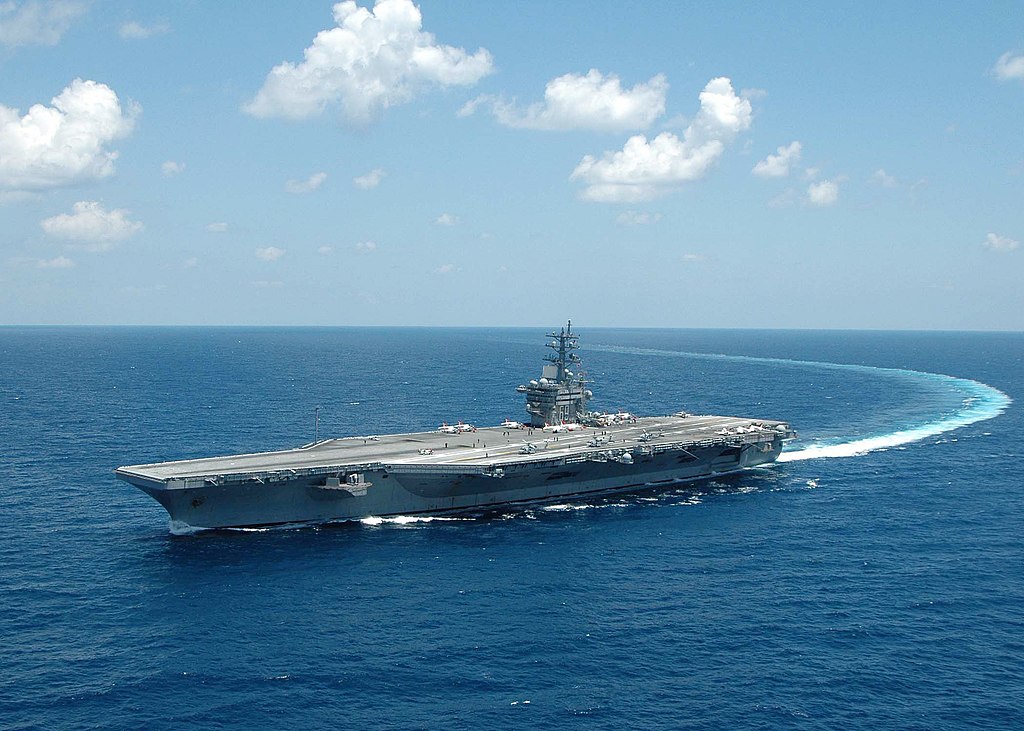
“Ike” as she was popularly known, was commissioned on 18 October 1977. After trials and shakedown post-fixes, she was assigned to the United States Atlantic Fleet and hosted President Jimmy Carter with his wife Rosalynn and the Defense Secretary Harold Brown, National Security Advisor Zbigniew Brzeziński at the occasion of her advanced training. By January 1979, she made her first deployment to the Mediterranean being visited off the coast of Israel by Israeli premier Menachem Begin, before returning to HP Norfolk in July.
She made her second Med TOD under command of Captain James H. Mauldin in 1980, dispatched to the Indian Ocean to answer the Iran hostage crisis, relieving USS Nimitz three days after the failed rescue attempt. She would make a third deployment in the Mediterranean under E. W. Clexton Jr. (from 5 January to 13 July 1982), but lost on her her logistic aicraft (with 11 passengers and crew) near Souda Bay in Crete on 2 April. On 24 June she helped evacuate U.S. Embassy staff in Beirut.
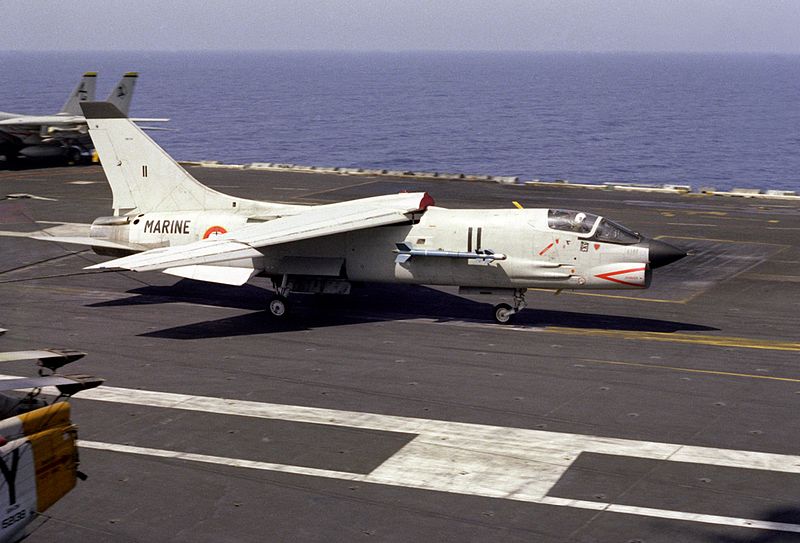
An F-8E(FN) Crusader from the Aéronavale (only occasion for the old bird to mee the new carrier) on Dwight D. Eisenhower in 1983 during a joint exercize.
USS Dwight d. Eisenhower (formerly called simply “eisenhower”) started her 4th deployment from 27 April, until 2 December 1983 taking part in joint NATO exercizes but also with the Egyptian and U.S. Air Force. When Qadhafi declared the Gulf of Sidra will be a “red gulf of blood” if she was to enter thiese waters, escalating tensions forced the carrier to move to the area and dure enough on 2-5 August her Combat Air Patrol intercepted two Libyan MiG-23 Flogger and two Dassault-Breguet Mirage 5 in separate raids. On 26 August, she returne doff Beirut, Lebanon, launching sorties in support to the U.S. Marines and peacekeeping forces deployed there during the civil war. She ended her 93 days of operations by stopping in Italy on 21 October, but scrambled back to Beirut after the suicide attacks of 23 October. She remained on station until relieved by USS Independence and John F. Kennedy in November.
By May-June given her name, she made a stay off Normandy coast of France in 1984 for the 40th D-Day anniversary. She also stopped in Portugal and at Portsmouth, being visited by Queen Elizabeth II. She ended her 5th deployment in the drydock of Newport News for her 1985 major overhaul of 18-month. She notably received new CIWS, third Sea Sparrow launcher, the new Naval Tactical Data System (NTDS), a new ASW module and new communication system, being back to operation in April 1987.
On 29 February 1988 she started her 6th Med TOD, with nothingof note. However while back to Norfolk on 29 August 1988 she collided with the anchored Spanish bulk carrier Urduliz while entering the harbor at Norfolk. Both wind and currents pushed her off course but damage was light for both. She was back in operation from April 1989 and in 1990 made her 7th TOD but this was joined by a commemorative “Dwight D. Eisenhower Centennial” (100th anniversary of the president’s birth), and a noted presence again at the During D-Day anniversary, having D-Day veterans embarked while her air group made a memorial flyover over Omaha Beach.
After the invasion Kuwait, USS Dwight D. Eisenhower was the first carrier ready to be deployed in the Red Sea and transit the Suez Canal. She was there as a “ready striking force” if Iraq pushed to Saudi Arabia as well. Maritime interception operations were prepared as a UN-embargo against Iraq was decided. She later returned home, and drydock maintenance. She was back on 26 September 1991 to the Persian Gulf, supporting coalition forces for Operation Desert Storm and back to Norfolk on 2 April 1992 for an overhaul and conversion. She was back to operations on 12 November 1993 to take part in post–Gulf War, but also Operation Uphold Democracy in 1994.
She notably carried the 10th Mountain Division for an “adaptive force packaging” deployment, at Port-au-Prince to lead the Operation to restore the elected government of Haiti.
By October 1994 she returned to the Persian gulf, for another six-month deployment for Operation Southern Watch and Operation Deny Flight, having notably women as crew members, a first at the time in the USN. She operated Carrier Air Wing Three (CVW-3) and hosted command of Cruiser-Destroyer Group 8, also heavily feminized. This went not well with the press however.
USS Dwight D. Eisenhower was back to Newport News on 17 July 1995 for a new 18-month overhaul until 27 January 1997, notably earning the new Advanced combat direction system. Her 10th Med TOD satarted on 10 June 1998, until December. By February 1999 she was in Norfolk for 6 months for maintenance, until June.
She returned to the Mediterranean by February 2000 for the “Millennium Cruise”, having her first air strikes with live ordnance furing Operation Southern Watch. On 3 October 2006 with CVW-7 aboard, “Ike” became flagship of RADM Allen G. Myers at the head of CSG-8. She was escorted by the cruiser USSr Anzio, destroyers USS Ramage and Mason, and and the SSN USS Newport News, stopping in Naples, Limassol, before entering the Persian Gulf in December.
On 8 January 2007, she provided cover for an AC-130 gunship from Djibouti over Al-Qaeda targets in Somalia. She was part of the Combined Task Force 150 (CTF-150) off Bahrain with ships from Canada, France, Germany, Pakistan, and the UK, escorted by the Arleigh Burke-class USS Ramage and the Ticonderoga-class USS Bunker Hill acting over Somalia. In March 2007, followed by exercises off the Iranian coastline. Relieved by Nimitz she returned home.
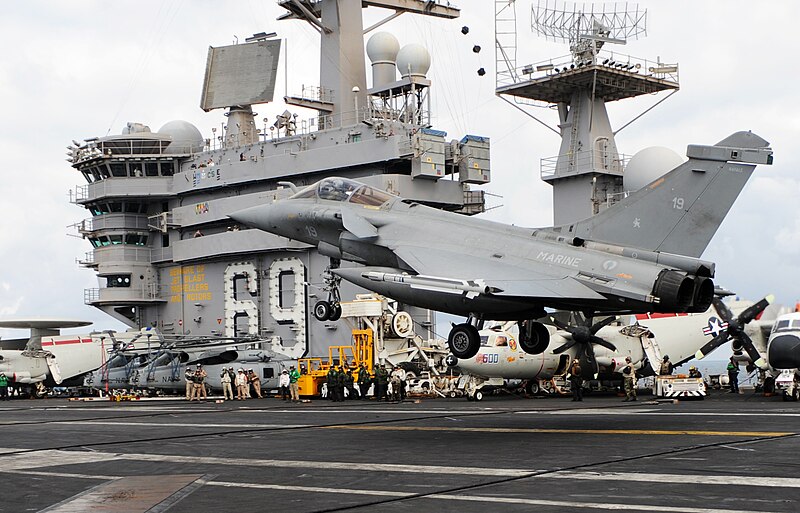
On 4 October 2008 Petty Officer 2nd Class Robert Lemar Robinson was killed aboard during training exercises off North Carolina, struck on deck by an airplane while on the flight deck. On 21 February 2009 she returned to the Arabian Sea, as flagship, Carrier Strike Group 8 (Rear Admiral Kurt W. Tidd) and with CW-7 and and DesRon 28 staff. She was escorted by USS Bainbridge, Halyburton, Scranton, Vicksburg, and Gettysburg. She made sorties for Opeations Iraqi Freedom and Enduring Freedom, including anti-piracy patrols. On 16 May she entered Manama in Bahrain, mooring pierside, and by 30 July she was back to NAS Norfolk.
On 2 January 2010, “Ike” was back to the Middle East and 5th-6th fleets. She was again flagship under Rear Admiral Philip S. Davidson, air her group performing a large range of missions. In with CW 7 and escorted by DesRon 28 (USS Hué City, McFaul, Carney, Farragut), back to Norfolk on 28 July 2010.
She was in availability in September 2010 to June 2011 and returned from 7 June 2012 to the Middle East for Operation Enduring Freedom, then back on 19 December 2012. On 22 February 2013 she departed with Strike Group 8, stopping to Marseille in France and integrating for the first tile the German Sachsen-class frigate Hamburg under (FKpt) Ralf Kuchler, integrating her strike group in the 5th fleet to test allied interoperability. She was back HP on 3 July 2013.
On 6 August she started her DPIA at Norfolk, and an overhaul until 3 September 2015.
On 8 June 2016, she joined the 6th Fleet and by 22 November she entered again the Persian Gulf, launching strikes from the eastern Mediterranean under commmand of Paul Spedero, which reported in total she dropped 1,100 of ordnance over ISIS targets in Iraq and Syria. She was back home on 30 December.
On 18 March 2016 while off Virginia she had eight deck crewmen injured when the arresting gear cables failed during an E-2 landing. They were flown by helicopter the nearest hospitals and all recovered. In December 2016 she started her 17th Med Tod and Persian Gulf deployment, this time for Operation Inherent Resolve.
On 13 January 2020, USS Dwight D. Eisenhower departed with Carrier Strike Group 10 until late February and to the Persian Gulf under the new “Dynamic Force Employment” (DFE), to make her less predictive in her deployments by security.
On 26 June 2020 she broke Roosevelt’s record of 160 days at sea, and “remained clean” from any COVID outburst, remaining operational. On 25-26 July she trained with the Hellenic Air Force southeast of Crete and by 3 March 2021 took part in the Exercise Lightning Handshake with the Royal Moroccan Navy frigate Tarik Ben Zayid and air force. By 2 April 2021 with CW 3 she transited the Suez Canal into the Red Sea for Operation Inherent Resolve.
She had her Planned Incremental Availability between September 2021 to October 2022 and returned into operations in 2023 (section to expaned in the future).
USS Dwight D. Eisenhower (“Mighty Ike”) is scheduled for decommission circa 2029 notably by the new USS Enterprise (CVN-80) of the Gerald R. Ford-class. The date was not precised yet, so this article will be updated to follow her 2023-2029 operations.
 USS Carl Vinson (CVN-70) 1982
USS Carl Vinson (CVN-70) 1982
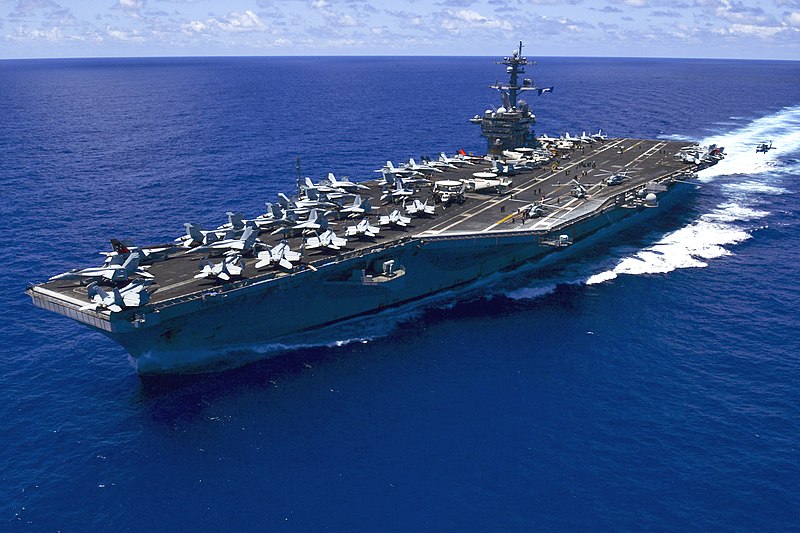
USS Carl Vinson was commissioned on 13 March 1982 at Newport News, Virginia. She put to sea for her trials, qhort shakedown cruiser and flight deck certifications, followed by sessions of advanced training evolutions along the East Coast and weapons, sensors drills. When declared ready she departed Norfolk on 1 March 1983 with CW 15 eaboard for her first deployment of eight-month in an around-the-world cruise starting in the Atlantic, Mediterranean, Suez and Indian Ocean, Arabian Sea, South China Sea, and Pacific while multiplying exercises and port (Monaco, Casablanca, Abidjan, Perth, Subic Bay, Hong Kong, Sasebo, Pusan, Pearl Harbor, before arriving on the Californian coast at Naval Air Station Alameda on 28 October 1983.
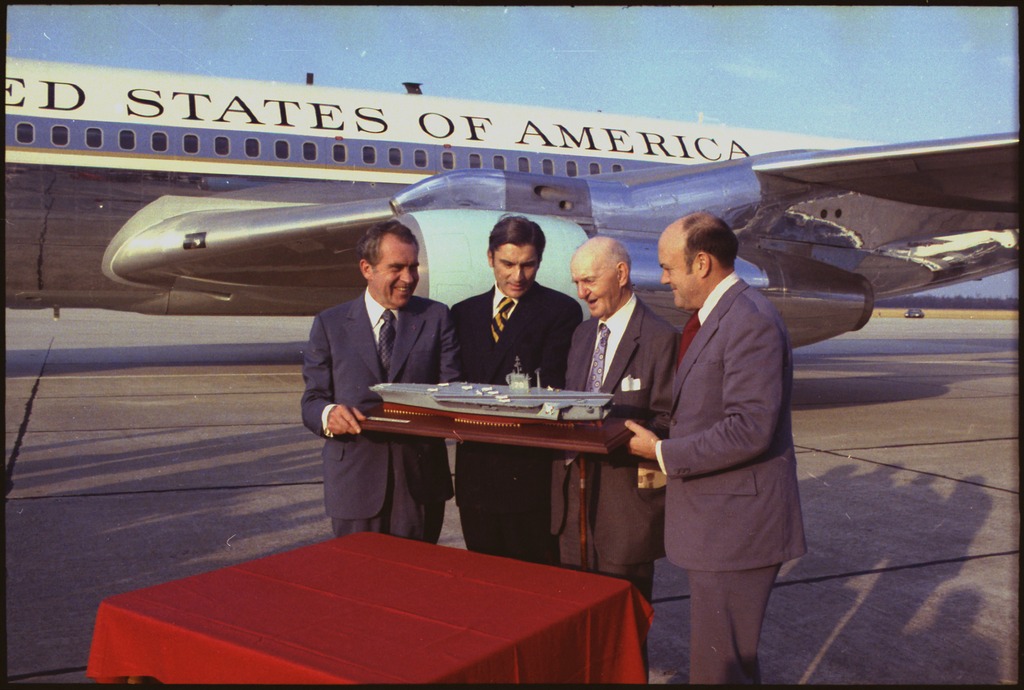
USS Carl Vinson took part in RIMPAC ’84 and by October operated in the Western Pacific with Carrier Air Wing 15 aboard. In January-April 1985 she served in the Indian Ocean for 107 days, followed by Sea of Japan operations, her air group chasing a Soviet Charlie I class submarine, earning a Meritorious Unit Commendation. By 12 August 1986 she left Alameda for another WestPac with CVW-15 and went to the Bering Sea (first ever carrrier to do this), transiting by January 1987 on her way back to NAS Alameda.
Carl Vinson and CVW-15 started a 4th Westpac on 15 June 1988, taking part in Operation Earnest Will, escorting tankers in the Persian Gulf. She was back in December 1988, awarded the Admiral Flatley Memorial Award for aviation safety. By September 1989 she took part in PACEX ’89 (largest peacetime naval exercise) in the Bering Sea and Aleutian Islands for a three-carrier battle group operation ending in the Sea of Japan. She stopped in Pusan before Alameda.

For her 5th Westpac, Vinson in February 1990 had aboard the A-7 Corsair II for the last time. She was back to Alameda on 30 July 1990 and on 22 September 1990 entered Bremerton got her 28-month complex overhaul , receiving also her first Battle “E” award for 1990. She departed on 17 February 1994 with Carrier Air Wing 14 for the Persian Gulf and Operation Southern Watch, back to Alameda on 17 August 1994.
In 1995, she hosted the documentary “Carrier: Fortress at Sea” aired on Discovery Channel. By 26 August until 3 September 1995 she took part in Exercise Ke Koa, and commemorations of the end of the Pacific war in which she hosted President Bill Clinton while in Hawaii, and launching 11 WW2-era models.
Her 7th Wesptac started on 14 May 1996 for the Persian Gulf with CVW-14 and Operation Southern Watch, but also Operation Desert Strike, then Exercise Rugged Nautilus and back on 14 November 1996.
Naval Air Station Alameda was closed and she was homeported to Bremerton (Washington) on 17 January 1997, also making her last operations with the A-6E Intruder. She departed with Carrier Air Wing 11 (CVW-11) aboard for RIMPAC ’98. on 10 August however she was “sank” by the Australian HMAS Onslow, which managed to apprach at 300 meters (980 ft) undetected. She released green flares to make the “victory”. Vinson then headed for the Persian Gulf and multiplied airstrikes in December as part of Operation Desert Fox and Operation Southern Watch, until March 1999. By July 1999 she was drydocked in Puget Sound for 13 months of costly upgrades.
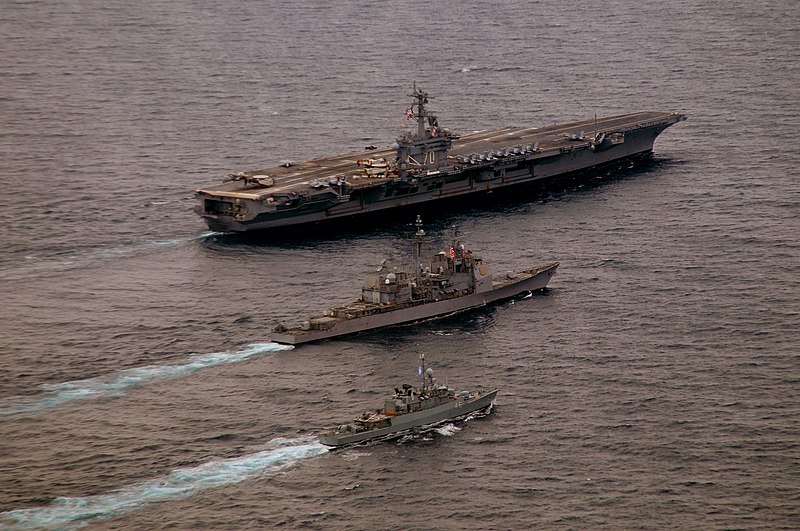
Out of it by February 2001, she hosted the blockbuster “Behind Enemy Lines” (Gene Hackman, David Keith, Owen Wilson…) during her pre-deployment workups of two-week, the whole crew taking part in hte movie. She was deployed for Operation Enduring Freedom, while the film crew returned on the carrier while off the North Arabian Sea to show the crew the result. Later the carrier experience rough quals off the coast of Hawaii.
On 23 July 2001, was underway to Bremerton via San Diego to pick up CVW-11 and returned to the Persian Gulf but this was changed on 11 September 2001, and she rounded India for the North Arabian Sea arriving on 7 October 2001, and launching the first airstrikes of Operation Enduring Freedom, then she stayed for 72 days and 4,000 combat sorties later earning the first “Global War on Terrorism Expeditionary Medal”, Battle E and Navy Unit Commendation. She stopped in Pearl Harbor for a “Tiger Cruise” with crew member family members travelling aboard to Bremerton, arriving on 23 January 2002. She started her new long overhaul in April, followed by a post-refit shakedown and by September sea trials.
In January 2003 she qualified Carrier Air Wing Nine (CVW-9) and took part later to Operation Iraqi Freedom, also making numerous ports calls, notably at Guam, South Korea, Japan, Australia, Hong Kong, and Singapore and back to Bremerton on 15 September 2003. She took part in exercize Foal Eagle off Korea, won the Marjorie Sterrett Battleship Fund Award and departed in 2009 with CVW-9 for another 7-month Westpac, inclusing long stays in Persian Gulf for Operation Iraqi Freedom & Enduring Freedom but also stopped at Singapore, Guam, Bahrain, the UAE, Rhodes, and Lisbon, before entering Norfolk on 31 July 2005, having lost two Marine F-18 pilots over Iraq.
In November 2005 she underwent her mid-life Refueling and Complex Overhaul (RCOH) for 36 months at Northrop Grumman Newport News shipyard in May 2007. She started her sea trials on 28 June 2009 and was back to Norfolk, followed by a 4-month shipyard maintenance and sailinng to the Pacific and to North Island, San Diego to join here CVN-68 and CVN-76 in early 2010.
By 12 January 2010 she took part in the 2010 Haiti earthquake relief effort (Operation Unified Response) redirected to Mayport, to receive additional supplies and helicopters. By March 2010 she took part in the Gringo-Gaucho/Southern Seas 2010 maneuvers with the Argentine Navy before arriving at NAS San Diego.
On 30 November 2010, with CW 17 aboard she departed for a 3-week composite training unit exercise and the Western Pacific, 5th Fleet Area in the Indian Ocean/Persian Gulf joining there Carrier Strike Group One. By 11 April 2011 on F/A-18 Hornet suffered an engine fire after launch, returned to the carrier and was saved. On 2 May 2011, the body of Osama bin Laden was brought aboard Carl Vinson and buried at sea. After a stay at Manila Bay (Philippines) in which she hosted President Benigno Aquino III and Ambassador Harry K. Thomas, Jr., she went to Hong Kong on 22 May 2011 to take on supplies before heading for San Diego, hosting the Chinese press. By 21 June 2011 she hosted a basketball game and President Barack Obama was in attendance.
On 30 November 2011, she departed for a new WESTPAC in the Arabian Sea, back on 23 May 2012. By 5 July 2012, she entered her Planned Incremental Availability period (major maintenance phase to sustain operations) with overhauls of her living spaces and workspaces, upgrades, and this including the setup of a Global Command and Control System-Maritime (GCCS-M) to the Distributed Common Ground System-Navy (DCGS-N).
On 30 January 2013 after sea trials under Captain Kent D. Whalen, she was assigned CVW-17 and returned to the 5th and 7th Fleet escorted by USS Bunker Hill, Gridley, Sterett, and Dewey as part of her CSG, relieving George H. W. Bush in the Persian Gulf fighting the Islamic State of Iraq and Levant. On 11 September 2014 she lost two F/A-18Cs (Strike Squadron 94) in the western Pacific after after a fatal collision 290 miles (470 km) west of Wake. One pilot was recovered alive.
Back to San Diego on 4 June 2015 her tally included 12,300 sorties, 2,382 combat missions, 230 tons of ordnance dropped. On 14 August 2015 she entered her new PIA period at for $300 million, notably receiving the first UAV command center of any carrier. She received Carrier Air Wing 2 and departed on 5 January 2017, starting routine operations in the South China Sea amidst concerns about the North Korea’s ballistic missile program. Donald Trump announced her presence, while she was 3,500 miles (5,600 km) away in exercizes with the RAN in the Indian Ocean, a premature announcement.
On 5 January 2018, she left San Diego and by 5 March she entered Da Nang with USS Lake Champlain and Wayne E. Meyer for a State visit to Vietnam. She was back in San Diego on 12 April 2018 followed by RIMPAC 2018. She was swapped to the new NB Kitsap after maintenance at Puget Sound and then back to San Diego. COVID-19 was reported aboard on 23 March 2020 while in dry dock maintenance at Puget Sound for a 17-month overhaul. She departed on 3 August 2021 with CVW-2, notably comprising Strike Fighter Squadron 147 (VFA-147) equipped with the F-35C Lightning II for their first deployment. On 24 January 2022 in the South China Sea she had a F-35C crashing while landing with 7 crew members injured. The logs stops there. Updates are planned in the future.
 USS Theodore Roosevelt (CVN-71) 1984
USS Theodore Roosevelt (CVN-71) 1984
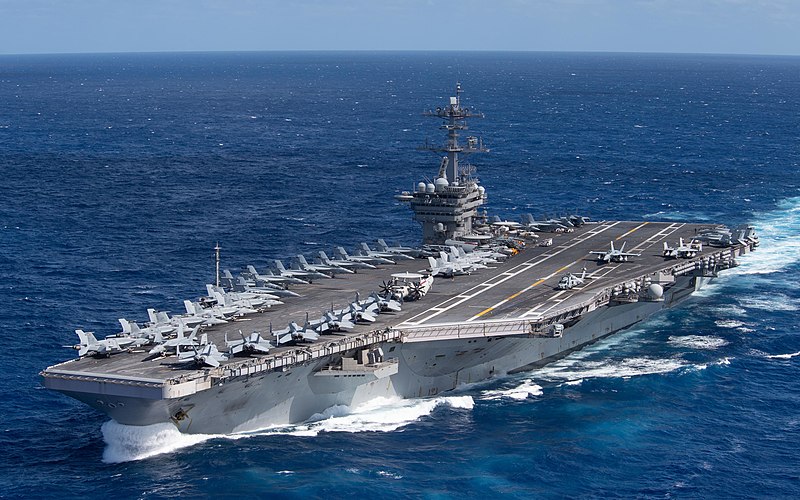
USS TDR (“The big stick”) named after the famous president was commossioned at 25 October 1986. She had been the very first of her type to be assembled using modular construction: Large modules are independently constructed in “lay-down” areas, and then hoisted into place by super-heavy portico cranes, then welded together. The massive gantry crane (capable of 900 tons) was also a world’s firts, soon imitated. It shelved 16 months of construction time and became the new standard. USS Theodore Roosevelt also constituted her own sub-class (see above). She made her sea trials and shakedown, departing for her first deployment on 30 December 1988 with Carrier Air Wing Eight (CVW-8) in the Mediterranean, back on 30 June 1989 and awarded her first 1989 Battle “E” at this occasion.
On 28 December 1990 she returned this time for Operation Desert Shield starting in 16 January 1991. She flew 4,200 sorties (more than any other carrier) dropping 4,8 million pounds of ordnance until 28 February. When back she made a 4-carrier display as part of “Battle Force Zulu”.
She also took part in Operation Provide Comfort over northern Iraq for total of 189-day deployment, being back to Norfolk on 28 June 1991 and earning another Battle “E”. Her third deployment started on 11 March 1993, but this time she carried a Special Purpose Marine Air-Ground Task Force (SPMAGTF) and operated in the Adriatic for Operation Deny Flight over Bosnia. In June she transited the Suez Canal to the Red Sea to and Operation Southern Watch over Iraq, for 184 days, back in September 1993 and earning a second Meritorious Unit Commendation.
From November 1993 to April 1994 she was in Selected Restricted Availability at Norfolk but she also received a 3rd Battle “E” and 2nd Battenberg Cup (bast Atlantic Fleet ship). Her 4th deployment started in March 1995 to the Red Sea for Operation Southern Watc, Deny Flight, Sharp Guard in the Adriatic, then Operation Deliberate Force against Bosnian Serb targets. She was back in Norfolk by September 1995 with a new Navy Unit Commendation “Bosnia”.
On 14 October 1996 she collided with the guided missile cruiser USS Leyte Gulf while off the coast of North Carolina when she reversed her engines as the cruiser was behind, smashing the Ticonderoga class bow. She herseld had $7 million damage to her stern, more than for the cruiser’s bow.
Her 4th deployment started on 25 November 1996 with CVW-3 and for Operation Southern Watch, back in May 1997. On 8 July 1997 she entered Newport News for an EDSRA, major overhaul, until returning to Norfolk Naval by 2 July 1998. On 1 February-4 March 1999 she took part in JTFEX/TMDI99 with the Brazilian Navy and NATO, “mock-sunk” by the Dutch submarine HNLMS Walrus.
TDR’s 6th deployment started on 26 March 1999, in the Ionian Sea for NATO’s Operation Allied Force. She conducted airstrikes over Kosovo, against Serbian positions. Next she sailed for Operation Southern Watch over Southern Iraq. She was back in Norfolk on 24 September 1999.
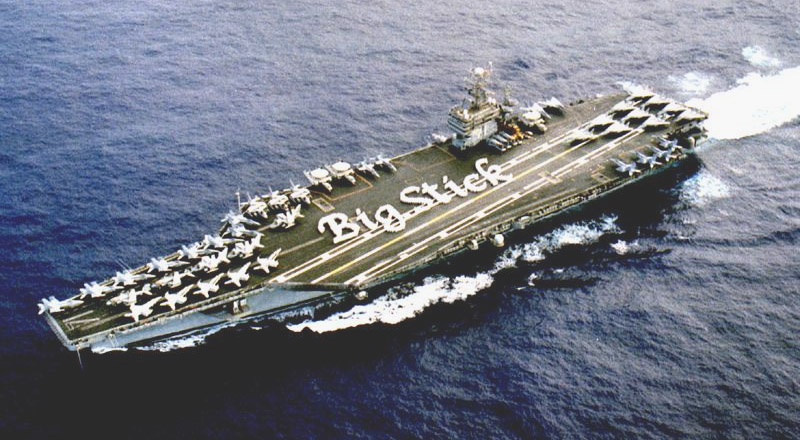
From 10 January 2000 she entered her PIA at Norfolk but the September 11 attacks rushed her 7th deployment, on 19 September 2001 this time with Carrier Air Wing One (CVW-1) and 15 October she entered the North Arabian Sea and Carl Vinson to strikeds on al-Qaeda in Afghanistan (Operation Enduring Freedom). She would spend 160 days at sea, a record since WW2, earning a new Navy Unit Commendation, 2001 Battenberg Cup, and Battle “E”, followed by a new PIA at Norfolk.
Teddy R. sailed for a month-long training off Puerto Rico and crossed the Atlantic to the Mediterranean with the Strike Fighter Squadron 201 from NAS Joint Reserve Base Fort Worth in Texas, added to CVW 8, a first since the Korean War. On 22 March 2003 with her sister USS Harry S. Truman she took part in Operation Iraqi Freedom before being back on 26 May, earning a Meritorious Unit Commendation, Navy Unit Citation, Global War on Terrorism Expeditionary Medal.
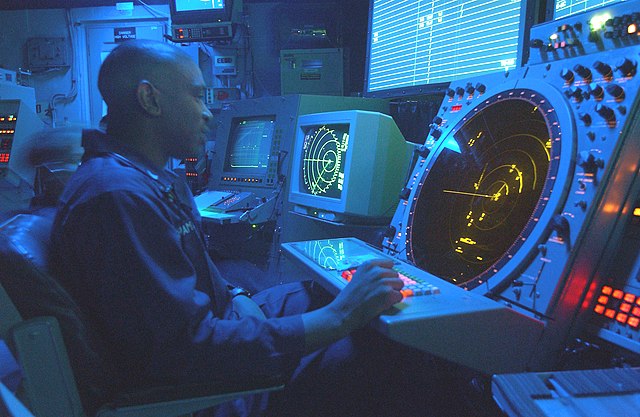
On 19 February 2004 the carrier entered a 10 month DPIA at NNSY Portsmouth, completed on 17 December 2004. She departed on 1 September 2005 with CVW-8 for the Persian Gulf Operation Iraqi Freedom also the last use for her ageing F-14 Tomcats, another cold war legacy type going away, its retirement being planned for 2006. These were the VF-31 (Tomcatters) and VF-213 (Black Lions). She was back home on 11 March 2006, earning the “Jig Dog” Ramage Carrier/Carrier Air Wing Operational Excellence Award for the best performance as integrated unit, a rare distinction.
On 7 March 2007, she has a 9-month PIA in Norfolk, and she was back at Naval Station Norfolk on 28 November 2007, soon joining the Joint Task Force Exercise 08-4 Operation Brimstone off North Carolina (21-31 July 2008) with notably HMS Ark Royal, USS Iwo Jima, Brazilian frigate Greenhalgh, French SSN Améthyste.
Leaving Norfolk on 8 September 2008 for the Middle East with CVW 8 on 4 October 2008 she went though Cape Town, South Africa, a first since the 1970s. Later she stopped at Jebel Ali (UAE) and took her post for Operation Enduring Freedom, with 3,100 sorties, 59,500 Ib. ordnance against ISAF in Afghanistan. She was relieved by USS Eisenhower on 21 March 2009 and was back on 18 April. On 26 August 2009 Northrop Grumman started her Refueling and Complex Overhaul in Newport News, until August 2013. After post-overhaul sea trials, qualifications on 14 September she started her departure while testing the X-47B drone aboard on 10 November. It was announced she would be homeported to San Diego on 15 January 2014 in place of USS Ronald Reagan, which was to be relocated to Japan in 2015. On 4 March 2015, during a training off Florida she was “mock-sunk” by the French SSN Saphir.
On 11 March 2015, with CST 12 she departed Norfolk for a world tour and the 5th, 6th and 7th Fleets, deploying the NIFC-CA Carrier Strike Group system before heading for San Diego. On 20 April 2015 while escorted by USS Normandy she was deployed off Yemen to blockade the Houthi rebels during the civil war.
In early November 2015, with USS Lassen she went through the South China Sea (freedom of navigation operations against PLAN claims).
TDR was back in San Diego on 23 November 2015, having flown 1,800 sorties against ISIS in Iraq-Syria for Operation Inherent Resolve, dropping one million pounds of ordnance with Carrier Strike Group 12 and deploying for the first time the E-2D Advanced Hawkeye and last the HH-60H Rescue Hawk and SH-60F Seahawk.
On 6 October 2017, she left San Diego to join agains the 7-5th Fleets with Carrier Strike Group 9, CVW 17, starting an exercized on 8 November with Ronald Reagan and Nimitz in the Sea of Japan, and by May 2019, Exercise Northern Edge 2019, while CVW 11 was transferred on board. By March 2020 escorted by USS Bunker Hill she was at Da Nang for an official visit and in July 2021 was swapped to HP Bremerton, prepared to operate the F-35 for 16-18 months. She made her sea trials in March 2023 and is schedule to move to San Diego (to be continued).
In March 2020 USS Theordore Roosevelt had three contamination during COVID, and this reached 100 and later 585, Captain Crozier being relieved for his management of the outbreak by Navy Secretary Thomas Modly, the latter being later forced to resign and Crozier rehabilitated.

 USS Abraham Lincoln (CVN-72) 1988
USS Abraham Lincoln (CVN-72) 1988
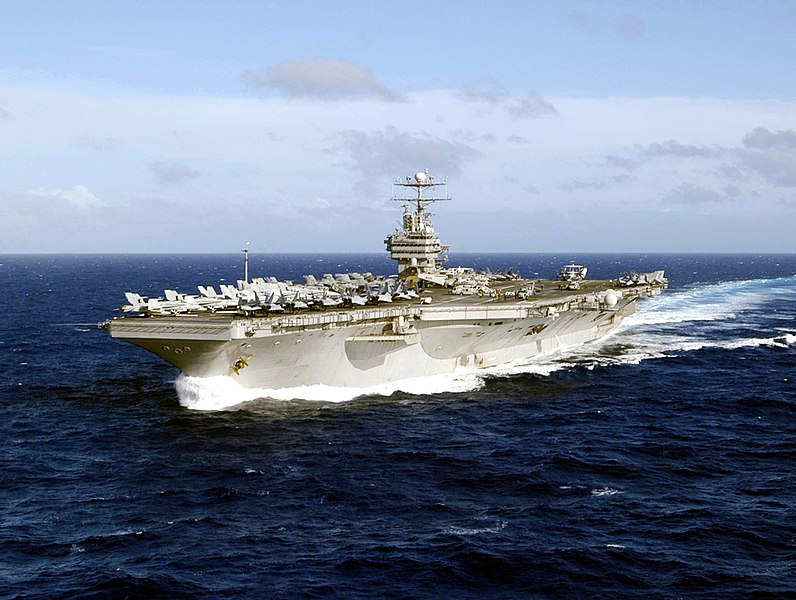
USS Abraham Lincoln (the naming was a return to more consensual choices after Carl Vinson), confirmed later by Washington) was commissioned on 11 November 1989. After sea trials, shakedown working out this and fixes, she was transferred to the Pacific in September 1990, taking part while underway to the Gringo-Gaucho exercize with the Argentine Naval Aviation. From 4 October she formed CTG 24.8 with USS Doyle, USS Pawcatuck and on 5 November stopped in Valparaíso while the Frente Patriótico Manuel Rodríguez detonated a bomb in restaurant Max und Moritz wounding three sailors during the leave.
Her maiden Western Pacific deployment started on 28 May 1991 as Operation Desert Shield developed, and with Carrier Group Three (Rear Admiral Timothy W. Wright) descorted by DesRon 9 (7 ships) and CVW 11 she rushed towards the Indian Ocean, but was diverted for the evacuation operations after Mount Pinatubo eruption on Luzon, taking part in Operation Fiery Vigil, moved over 45,000 people from Subic Bay NS to Cebu, Visayas, the largest peacetime evacuation of active military personnel in history. She arrived later in the Persian Gulf and started missioned over Iraq and Kuwait and provided support for the US troops during Desert Storm. She was back later at NAS Alameda on Ship’s Restricted Availability for minor maintenance and refitting.
From June 1992 she became Carrier Group 3 flagship and inOctober was assisting US efforts off the coast of Somalia, flying patrols over Mogadishu for Operation Restore Hope.
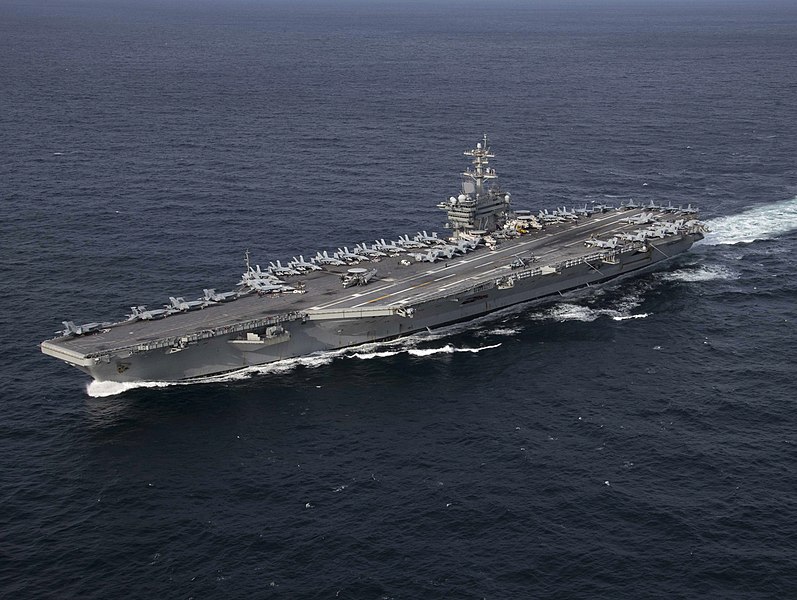
She became later the first Pacific Fleet carrier to integrate female aviators after the 28 April 1993 reforms. Leaving San Diego on 24 October 1994 she had Lt. Kara Spears Hultgreen (female F-14 Tomcat pilot) died when her plane crashed into the sea after a compressor stall dueinf the final approach, shutting the engines. Reacting promptly, she aborted the landing and veered to avoid collision, but inverted and went down. Radar officer Lt. Matthew Klemish ejected and was rescued while but Hultgreen ejected too late and hit the sea.
The carrier’s 3rd deployment started by April 1995 in the Persian Gulf for Southern Watch and Vigilant Sentinel. During a RAS she collided with USS Sacramento which had steering difficulties. She hit her port side and badly injured a female crew in the berthing area while holing the superstructure and damaged the TACAN room. Sacramento was repaired at Jebel Ali in UAE. But the carrier resumed her mission taking part in Operation Infinite Reach.
Her 4th deployment in June 1998 in the Persian Gulf was for operation Southern Watch and hger group launched Tomahawk missiles as ordered by President Bill Clinton after the bombings in Kenya and Tanzania. The carrier later receives the Armed Forces Expeditionary Medal, and her battle group the Meritorious Unit Commendation ribbon.
Her 5th deployment from August 2000 in the Persian Gulf for Southern Watch earned her another Navy Meritorious Unit Commendation, and Arleigh Burke Award. She was back home on 11 September 2001 and back at sea on 20 July 2002 for Operation Enduring Freedom. This also included Operation Southern Watch. She stopped in Perth and later returned to the gulf for Operation Iraqi Freedom making an extra stay until 6 May 2003. Rear Admiral Kelly famous “Get over it” in his speach to the crews became a running joke aboard the ship, ending on a deployment patch for Westpac 2003. She was back home on 2 May 2003
Next USS Abraham Lincoln provided the opening strikes of Operation Iraqi Freedom as part of 16,500 sorties, 1.6 million pounds of ordnance delivered by the Navy in thus operation. VS-35 “Blue Wolves” delivered fuel to these strike aircraft all along, and it became the largest aerial refueling in carrier aviation history. She was back home by May 2003, visited by President George W. Bush shile arriving in San Diego and moving to Everett, Washington. This was the occasion to display the somewhat controversial (later) huge banner ‘Mission Accomplished.’ explained by her 290 days nuclear-powered aircraft carrierdeployment, a record broken in 2020.
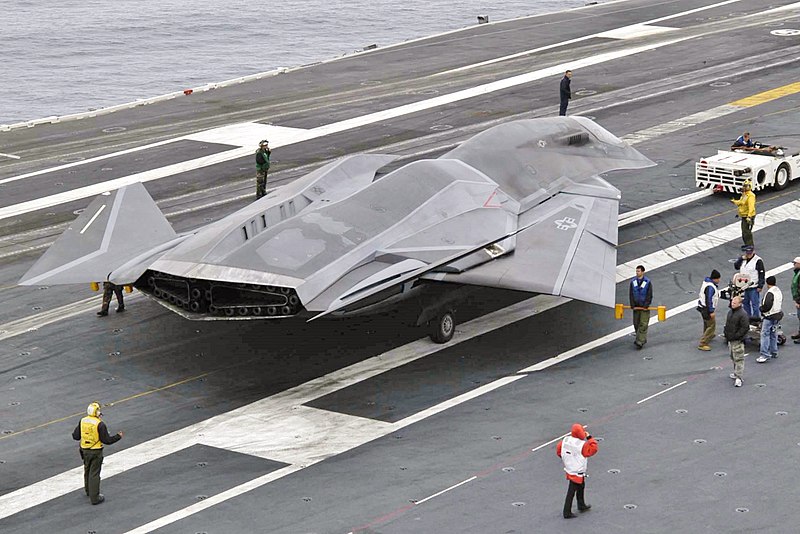
By June 2004 after a refit, she hosted the film “Stealth” featuring the fake F/A-37 Talon operating from the carrier. From October her unit became Carrier Strike Group 9 and she stopped underway to Hong Kong assisting after an earthquake struck southern Asia (26 December 2004) notably towards the tsunami-struck coast of Sumatra (Operation Unified Assistance). Apart the helicopter ballet, research and rescue, food delivery, she provided a potable water manifold bringing fresh water to Aceh Province and delivered 5,929,000 pounds (2,689,000 kg) of relief and humanitarian supplies, later earning the Humanitarian Service Medal.
By mid-January 2005 she left Indonesia to train while hospital ship Mercy arrived in between. By 7 March–27 May 2005 she had an overhaul in Everett until 26 August 2005. She then trained with CVW-2 in the northern Pacific and was part of the Joint Task Force Exercise 2005 (southern California) in October-November 2005 (JTFEX-05) with the USS Mobile Ba, Russell and Shoup, and her sister USS Ronald Reagan. By December 2006 she left for Puget Sound and a refit on a record 89 days. By 5 January 2006 she left Everett, to San Diego, for training and post-refit completed on 26 March 2007 and she returned in operation under command of Rear Adm. Scott R. Van Buskirk.
On 29 August 2006, Lincoln was swapped to Kitsap (Bremerton), entered Dry Dock at Puget Sound for Incremental Availability (DPIA) maintenance until 18 December, leaving the next 26 June 2007 for sea trials and head back to Everett. After flight deck carrier qualifications in 12–15 July she carried Carrier Air Wing 2 and proceeded to weapons drills with her new RIM-7P NATO Sea Sparrow on BQM-74E Chukar target drones.
She experienced an helicopter crash on 11 November 2007, all seven crewmembers rescued.
Until 30 January 2008 CSG9 conducted ASW exercises and took part in JTFEx 03–08 off southern California. Secretary of the Navy Donald C. Winter visited her on 20 January for the simulated air attack on the CSG. Next was a new planned incremental availability maintenance at Puget Sound. In 2001 she earned an “E” of excellence and combat readiness and the Navy announced by December 2010 that she would leave Everett for USS Nimitz for her refueling and complex overhaul at Northrop Grumman Newport News in 2013.
In 2012 however escorted by USS Cape St. George she visited the Gulf of Thailand and Laem Chabang and later entered the Persian Gulf at a time of great tensions with Iran. She relieved USS John C. Stennis. She later transited the Suez Canal on 16 July 2012, crossed Gibraltar on 26 July and arrived at Norfolk on 7 August for her incoming refit (RCOH).
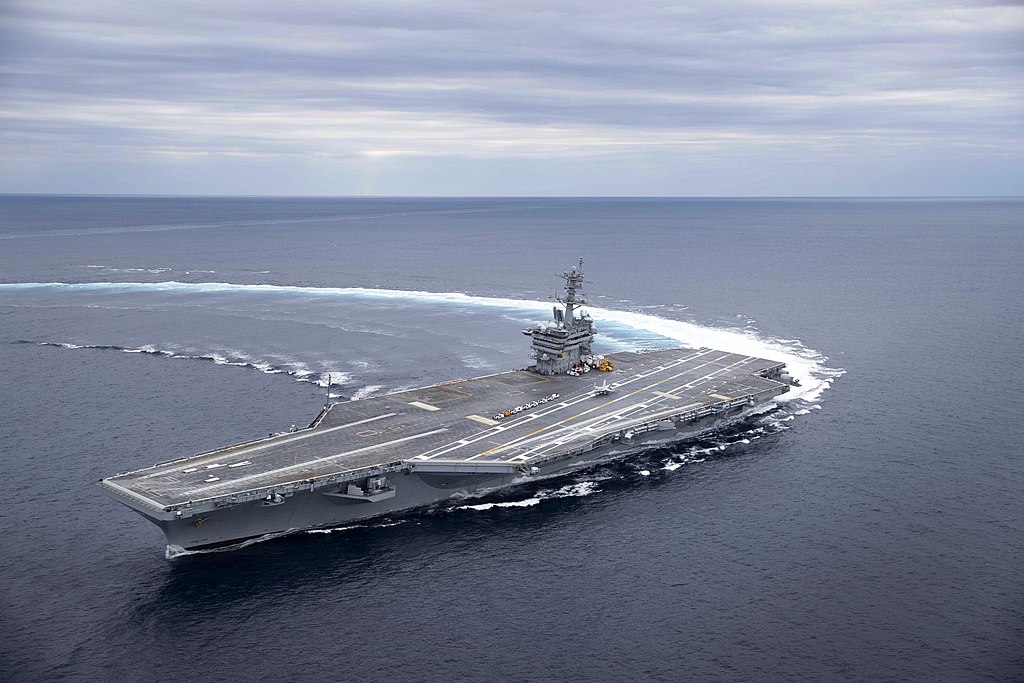
However the refit was postponed due to budget sequestration issues. It proceeded until 2017 and she was underway for sea trials in May. She was “ready again” on 12 May, deployed with USS Iwo Jima and USS New York to provided assistance after Hurricane Irma, joining USS Farragut.
From 2 August 2018 she was scheduled to be based in San Diego (home port shift for three carriers) and so, the Pacific Fleet. By late August 2018 she hosted VFA-125 and its F-35C for intensive trials. The ship was also part of the shooting of Top Gun: Maverick off Virginia.
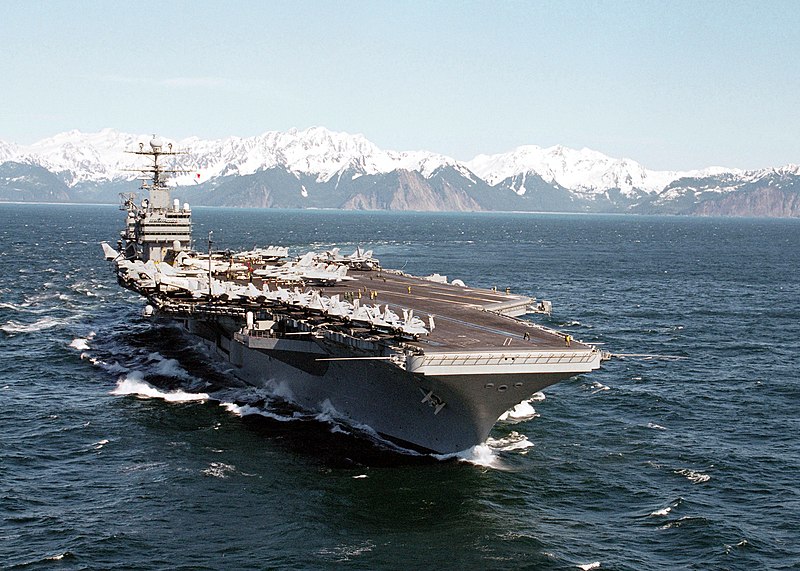
By April 2019, with CSG 12 she departed Norfolk for 6 month after which she reached San Diego. Thus included the Mediterranean, Persian Gulf, Indian Ocean, South China Sea, and across the Pacific to California. But on 5 May 2019 she was rerouted due to tensions in Iran, operated with USS John C. Stennis as the 6th Fleet’s core.
She arrived at San Diego on 20 January after 295 days at sea.
By 18 December, her early history with women in the service was confirmed when the Navy announced her new captain would be Amy Bauernschmidt for the summer of 2021, a first for any aircraft carrier anywhere.
On 31 August she had a MH-60S Knighthawk crash, with five crew members killed, one rescued. By January 2022 she hosted VMFA-314, a first permanent Marines squadron. She relieved as planned in Tokyo USS Ronald Reagan and took part in RIMPAC 2022. She also suffered a minor fire injuring 9 sailors on 29 November. Data is still in collection for 2023.
 USS George Washington (CVN-73) 1990
USS George Washington (CVN-73) 1990
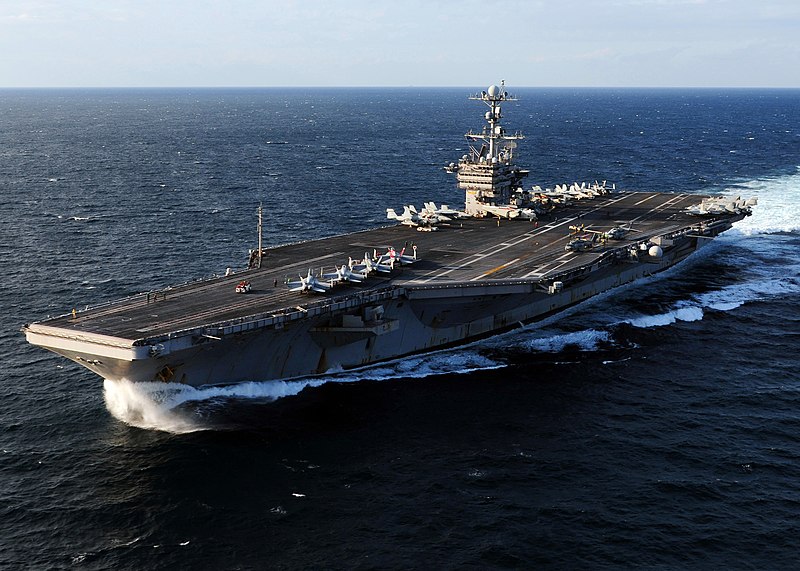
Built at Newport News like the others, USS Georges Washington was commissioned in 4 July 1992. There are mising logs here. It is assumed from 1992 to 1994 she prepped the usual way, meaning sea trials, shakedown, post-fixes, then extensive training, flight qualification for her first air group, weapons and sensors drills until she is considered “ready” for action. It is assumed she served in the Pacific in 1995-2000, with yearly deployments. This section is going to be completed.
USS George Washington was deployed to protect New York City after the September 11 attacks and on 20 February 2004, made her sixth deployment in the Gulf of Aden, with extensive operations in the Persian Gulf.
She was drydocked from 28 January 2005 for her DPIA, upgraded and maintained for 11 months, notably receiving new jet blast deflectors, having one Phalanx CIWS and one Sea Sparrow replaced by two Rolling Airframe Missile launchers. She was back to HP Norfolk on 17 December 2005 and on 1st December she was to replace USS Kitty Hawk at Yokosuka Naval Base in Japan, first nuclear-powered surface warship permanently stationed the U.S. The Navy deployed considerable effort to convinced the Japanese public, even creating a manga with locals about life aboard the carrier.
The carrier with CVW-17 left Norfolk on 4 April for a SOUTHCOM’s “Partnership of the Americas” training starting in the Caribbean Sea and south american port visits escorted by USS Monterey, the destroyer Stout, and frigate Underwood. She was back in Norfolk on 24 May.
On 7 April 2008, with Carrier Strike Group 8 aboard on her way to Yokosuka around South America she took part in the Gringo-Gaucho maneuvers with Argentina, arrived in Hawaii, landing CVW-17 and Carrier Strike Group 8 as she was to replaced them by Carrier Air Wing 5 at NAS Atsugi, arrier Strike Group 5 at Yokosuka NB but during the transit, she took part in Unitas with the Brazilian and Argentine navies, stopping on 22 April 2008 in Rio de Janeiro and crossing the Magellan strait on 9–10 May.
However on 22 May 2008 a fire broke out, injuring 37 sailors. The incident was reported “serious” and after enquiry it started in the air-conditioning and refrigeration space, plus an auxiliary boiler room, spreading via a cableway and ventilation ducting. It was battled over and extinguished after 12 hours and became the largest since the 1967 USS Forrestal fire.
Yje investigation showed it started with unauthorized smoking, and in the same room as a 115 US gallons (440 L) of flammable refrigerant compressor oil, improperly stored. On 27 May, she stopped at NAS North Island, San Diego for repairs (which took longer and cost $70 million). Kitty Hawk replaced George Washington for RIMPAC 2008 and had to wait for the turnover in Hawaii.
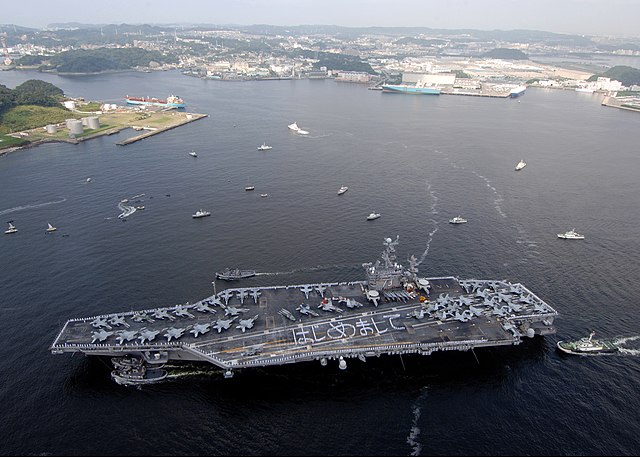
On 30 July 2008, Admiral Willard relieved Captain David C. Dykhoff speaking of “substandard performance.” and six other sailors disciplined, two non-commissioned officers guilty of negligence and dereliction of duty while at the other time, the Navy and Marine Corps Medal was awarded to Senior Chief Petty Officer Keith Hendrickson for his actions during the fire. Captain J.R. Haley took command of George Washington and she arrived in Hawaii, was transferred CVW 5 and made her way to Yokosuka on 25 September 2008, met by local protesters.
In June 2009, 15 sailors were expelled from the service for drug use. On 2 July with USS Cowpens the carrier arrived at Gage Roads, Perth, the crew had a leave in Fremantle and Perth. Later she took part in Exercise Talisman Saber off the Northern Territory. In August she was in Singapore and later made a goodwill visit to Manila Bay, the crew later visiting Corregidor.
In August she took part in the Indonesian Fleet Review “Sail Bunaken 2009” with ships from 40 nations while CVW 5 made demonstrations and fly-by. She was back home in Yokosuka by 3 September for a maintenance.
In May 2010 she was at sea for trials and by 21 July she stopped in Busan for a port visit and exercise Invincible Spirit in the Sea of Japan, which was also a multitaleral show after the sinking of ROKS Cheonan. Washington latter stopped also in Da Nang and took part with exercises with the ROKN after the shelling of Yeonpyeong. She also took part back in Japan to the disaster relief after the 2011 Tōhoku earthquake and tsunami and Fukishima tragedy. Radiations forced her to leave port before schedule, and she was moved to Sasebo, returning to Yokosuka on 20 April 2011.
On 22 November 2011, USS George Washington concludes this year patrol, stopping in Thailand, South Korea, Singapore, and Hong Kong, for port visits and joint training exercises. She also conducted dual-carrier operations with USS John C. Stennis.
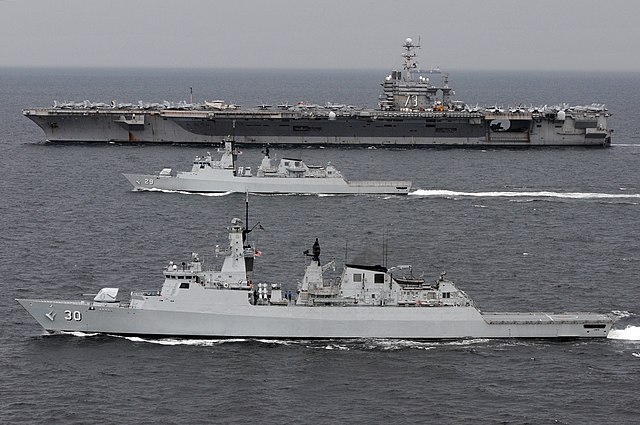
USS George Washington underway with the Royal Malaysian Navy Lekiu-class frigates KD Jebat and KD Lekiu (foreground) during a transit of the Andaman Sea
On 8 February 2013 she had her mid-life complex overhaul postponed due to the upcoming budget sequestration. On 4 October 2013 she stopped at in Busan and later visited Victoria Harbour in Hong Kong. On 11 November she took part in a humanitarian mission in the Philippines (Operation Damayan) after Typhoon Haiyan. She was back to HP on 6 December 2013.
In January 2014 she was to be replaced by USS Ronald Reagan at Yokosuka to proceed with her Refuelling and Complex Overhaul though budget reductions. It was rescheduled in 2016, for over $3 billion, and then later voted higher. Before that she took part in Exercise Talisman Saber 2015 with Australia and New Zealand. On 10 August she arrived in San Diego, conducted her turn over of crews with Ronald Reagan before leaving Southern California for Norfolk for her mid-life RCOH at Newport News, but was delayed to take part in October 2016 to Haiti to post-Hurricane Matthew aid.
The Overhaul proceeded between 2017 and 2023, marred by budgetary disputes, COVID 19 and questions of decommissioning USS Nimitz.
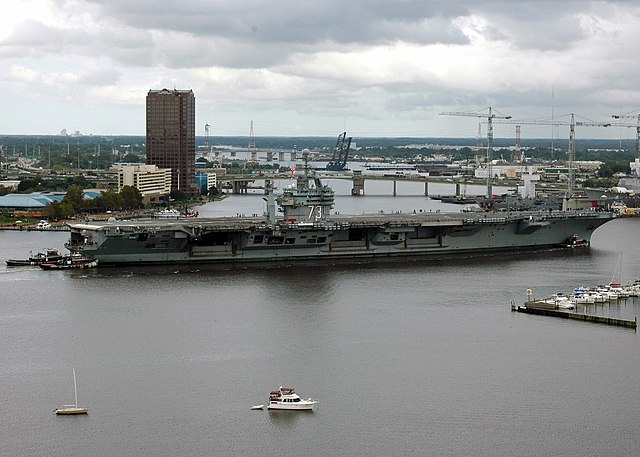
On 4 August 2017 the operation starts in Dry Dock #11 and is delayed until early 2023 as a target date with re-delivery completed in May 2023.
The ship also experienced 9 suicides however in 9 months, then a 10th attributed to the depression cause by the impression of “living at a construction site” with sailors relegated to maintenance or cleaning with a lack of sleep due to the excessive noise. Thus led to an investigation.
As for now, G.Washington is planned to return to Japan and replacing USS Ronald Reagan, departing in 2024. More to come.
 USS John C. Stennis (CVN-74) 1993
USS John C. Stennis (CVN-74) 1993
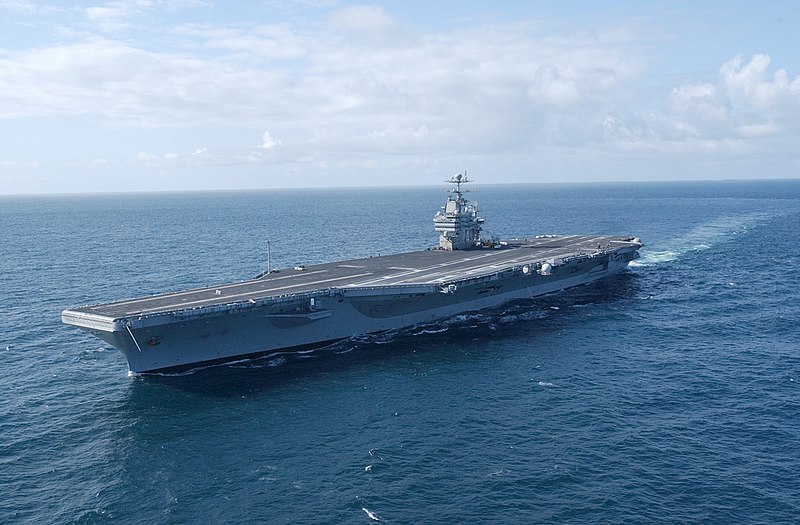
Commissioned on 9 December 1995, USS John C. Stennis was named after Senator John C. Stennis of Mississippi. The carrier was prepared at Naval Station Norfolk for her shakedown, and proceeded to flight deck certification in January 1996, notably with F-14B from VX-23 and proceeded to various drills along the east coast for two years. She also saw the first carrier landing of an F/A-18E/F Super Hornet, on 18 January 1997.
On 26 February 1998 she embarked Carrier Air Wing 7, leaving Norfolk, corssing the Atlantic, to the Mediterranean, Suez Canal on 7 March and Persian Gulf on 11 March 1998 over 8,020 nmi (14,850 km; 9,230 mi) in 274 hours at 29.4 knots (54.4 km/h; 33.8 mph) on average, relieving USS George Washington for Operation Southern Watch. She departed on 19 July 1998 for San Diego, California, her new home port, arriving on 26 August. By October she started a six-month maintenance and upgrade but she had a jet blast deflector collapsing which severely injured two sailors.
In May 1999, she ran aground close to the turning basin near North Island, having Silt clogging her intake pipes to the steam condensing systems se she had both reactor shut down for 45 minutes and had a cleanup worth $2 million.
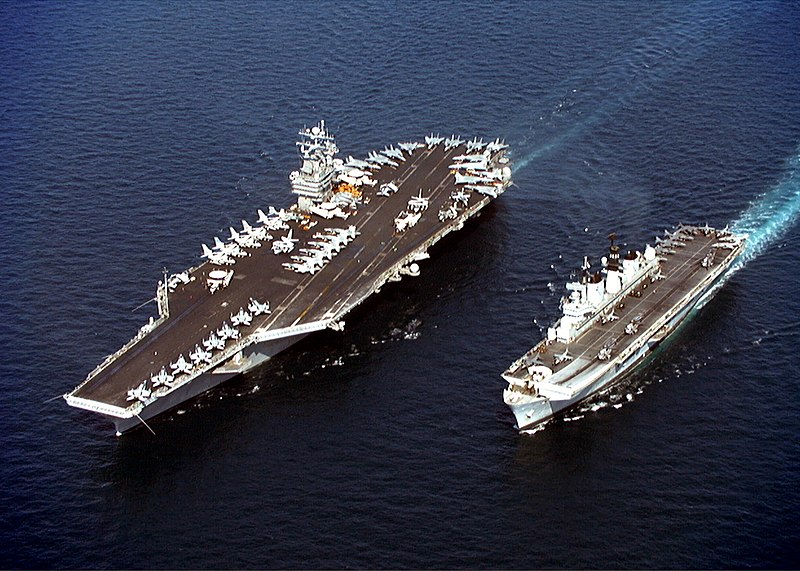
With USS Illustrious in the Persian Gulf in April 1998
On 7 January 2000 she departed for the Persian Gulf, relieving USS John F. Kennedy but before tha she also visited South Korea, Hong Kong, Malaysia, Bahrain and UAE but also Australia, Tasmania and Pearl Harbor during her trip back to San Diego in July 2000.
After the September 11 attacks she was part on the Noble Eagle operation off the West Coast as part of Carrier Group 7. From 21 May 2001 she had the world premiere of the Disney movie “Pearl Harbor” with more than 2,000 people attending the premiere, with the largest tribune and movie screen assembled on a flight deck.
On 12 November she started her third deployment with the 5th Fleet for Operation Enduring Freedom, back to San Diego on 28 May 2002. This was followed by a 7-month PIA.
Until 1st November 2004, USS John C. Stennis made a fourth overseas deployment between Exercise Northern Edge 2004 (Gulf of Alaska), RimPac off Hawaii, and with USS Kitty Hawk and the JMSDF off Japan, goodwill visits to Malaysia and Western Australia. The navy had her swapped HP to Naval Station Bremerton in Washington by January 2005. There she had a 11-month DPIA, gaining notably a new radar mast made of a new steel alloy, supporting a new heavier antennae but also a new integrated bridge system with modern displays.
By 20 January 2007, she departed for the Persian Gulf, joining USS Dwight D. Eisenhower, 5th Fleet, soon joined by eight other warships, notably USS Nimitz and USS Bonhomme Richard via the Strait of Hormuz. Back in Bremerton she departed later for a 6-month deployment to the western Pacific starting by January 2009. In April she was in Singapore but lost a sailor in a small harbor boat while securing the drain from the aircraft catapults.
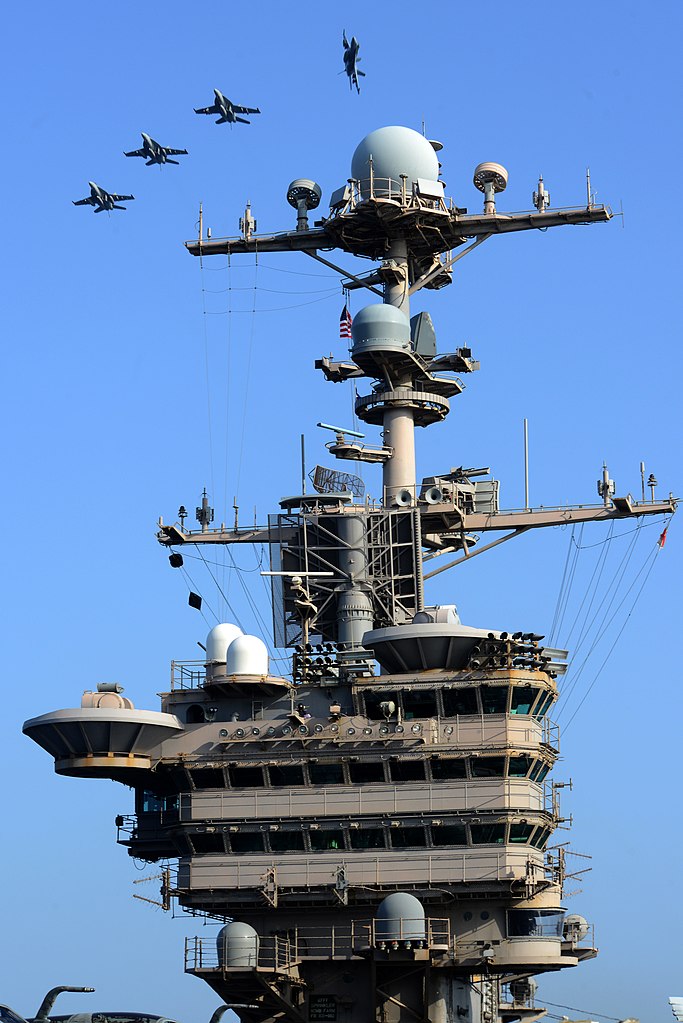
On 29 April XO Cdr. David L. Burnham was relieved by Rear Admiral Mark A. Vance over personal conduct.
After exercises with JMSDF and ROKN ships and exercise Northern Edge 2009, the carrier was back HP in July 2009, debarking Carrier Air Wing 9.
On 30 March 2011, a VMFAT-101 F/A-18C Hornet suffered an uncontained catastrophic engine failure, exploded and caught fire just before launch from John C. Stennis about 100 miles (160 km) off the By December 2011 she carried out the last navy flights over Iraq, an E-2C Hawkeye from VAW-112, ending Operation New Dawn.
On 7 January, John C. Stennis rescued the Iralian ship Al Mulahi seized by pirates. By 2 March 2012 she was back in Bremerton after a 7-month deployment, and departed back on 27 August 2012 for a new eight month deployment. By April 2013 she stopped at Changi Naval Base, Singapore, open to Local students. She stopped also to Pearl Harbor for a tiger cruise to San Diego and was relocated tp Naval Base Kitsap (Bremerton), having a 10-month deployment eventually, lauching 1,300 sorties over Afghanistan.
On 27 June she was sent in Puget Sound for PSNS & IMF and a 16 month DPIA, until 5 November 2014. In January 2015 she left Kitsap, Bremerton, hraded for Naval Magazine Indian Island, San Diego for her carier air group and remainder of her sailors and back to Bremerton.
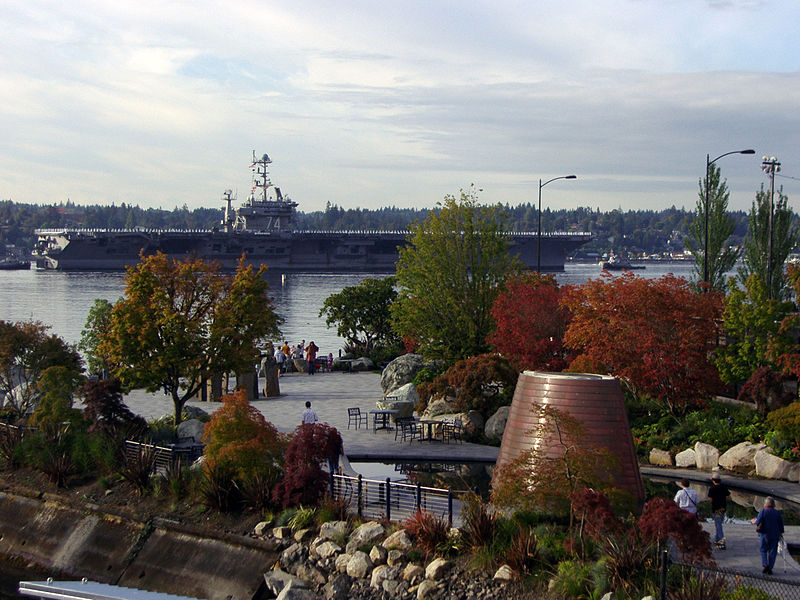
John C Stennis arrival in Bremerton
By January 2016 she left Kitsap for new Western Pacific deployment, stopping at Singapore and making bilateral exercise in the Philippines. By 26 April 2016, China denied her port visit to Hong Kong. On 10 August she was in San Diego to offload CVW-9 and was back to Kitsap after RIMPAC.
In she was in overhaul at Puget Sound.
In 2018 she was homeported to Norfolk, before her RCOH at Newport News, swapping places with USS Carl Vinson and Abraham Lincoln in San Diego.
By December 2018 USS John C. Stennis took part in Operation Freedom’s Sentinel in Afghanistan. She was back in Norfolk by May 2019, prepared for her refueling and complex overhaul in 2020 to be completed by 2025. More to come.
 USS Harry S. Truman (CVN-75) 1996
USS Harry S. Truman (CVN-75) 1996
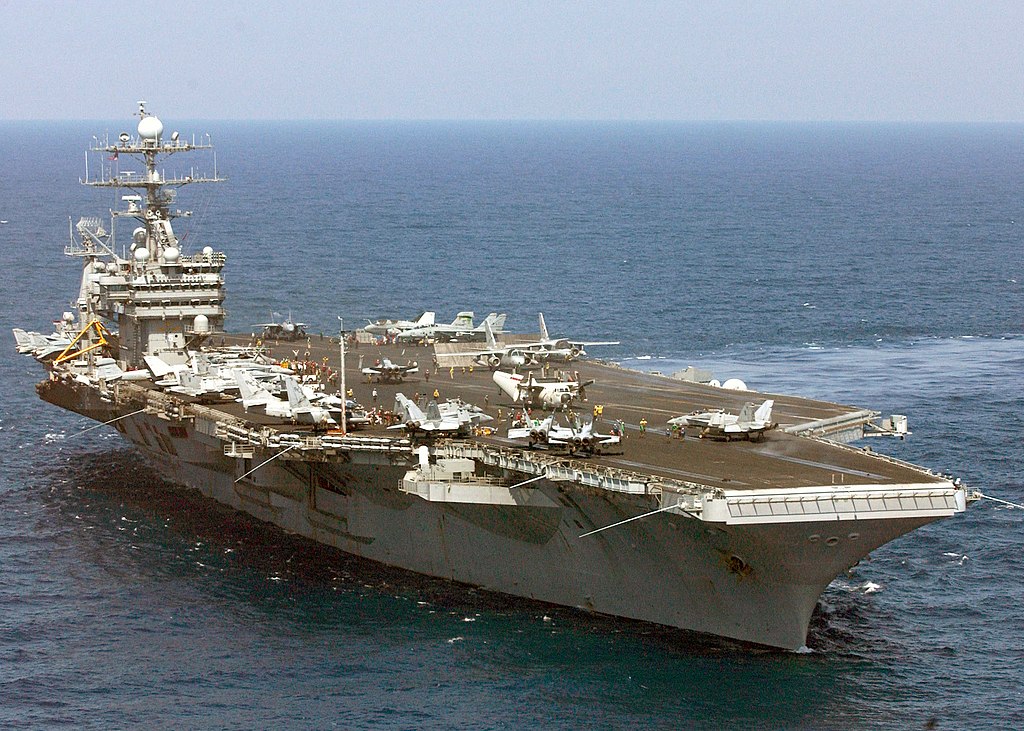
Commissioned on 25 July 1998, Harry S. Truman, named after the WW2 and first postwar president, had for keynote speaker during the ceremony President Bill Clinton. By August she left port for certifications, sea trials and half-shakedown with training exercises. By 28 November 2000 when declared ready she made her maiden deployment with Carrier Air Wing 3 (CVW-3), crossed the Altlantic, Mediterranean, Suez Canal before arriving in the Middle east to take part in Operation Southern Watch with Carrier Air Wing 3 (869 combat sorties, one strike on Iraqi target after a missile launched at the USN Security Council coalition forces). It was over on 27 April 2001 and she was back home on 23 May at HP Norfolk for her first PIA on 5 September.
On 5 December 2002, she left with CVW-3 aboard, stopping at Marseille, Souda Bay, Koper in Slovenia (a first for any USN carrier) and in 19 March-18 April accumulated 1,300 combat sorties during the 2003 invasion of Iraq. She stopped in Portsmouth on her way back to Norfolk on 23 May.
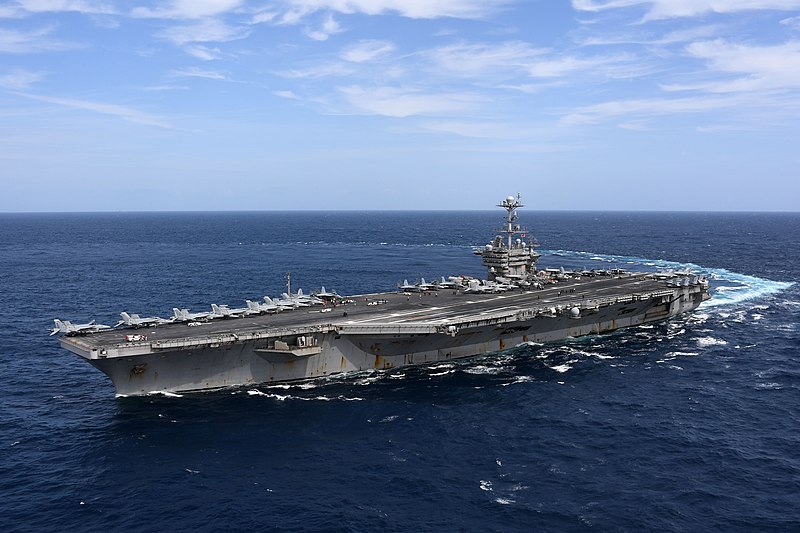
Underway in the Atlantic, 11 September 2018
In August 2003 she started her second PIA at Norfolk and by 2 June 2004 took part in Exercise Summer Pulse in the Mediterranean Sea, stopping in Naples, and taking part in Operation Majestic Eagle on the eastern Atlantic, back HP on 25 July.
By October 2004, she started her 3rd Med Tod, stopping at Souda Bay and later relieving USS John F. Kennedy on 20 November in the Persian Gulf. CVW-3 performed 2,577 sorties, 13,000 flight hours. She was relieved by USS Carl Vinson on 19 March 2005. She went back through the Suez Canal, via Portsmouth, to Norfolk on 18 April 2005.
On 1 September 2005 after Hurricane Katrina she sailed for the Gulf of Mexico and from 4 September became flagship for the relief naval task force under Rear Adm. Joseph Kilkenny.The ship provided notably desalinated water transferred via helicopter. She was back in October 2005 after five weeks there.
In January 2006, USS Harry S. made another PIA with several system upgrades, over by December and deployed from April 2007. She had on 15 August an E-2C Hawkeye crashing after taking off killing all three crewmembers. Her fourth extended deployment in the Middle east ended in June 2008, but she ended in NS Mayport in Florida for the three-day “Tiger Cruise” to Norfolk, aslo being awarded her fourth Battle “E” award for the East Coast by early 2009, and hosting a concert of Jimmy Buffett on 28 January.
After her 7 months PIA Fin Portsmouth she started a same lenght deployment with the 5th-6th Fleet in maritime security operations -notably anti-piracy patrols) and on 21 May she led 11 American warships and 5,000 men into the Suez Canal. By June she had visited Marseille, Dubai, Manama, Souda Bay, and she was home on 21 December after a trip of 50,000 nautical miles and 10,000 sorties for Operation Enduring Freedom and Operation New Dawn.
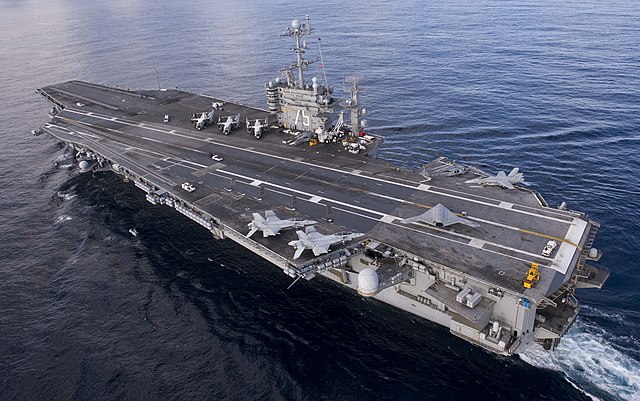
On 2 February she won a 3rd Battle “E” an started a docked PIA by March. Upgrades included a new main mast, CIWS and missile upgrades, a new automated digital network system, overhauls for all her living spaces, piping, and paints. Captain Tushar however died after a hart attack on 8 November, replaced bu the XO until relieved by Captain Dee L. Mewbourne. By 7 April, she left Norfolk for sea trials over 90 days.
By 26 November 2012 she started testing the new X-47B unmanned combat air system, first aircraft carrier in naval aviation history test a large naval drone, over three-week of deck tests.
By February 2013 she sailed for another deployment with the USS Gettysburg and Carrier Strike Group 10, but it was delayed for budget sequestration, John C. Stennis being left alone in the Persian Gulf. It’s only by 22 July that she joined the 5th Fleet for Operation Enduring Freedom.
By 14 February 2014 she was awarded a new battle “E” and by 23 March she was relieved by sister ship USS George H.W. Bush.
By November 2015 she was assigned Carrier Air Wing 7 and joined the 6th Fleet escorted by USS Anzio and DesRon 28 (Bulkeley, Gonzalez, Ramage and Gravely). She was visited in December by Djibouti President Ismail Omar Guelleh. While she transited the Strait of Hormuz, she was fired upon by Iranian unguided rockets, landing 1,500 yards (1,400 m) away escorted by USS Bulkeley and the French frigate Provence.
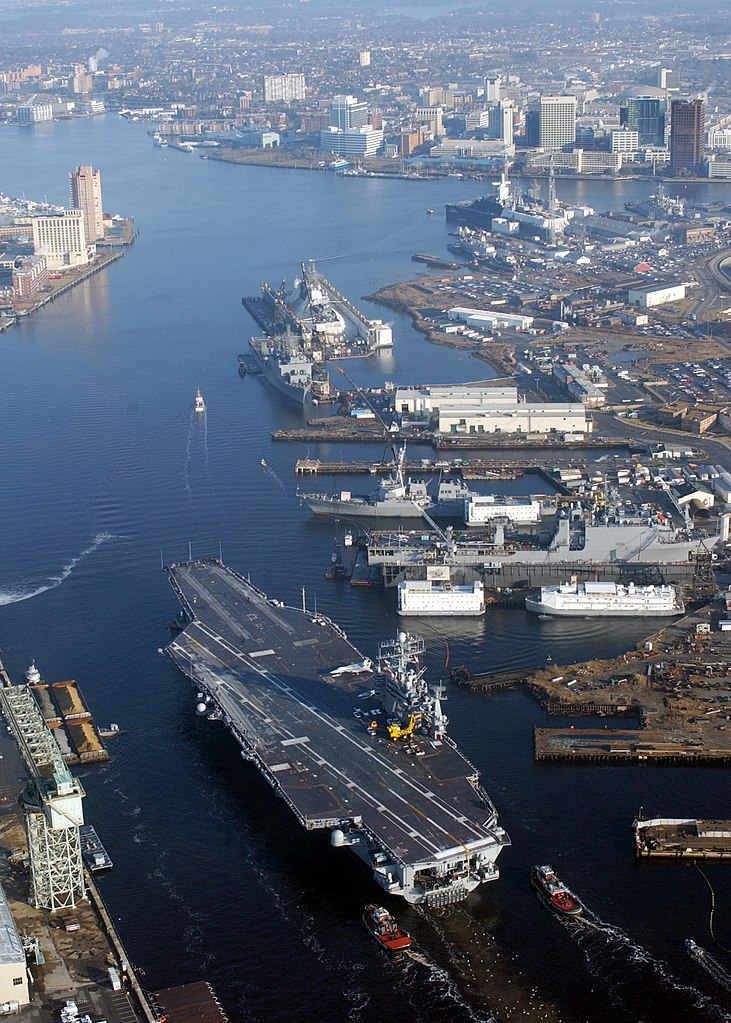
She started sorties on 29 December against ISIS and when folding up by mid-April 2016, she had dropped 1,118 bombs breaking USS Theodore Roosevelt’s record in 2015.
By 12 January 2016 she was flew over by an unarmed Iranian drone in international waters, photos being taken as announced by Iranian Medias.
She became flagship of Carrier Strike Group 8 for her 8-month deployment against ISIL (Operation Inherent Resolve) and by June her F/A-18 Hornets multiplied air strikes against ISIS targets, a first since 2003.
Later she was assigned CVW-1 and by late August back home she entered a 10-month PIA, until 21 July.
She departed again with Carrier Strike Group 8 in the Middle East and Europe from April 2018, back to Norfolk on 21 July and returned in the Western Atlantic by August for summer exercizes, notably
in October Trident Juncture off Norway. By 27 February the next year, her midlife refueling and overhaul was scheduled for 2024 but likely postponed due to budget constraints. Some congressment even announced a possible decommission instead. The USN vehemently opposed this to maintain a strict 10 carrier fleet, the legally mandated level. It’s by May the President Trump overruled any decommission.
By late August she had an electrical distribution system malfunction. She departed by late October and arrived to join the 6th Fleet on 2 December 2019. By July 2020, she was back for a maintenance turn in Portsmouth. From December 2021 she operated in the Middle East again with CVW-1 but was rerouted due to the extermen tension between Russia and Ukraine and she stayed in the Mediterranean instead. By January 2022, she came under NATO’s Naval Striking and Support Forces command for an exercize. A first since the end of the cold war and good way to redynamize NATO while facing Russian aggression. In May she took part in vigilance activity and Neptune Shield later in 2022.

On 8 July 2022 she lost an F/A-18E Super Hornet, blown overboard in heavy weather during a RAS (replenishment-at-sea). The plane was later spotted and recovered, later refloated and loaded on USNS Mendonca in Augusta. She was back in Norfolk by 12 September 2022. The rest of this story is still to be written.
 USS Ronald Reagan (CVN-76) 2001
USS Ronald Reagan (CVN-76) 2001
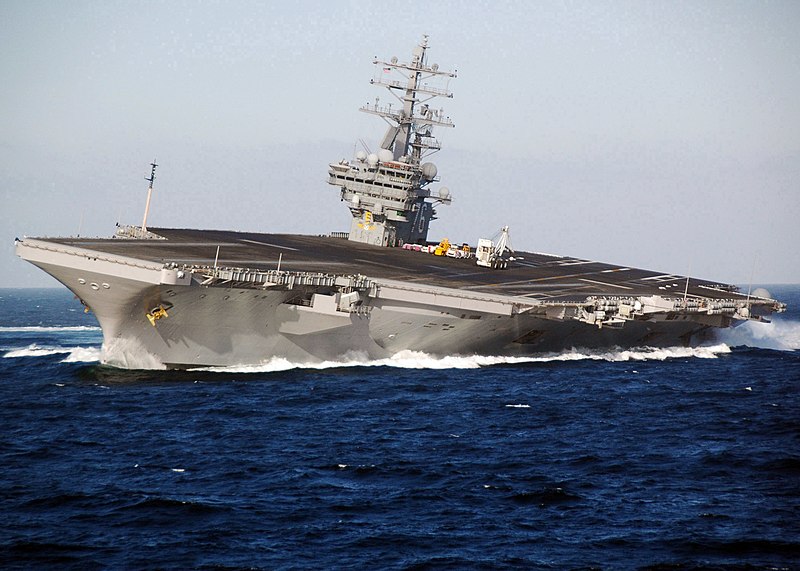
Commissioned on 12 July 2003, USS Ronald Reagan (the first carrier named after a still alive former president) and in 8 May 2004 after her post-shakedown availability she received all her flight deck certification, transiting from NS Norfolk via the Strait of Magellan to NAS North Island in San Diego underr command of James A. Symonds. Carrier Air Wing 11 only had 25% of its total strength, notably VFA-14 and VFA-41 (F/A-18E/F Super Hornet) and VAW-117 (E-2C Hawkeye 2000) HS-6 (SH-60F Seahawk), VRC-30 (C-2A Greyhound); She stopped along the way at Rio de Janeiro, on 5 June 2004 and was announced after arrival that her namesake just died, leading to a ceremony in his honor held onboard. She stopped in Valparaíso, Callao, before arriving to San Diego on 23 July 2004, being assigned to Carrier Strike Group 15.

She departed with USS Terry B. Kraft as captain on 4 January 2006 for her first deployment, for Operation Iraqi Freedom and Enduring Freedom and policing the Persian Gulf. On 28 January 2006 she experienced the crash of a F/A-18 Hornet while landing as she was off Brisbane, Queensland. It missed the cabled and skidded overboard aznd the pilot was rescued. She had issues with ger main condensers clogged with almost a ton of jellyfish which jeopardized the cooling of her main reactors. She was in the Persian Gulf by 22 February 2006 and back home in 6 July.
She left San Diego on 27 January 2007 for a “surge deployment” to the Western Pacific, replacing USSKitty Hawk in maintenance in Japan, as part of the Navy’s Fleet Response Plan, testing the flexibility of its forces under short notice. In January 2007 she earned her first Battle Efficiency “E”. On 15 December 2007 picking a distress call from a cruise ship off Baja she sent a SH-60 to rescue a teenager, and performed aaboard emergency appendectomy.
She would later perform humanitarian assistance/disaster relief in the Philippines on 24 June 2008 (Typhoon Fengshen) notably at Panay and the Central Visayas, round-flying her SH-60 Seahawk and C-2A Greyhound aircraft to deliver supplies, earning the Humanitarian Service Medal.
With the 5th Fleet from 28 August she launched more than 1,150 sorties over Afghanistan (Operation Enduring Freedom). On 25 September in the Gulf of Oman, she hosted the rock band Creed with the crew in attendance. She was back home on 25 November 2008, earning a second “E”.
On 28 May 2009 she was at sea with Carrier Air Wing 14, relieving the Dwight D. Eisenhower and starting strikes on 6 July. By early 2010 she received the Safety “S” Award and another “E” for combat efficiency.
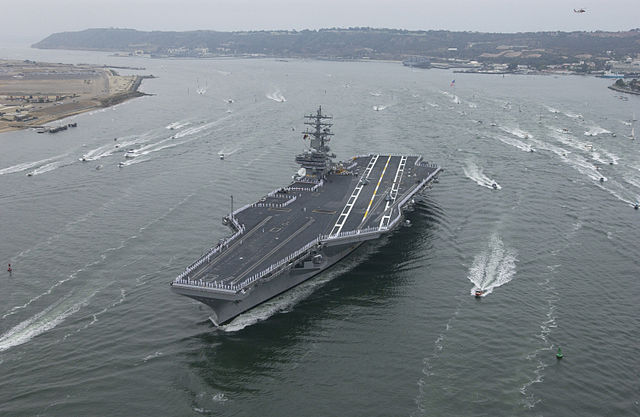
Starting from 19 May 2010 in Norfolk she had a 6-month PIA, a maintenance with technological upgrades. On 18 May 2010 she started her sea trials and was back to North Island on 19 May 2010. She departed for another deployment on 2 June 2010 with CVW-14 for flight deck certifications and later took part in RIMPAC, operated along southern California for her 2011 WESTPAC, assisting notably the cruise ship Carnival Splendor, loosing after a fire.
She departed on 2 February 2011 for Korea and was redirected towards Japan to provided assistance after the 2011 Tōhoku earthquake and tsunami (of Tsukushima fame). She stayed off Sendai acting as refueling station and doing relief missions with helicopters, measuring on 13 March 2011 the gamma shine from the Fukushima Daiichi Nuclear Power Plant, having to relocated to avoid the radioactive plume, which contaminated 17 crew members in the helicopters. On 23 March she performed a large scale radiation decontamination as per NBC prodecures, including the island, flight deck and checking all the interiors. She received in April 2011 Toshimi Kitazawa and the ambassador John Roos’s visit, praised for their assistance in what was “Operation Tomodachi”. She was back home on 8 September 2011, and announced her move to Puget Sound for maintenance in January 2012.
On 14 January 2014 she was supposed to replaced USS George Washington in the 7th fleet at Yokosuka by 2015. This was done in August, when G.Washington back from Japan and docking in San Diego alongside Ronald Reagan saw crews switching ships to minimize the number of sailors to move between San Diego to Japan, quite a disruption for the crew’s personal lives. USS Ronald Reagan replaced flagship of Carrier Strike Group 5, and embarked Carrier Air Wing Five (CVW-5). On 1 October 2015 she entered Yokosuka while her group returned to Air Facility Atsugi. The new carrier was also open to the public on 12 October.

She later made her annual patrol of the Western Pacific by October, being near-flew over by two Russian Tupolev Tu-142 bombers at low altitude, gently escorted by four F/A-18 Super Hornets. The carrier then multiplied fleet exercises with the JMSDF and ROKN and took part in a fleet review, visited by Prime Minister Shinzo Abe.
On 4 June 2016 she departed Yokosuka for the South China Sea, adding weight in a deliberation of the international tribunal regarding a dispute between China and Philippines over local waters. hThe carrier made a 53-day cruise followed by INSURV inspections. She weathered Typhoon Lionrock and took part in Exercise Valiant Shield 2016, then hit Guam, then performed Invincible Spirit with the ROKN in the Sea of Japan and Yellow Sea.
From 10 January 1017 she entered Selected Restricted Availability and on 7 May made her sea trials and annual patrol, the returned to port and later relieved her sister ship Carl Vinson off North Korea too alleviate tensions there. She stopped in Singapore and went to Australia for Exercise Talisman Saber, stopping at Brisbane and back to Japan on 9 August.[ On 8 September she returned off Korea after a missile launch over Japan and nuclear test and visited Hong Kong in October. After drills with the JMSDF off Okinawa and drills off Korea with the ROKN, she stopped in Busan.
On 29 October, she sent Super Hornets to intercept two Russian Tu-95MS bombers dircted to the carrier while near Japan, this time escorted by their own Su-35S escort fighters. Japan also launched its own, F-2, F-4 and F-15 fighters. USS Ronald Reagan lost her destroyers, sent for an exercize with the Indian Navy and later the JMSDF. In winter she performed more drills with Nimitz and Theodore Roosevelt, first time that three US carrier strike groups were reunited in Asia, a string show to China. They operated with the Japanese helicopter destroyer Ise and guided missile destroyers Inazuma and Makinami. Later their trained with seven South Korean vessels, notably their brand new Aegis-equipped destroyers. On 22 November she lost however a C-2A Greyhound in the Philippine Sea, coming from NAS Iwakuni with supplies. Eight of the 11 aboard were rescued.
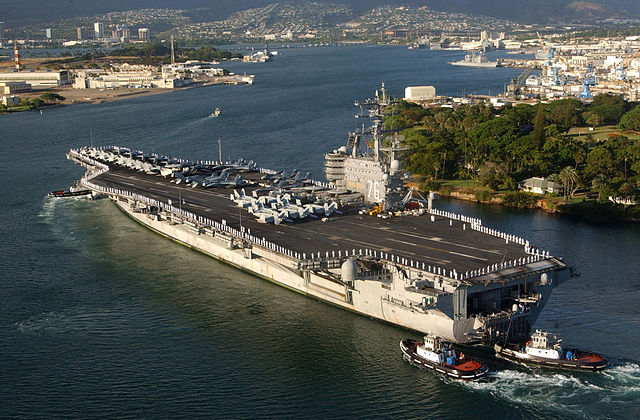
On 17 May 2018 Ronald Reagan mde her post-refit sea trials then departed for her Pacific Patrol but several weeks late due to extra repairs after issues revealed by sea trials. She trained off Iwo Jima and headed for the South China Sea, visited the Philippines and later took part in the Malabar 2018 exercise with Japan and India near Guam. Back to Yokosuka she left port to avoid Typhoon Jongdari and another on 7 August. On 31 August she trained with JS Kaga.
On 21 November she visited Hong Kong. By 24 August 2019 she was back in Yokosuka after Exercise Talisman Saber off Australia, Manila for a port visit and another run in the South China Sea and several exercises with Japan and Korea.
COVID 19 hit the crew on 27 March 2020, followed by a 48 hours quarantine. No further cases were detected. On 5 July 2020 she returned to the South China Sea with USS Nimitz. But by 26 June 2021, she was sent to the Middle East to cover the withdrawal of US troops from Afghanistan.
In May 2022 she was relieved by USS Abraham Lincoln at Sasebo and went for the Philippine Sea, then Singapore and Changi Naval Base by July for another run in the South China Sea while President Joe Biden tasked with Premier Xi Jinping over Nancy Pelosi’s visit to Taiwan. The carrier was to remained in these waters for the time being. Eventually by August 2022 she returned to Yokosuka, before making another regional patrol, stopping at Busan on 23 September and with her escort, USS Antietam and Robert Smalls dropped anchor near Tien Sa, Da Nang in Vietnam until the end of June. More to come.
 USS George H.W. Bush (CVN-77) 2006
USS George H.W. Bush (CVN-77) 2006
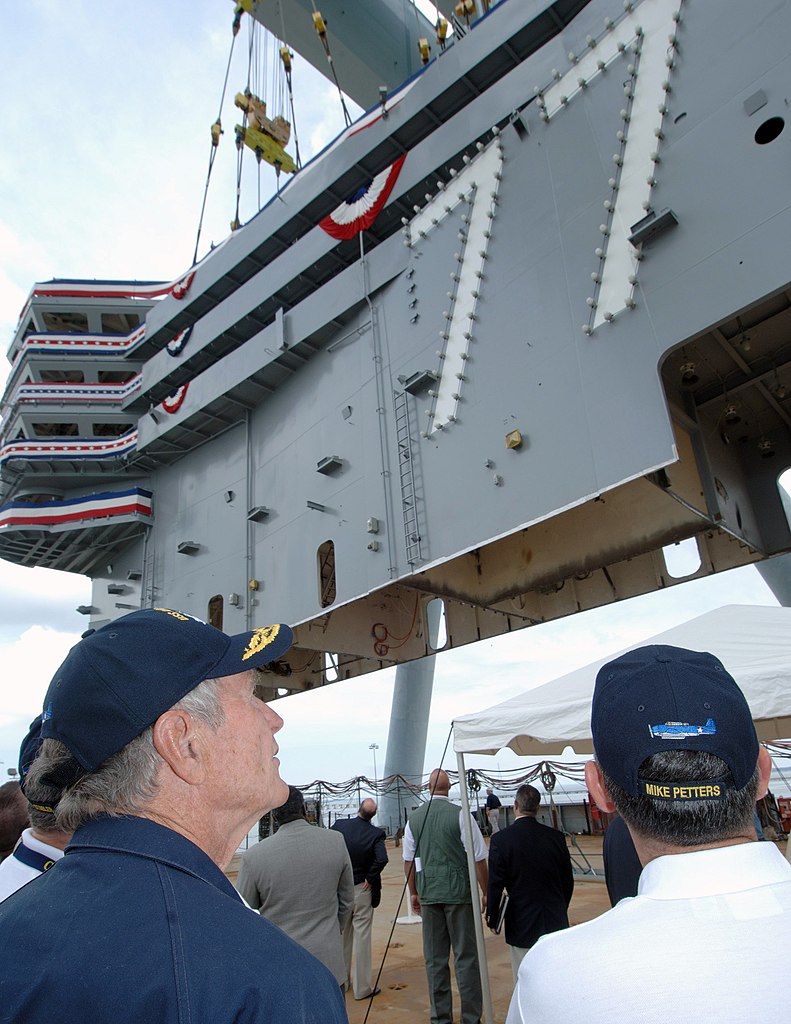
A showcase of the modular construction inaugurated by USS Vinson. The massive island is moved towards the flight deck to be installed, witnessed by G.W.Bush sr. and Jr.
USS George H.W. Bush was delivered to the Navy on 11 May 2009, made the first fixed-wing flights aboard on 19 May 2009 (with F/A-18 Super Hornets from NAS Patuxent River test center for certification) and by 26 May 2009, former president George H.W. Bush and his daughter Dorothy Bush Koch, flew aboard tp observe flight operations dueing her shakedown in the the Atlantic. The naming ceremony was a special occasion recalling the president’s WW2 years as a carrier pilot. The new ship made post-fixes at Northrop Grumman in Newport News shipyard; starting on 18 June plus post-delivery maintenance work (post shakedown availability or PSA). Assigned to Carrier Strike Group 2 (Rear Admiral Nora Tyson) she embarked Carrier Air Wing 8 (CVW 8) and departed with her four ships escort for a first deployment on 11 May 2011, to Britain for Exercise Saxon Warrior on the Western Approaches and the its ending ‘Thursday War’. After Portsmouth on 27 May she made it to the Mediterranean and Naples on 10 June 2011.
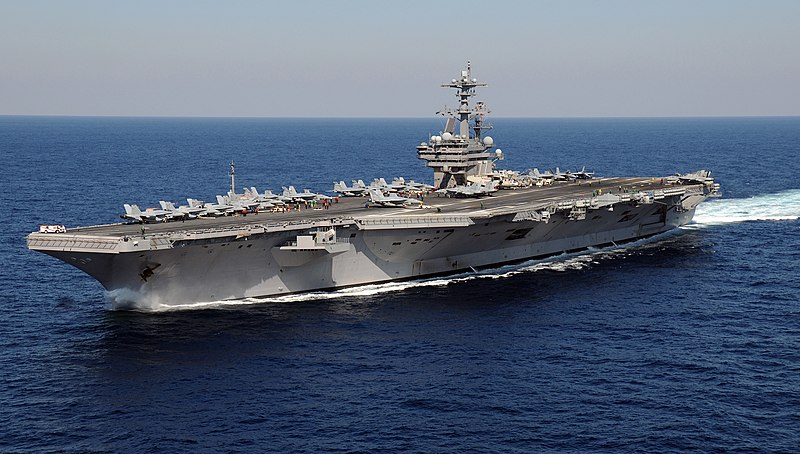
Back to Norfolk on 10 December 2011 after 7 months she was inactivated for a 4 month overhaul at Norfolk, plus short-term technical upgrades and by December 2012, completed her PIA maintenance cycle, followed by sea trials in December, training and qualification.
Her 2013 campaign saw the used for the first time of the MV-22 tilt-rotor aircraft from VMX-22 to replace the C2 Greyhound. She also tested the new mine-sweeping MH-53E helicopter (HM-14) and tests for the X-47B drone, first catapulting on 14 May 2013, first touch-and-go landing and take-off. She also tested a new torpedo self-defense system and was back to Norfolk on 24 May 2013.
On 15 July 2013 however her X-47B drone failed to land due to software bugs. Her 2014 was more operational however, with a Mediterranean deployment, going off southern Turkey, 500 miles away from Crimea while a border war between Ukraine with Russia started. On 9 March 2014 she was in Antalya, but later she proceeded through Suez in March 2014, relieving Harry S. Truman at its 5th Fleet post for maritime security operations.
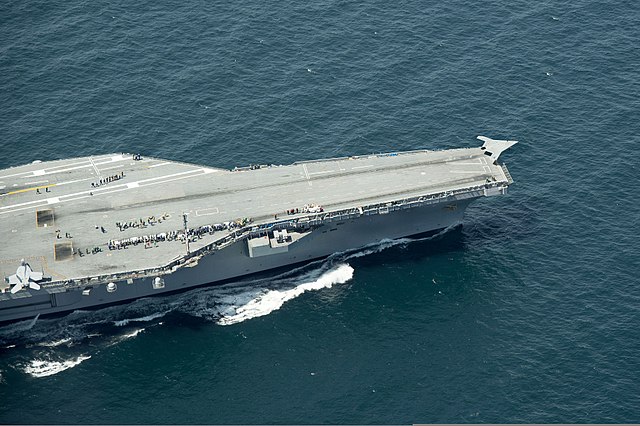
XB-47B Drone tests, a highpoint of her summer 2013 campaign.
By June 2014 in the Persian Gulf she stand ready against ISIL offensive. On 8 August two F/A-18F Super Hornets made their first strike on an ISIL mobile artillery cannon shelling Kurdish forces out of Erbil, as sanctioned by Pdt. Obama on 7 August. On 23 September both Hornets and Super Hornets hit targets in Syria such. The carrier was back home on 15 November.
She had 14-month shipyard availability at Norfolk and was underway on 21 January via Gibraltar, stopping later at Souda Bay in Crete, to resume her strikes against ISIL (Operation Inherent Resolve).
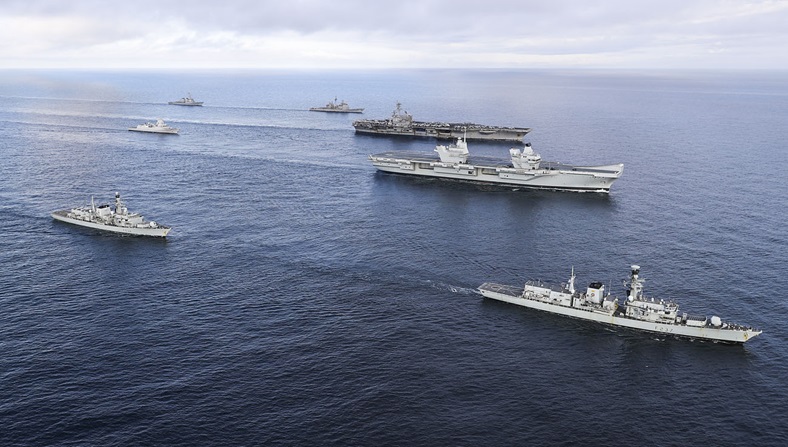
In July 2017 back to Britain for Exercise Saxon Warrior she operated with the Royal Navy, Bundesmarine, Royal Norwegian Navy and Swedish Navy. She had aboard the future crews of HMS Queen Elizabeth, which was still working out and present.
By May 2018 she took part in the Chesapeake Mission with the French Navy, having 12 Dassault Aviation Rafale M and a French E-2C Hawkeye from the Charles de Gaulle in refit at the time, to keep training. This was repeated regularly and was also an interoperability test. In other occasions, US pilots would land and take off from Charles de Gaulle, the only CATOBAR carrier in Europe (at least with NATO).
By February 2019, she was back in Norfolk for her 28-month DPIA but this marred as in the press, the Navy annonced on 24 September three suicides aboard George in one week, with two previously in 2017-2019 which raised some questions about the crew’s well being and morale.
On 30 July 2020, a few sailors were apparently infected by the COVID-19 during the summer but this was contained.
In August 2020, the carrier ended her period but was only capable to restart operations from 10 August 2022 with Carrier Air Wing 7 (CVW-7) in Carrier Strike Group 10 to relieve Carrier Strike Group 8 (USS Harry S. Truman) in the Mediterranean. This section is going to be completed the next years. Trust the press for updates anyway.
First Published on March 6, 2017
Read More
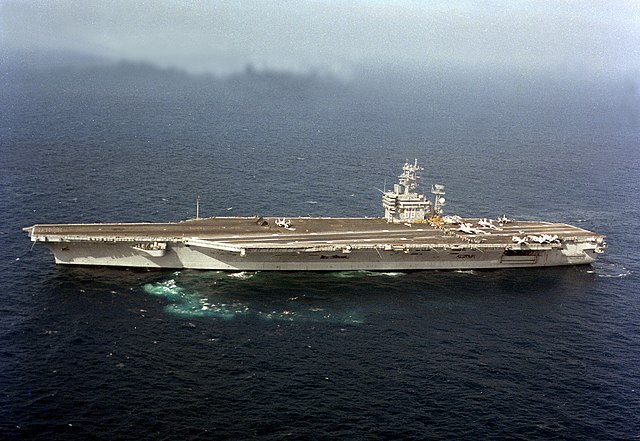
USS Nimitz in 1992
Books
Conway’s all the world’s fighting ships 1947-1995
Fontenoy, Paul E. (2006). Aircraft carriers: an illustrated history of their impact
Jim Wilson “21st Century Carrier Force” Popular Mechanics October 1998
Lambeth 2005, p. 89Lambeth, Benjamin (2005). American Carrier Air Power at the Dawn of a New Century. RAND Corporation
Pen and Sword: A Journalist’s Guide to Covering the Military. Portland, Oregon: Marion Street Press.
Tucker, Spencer, ed. (2010). The Encyclopedia of Middle East Wars: The United States in the Persian Gulf, Afghanistan, and Iraq Conflicts. ABC-CLIO.
Love, Robert William (1992). History of the U.S.Navy: 1942–1991 v. 2. Mechanicsburg, Pennsylvania: Stackpole Books.
Schank, John; Arena, Mark; Rushworth, Denis; Birkler, John; Chiesa, James (2003). Refueling and Complex Overhaul of the USS “Nimitz” RAND Corp
Friedman, Norman (1983). U.S. Aircraft Carriers: An Illustrated Design History. Annapolis, Maryland NIP
Labayle Couhat, Jean, ed. (1980). Combat Fleets of the World 1980/81: Their Ships, Aircraft, and Armament. NIP
Lambeth, Benjamin (2005). American Carrier Air Power at the Dawn of a New Century. Santa Monica, California: RAND Corporation
Polmar, Norman (2004). The Naval Institute Guide to the Ships and Aircraft of the U.S. Fleet. NIP
Stevens, Ted (1998). Navy Aircraft Carriers: Cost-effectiveness of Conventionally and Nuclear-powered Carriers: Report to Congressional Requesters. Washington, D.C.
Wertheim, Eric (2005). The Naval Institute Guide to Combat Fleets of the World, 2005–2006 NIP
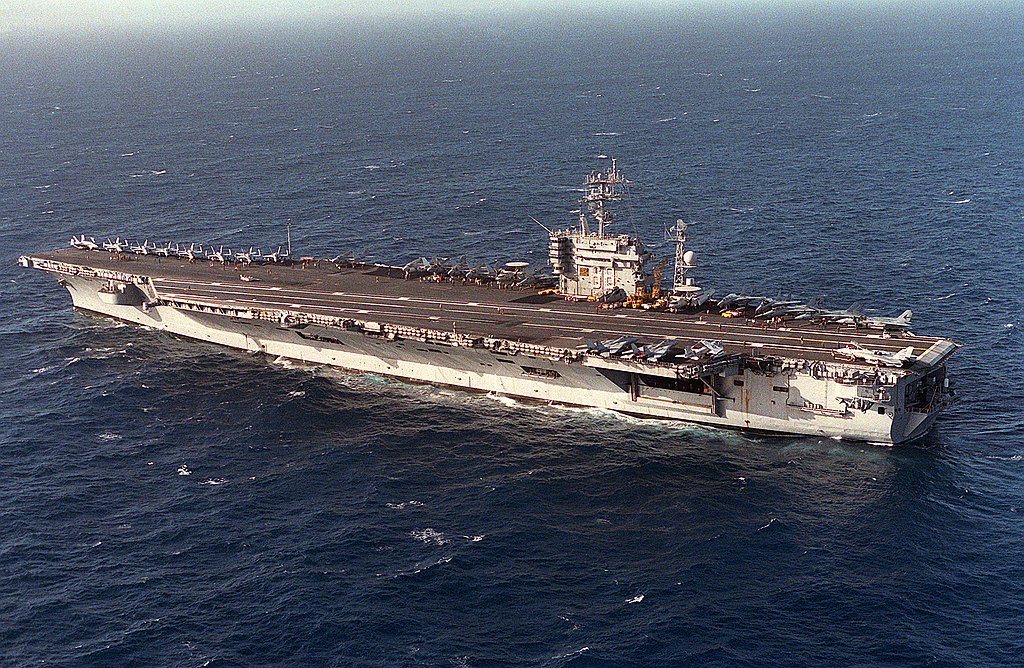
USS Nimitz in 1994
Links
navypedia.org nimit
navypedia.org theodore_roosevelt subclass
navypedia.org ronald_reagan subclass
seaforces.org Nimitz-class.htm
on naval-technology.com/
on en.wikipedia.org/
Gerald_R._Ford-class_aircraft_carrier
globalsecurity.org/ cvn-68-mods
quora.com most significant changes between the first and last nimitz class
on nvr.navy.mil/
An Alternate Method for the Determination of Aircraft Carrier Limiting Displacement for Strength, MIT
Navy CVN-21 Aircraft Carrier Program: Background and Issues for Congress
navyleague.org/ sea power
nationalcoldwarexhibition.org
CVNs on navy.mil/
fissilematerials.org/ about naval reactors
Replacing the nuclear core (pdf)
A solution to the inherent list on Nimitz class aircraft carriers
A Guide to the color-coded wardrobe on a U.S. Navy Flight Deck
web.archive.or history.navy.mil/ nimitz.html
sb.northropgrumman.com/ geraldr ford class facts
Speed Thrills III: Max speed of nuclear-powered aircraft carriers
Note: Hydrostatic and Stability curves provided apply to both carrier classes, Ford and Nimitz
News:
hinduonnet.com Nam and Nimitz
northropgrumman.com Construction of the Gerald Ford class
navy-develops-torpedo-killing-torpedo
leon.bet/blog/contribution/collaborations-defensetech/
Surface Ship Torpedo Defense (SSTD) System: Torpedo Warning System (TWS) and Countermeasure Anti-Torpedo (CAT)
The Navy Is Ripping Out Underperforming Anti-Torpedo Torpedoes From Its Supercarriers
Costing the CVN-21: A DID Primer
USS Nimitz Flight Deck
northropgrumman.com GW Bush design enhancements
timesofsandiego.com/ uss-carl-vinson-to-return-to-san-diego-following-year-and-a-half-overhaul/
CVN 70 Carl Vinson’s Mid-Life RCOH Refueling & Maintenance
Deployment: Deployed October 7 to the northern Arabian Sea. Returned to its home port on January 23, 2002.
Crew faulted in blaze on carrier 2008
news.usni.org/ navy-could-extend-the-oldest-nimitz-class-carriers-decision-in-next-budget
Nimitz Class Carriers Could Serve Longer Under New Shipbuilding Plan
Model Kits
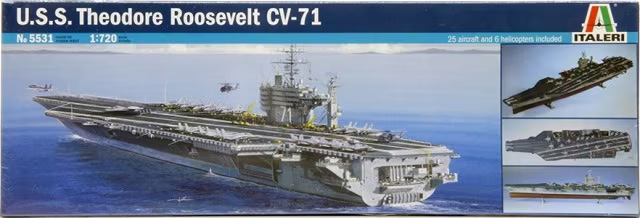
Italeri 1:700 USS Theodore Roosevelt. Only kit i made on the Nimitz class back in the days;
A popular subject to say the least. Most major manufacturers went on covering the Nimitz and Roosevelt sub-classes. It’s rarer for more recent carriers of the Reagan class. General query on scalemates.
One of the most appreciated is the Trumpeter 1:350 kit, which was republished in 2004 after new tooling. It enables a remarkable level of detail. However the master scale is still 1/700: Trumpeter again for the most, and Revell at 1:1200.
Books too: U.S.S. Abraham Lincoln by Barry D. Smith (1995), USS Nimitz CVN-68 America’s Supercarrier 1975 to Present by Sergio Santana in 2019, Nimitz-Class Aircraft Carriers Osprey Publications 174, New Vanguard No. 174 by Brad Elward in 2010, the Nimitz Class Aircraft Carriers by Squadron/Signal Publications 5606 and On Deck No. 5606 by Jim Goodall.
3D
USS George H.W. Bush CVN-77 Aircraft Carrier, could be sold by the author to 300 euros.

 Latest Facebook Entry -
Latest Facebook Entry -  X(Tweeter) Naval Encyclopedia's deck archive
X(Tweeter) Naval Encyclopedia's deck archive Instagram (@navalencyc)
Instagram (@navalencyc)





 French Navy
French Navy Royal Navy
Royal Navy Russian Navy
Russian Navy Armada Espanola
Armada Espanola Austrian Navy
Austrian Navy K.u.K. Kriegsmarine
K.u.K. Kriegsmarine Dansk Marine
Dansk Marine Nautiko Hellenon
Nautiko Hellenon Koninklije Marine 1870
Koninklije Marine 1870 Marinha do Brasil
Marinha do Brasil Osmanlı Donanması
Osmanlı Donanması Marina Do Peru
Marina Do Peru Marinha do Portugal
Marinha do Portugal Regia Marina 1870
Regia Marina 1870 Nihhon Kaigun 1870
Nihhon Kaigun 1870 Preußische Marine 1870
Preußische Marine 1870 Russkiy Flot 1870
Russkiy Flot 1870 Svenska marinen
Svenska marinen Søværnet
Søværnet Union Navy
Union Navy Confederate Navy
Confederate Navy Armada de Argentina
Armada de Argentina Imperial Chinese Navy
Imperial Chinese Navy Marinha do Portugal
Marinha do Portugal Mexico
Mexico Kaiserliche Marine
Kaiserliche Marine 1898 US Navy
1898 US Navy Sovietskiy Flot
Sovietskiy Flot Royal Canadian Navy
Royal Canadian Navy Royal Australian Navy
Royal Australian Navy RNZN Fleet
RNZN Fleet Chinese Navy 1937
Chinese Navy 1937 Kriegsmarine
Kriegsmarine Chilean Navy
Chilean Navy Danish Navy
Danish Navy Finnish Navy
Finnish Navy Hellenic Navy
Hellenic Navy Polish Navy
Polish Navy Romanian Navy
Romanian Navy Turkish Navy
Turkish Navy Royal Yugoslav Navy
Royal Yugoslav Navy Royal Thai Navy
Royal Thai Navy Minor Navies
Minor Navies Albania
Albania Austria
Austria Belgium
Belgium Columbia
Columbia Costa Rica
Costa Rica Cuba
Cuba Czechoslovakia
Czechoslovakia Dominican Republic
Dominican Republic Haiti
Haiti Hungary
Hungary Honduras
Honduras Estonia
Estonia Iceland
Iceland Eire
Eire Equador
Equador Iran
Iran Iraq
Iraq Latvia
Latvia Liberia
Liberia Lithuania
Lithuania Mandchukuo
Mandchukuo Morocco
Morocco Nicaragua
Nicaragua Persia
Persia San Salvador
San Salvador Sarawak
Sarawak Uruguay
Uruguay Venezuela
Venezuela Zanzibar
Zanzibar Warsaw Pact Navies
Warsaw Pact Navies Bulgaria
Bulgaria Hungary
Hungary

 Bundesmarine
Bundesmarine Dutch Navy
Dutch Navy Hellenic Navy
Hellenic Navy Marina Militare
Marina Militare Yugoslav Navy
Yugoslav Navy Chinese Navy
Chinese Navy Indian Navy
Indian Navy Indonesian Navy
Indonesian Navy JMSDF
JMSDF North Korean Navy
North Korean Navy Pakistani Navy
Pakistani Navy Philippines Navy
Philippines Navy ROKN
ROKN Rep. of Singapore Navy
Rep. of Singapore Navy Taiwanese Navy
Taiwanese Navy IDF Navy
IDF Navy Saudi Navy
Saudi Navy Royal New Zealand Navy
Royal New Zealand Navy Egyptian Navy
Egyptian Navy South African Navy
South African Navy






























 Ukrainian Navy
Ukrainian Navy dbodesign
dbodesign
I am working on a USS NIMITZ CVN 68 plastic model at 1:350 scale and when assembling the top hull and the lower part, I had to sand the joint and while doinh this action, I accidently eras the little parts just able the whater line and I need to re install these little part, but I dont know what they are called what are their function